Part One Of My Family Story. Marstrand, Sweden. The Soderbergs immigrate to Los Angeles, California from Sweden.
It is a rock. It is an island. Pre-historic man established abode here. Viking Age seafarers found the dual entrance deep harbor
much to their liking. The waters were rich with herring; and the herring made this Swedish west coast island rich. In
1658 Carlsten fortress was built atop the rock to protect the assets. Before yielding prominence to the towns of Kunglav and Goteborg, Marstrand was the hub of trade and commerce.
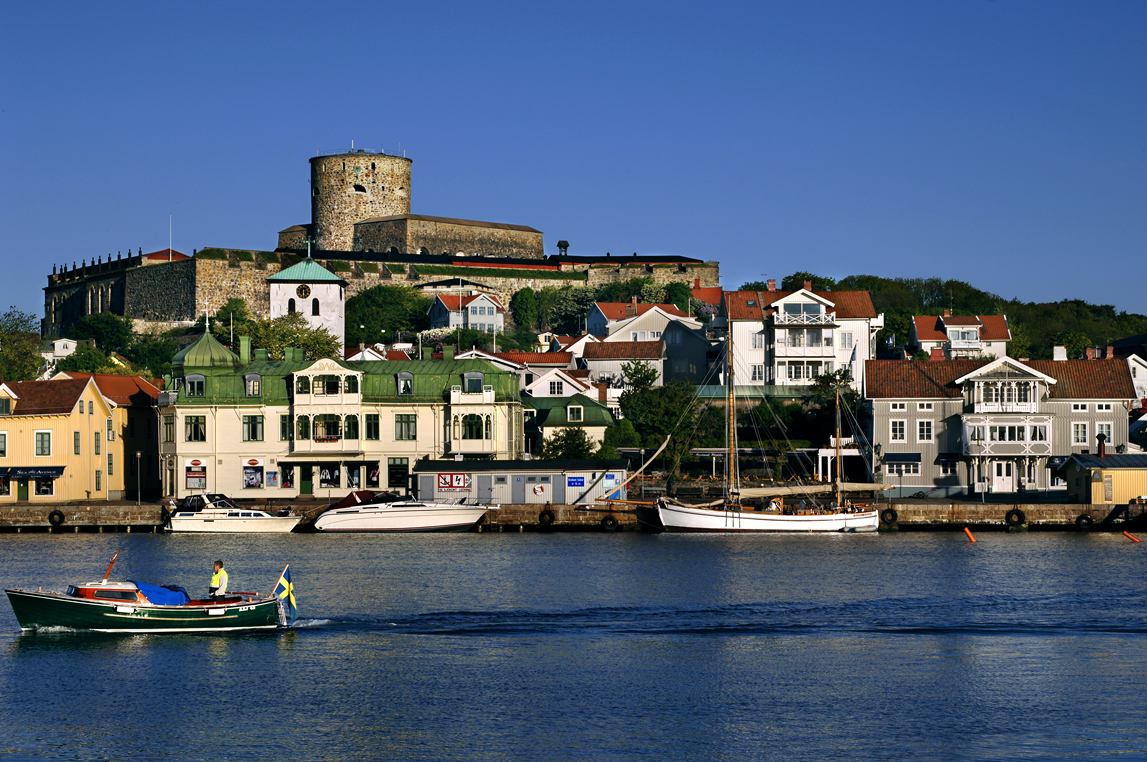
Then change. The Herring population declined. Modern roads, rails and communications largely by passed Marstrand. She had to reinvent herself.
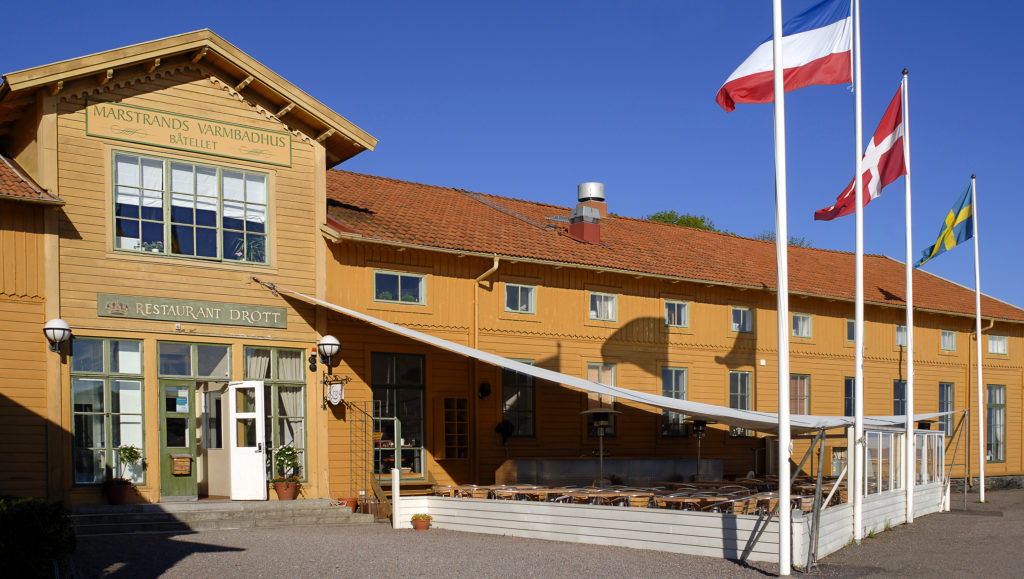
Marstrand’s Varmbadhus Batellet. 1856 began a new direction for Marstrand. People came to relax and enjoy the theraputic warm water baths. The Island’s ion rich air and water were also highly touted for health benefits.
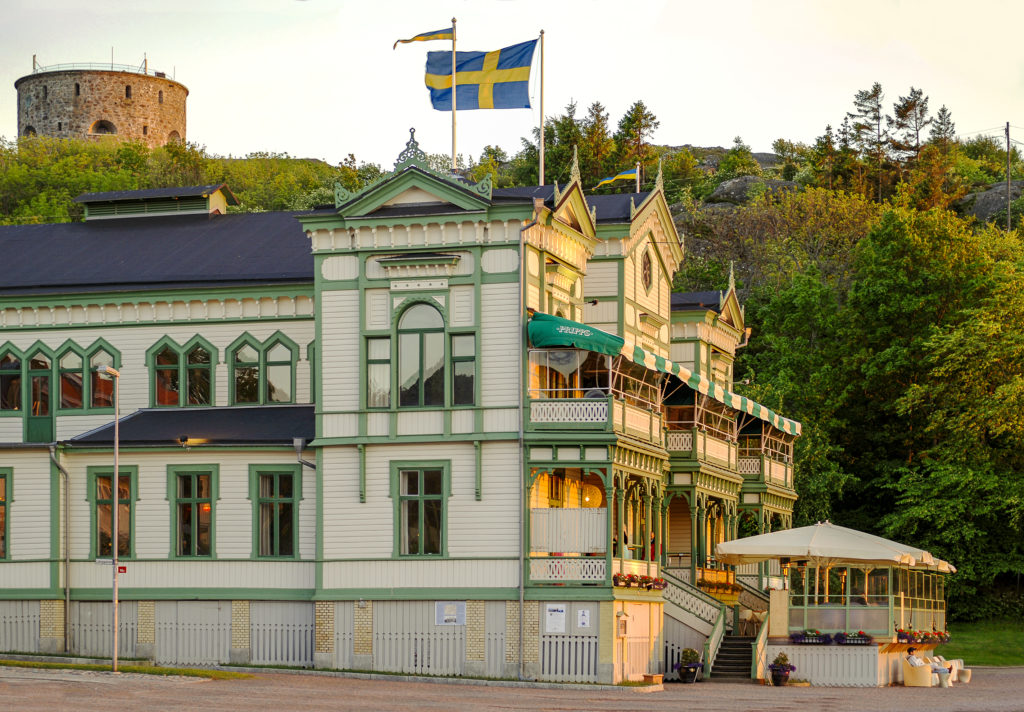
In 1887 Societetshuset was built. An invitation was extended to King Oscar II to visit and enjoy this beautiful social hall. To come and spend a summer in Marstrand. To bring his yacht. The King fell in love with Marstrand, as anyone might. He made it his annual summer destination.
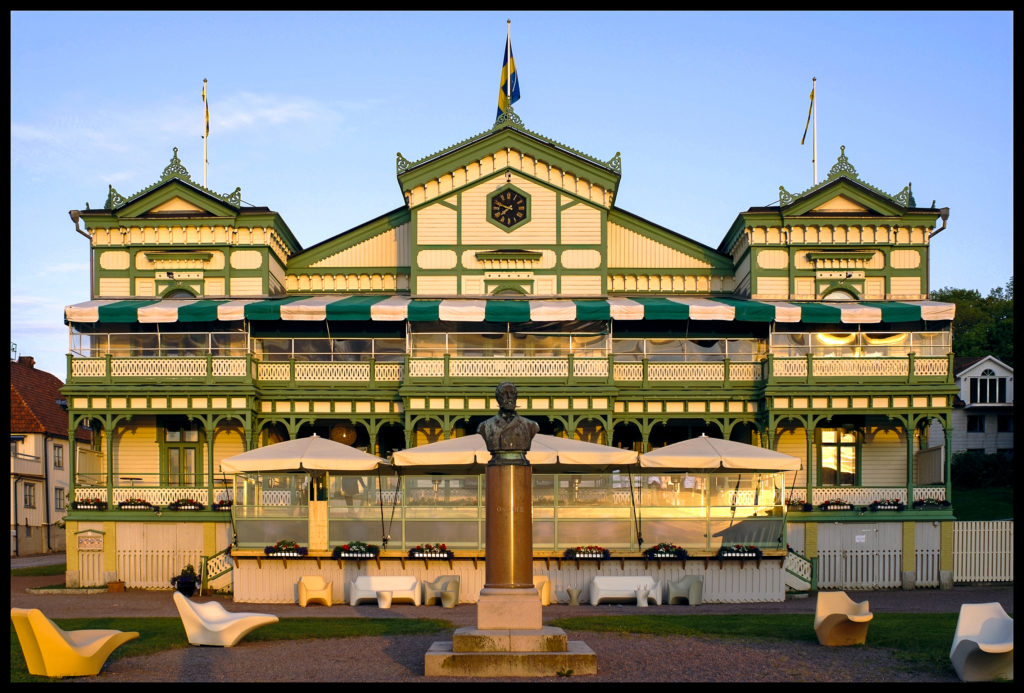
King Oscar (that’s his bust atop the post) brought with him a flush of new activity. Dances, receptions, concerts and evening entertainment became standard fare.
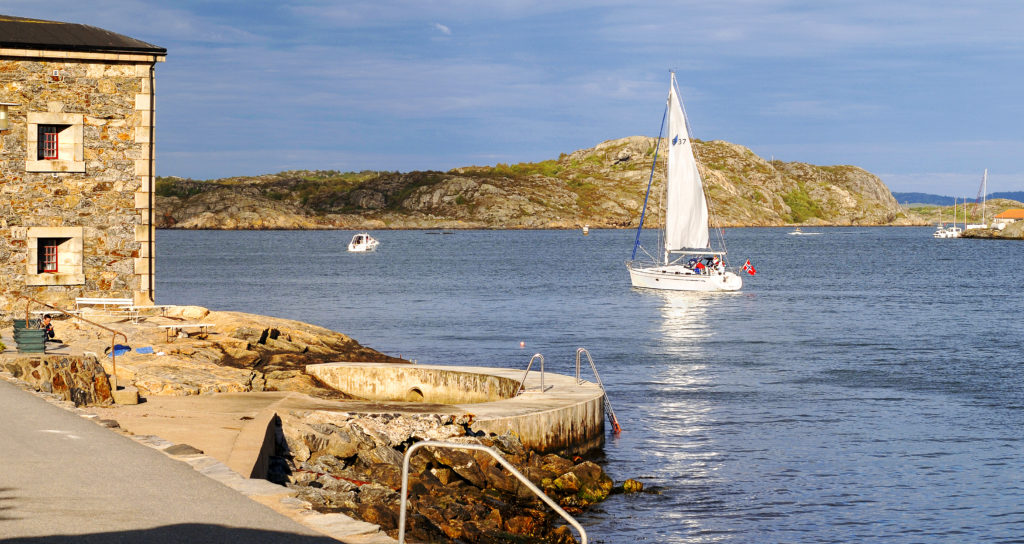
Cold water baths became part of the Marstrand “therapy.” Swimming, sunbathing, and hiking are also part of the resume. However its most famous attraction is sailing. During the summertime national and international sailing championships, as well as regattas, are held.
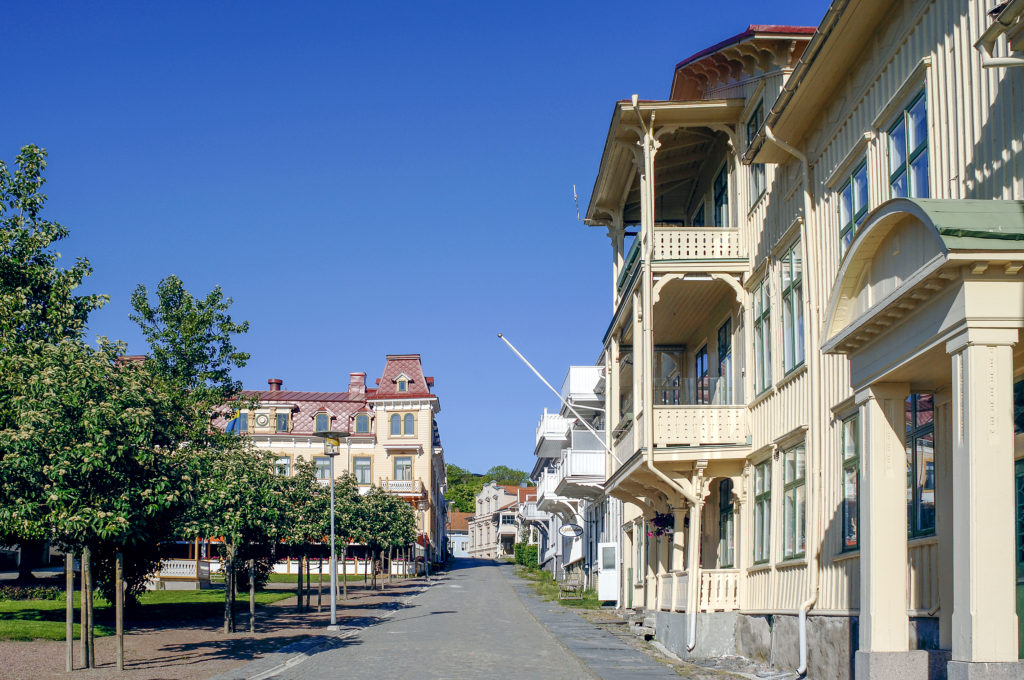
The city plot or grid dates back to medieval times. A fire or two rolled through from century to century. But the charming architecture seen today is largely from the late 19th and early 20th century. Quaint houses and beautiful structures line the narrow cobblestone streets. No cars or traffic here. It is pedestrian heaven. Grand Hotel is on the left. City Hall is straight ahead at the top of the street.
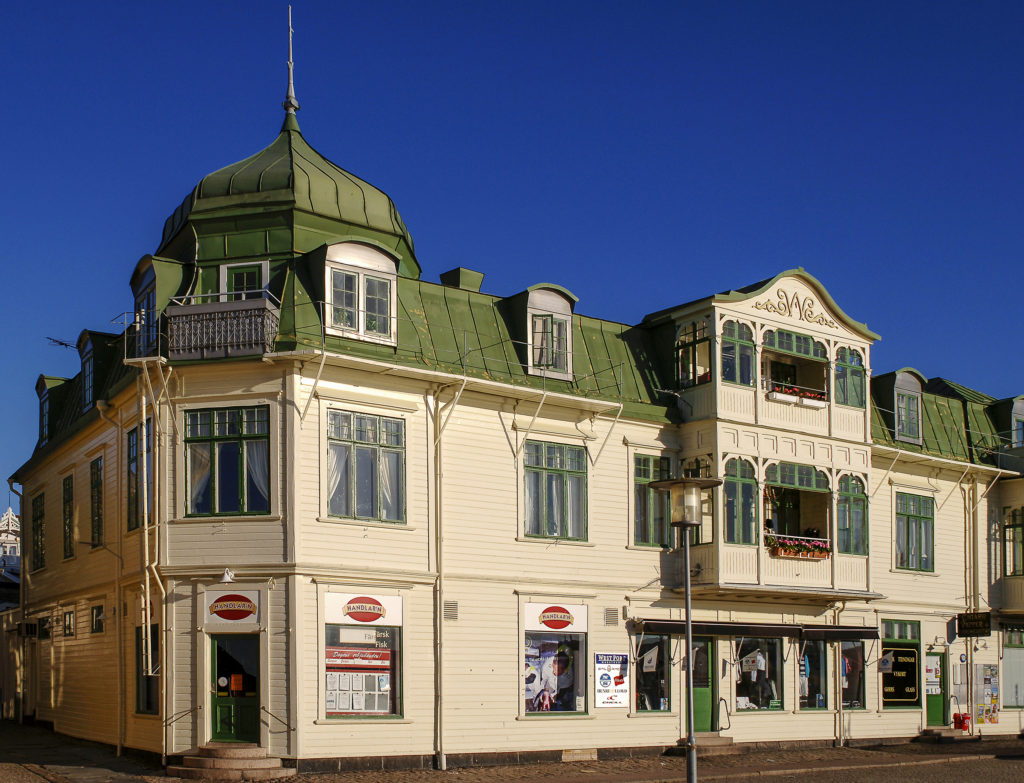
The Island is one mile in diameter. You arrive via ferry; the ride lasts only a couple of minutes. An array of fine shops and eateries are immediately accessible.
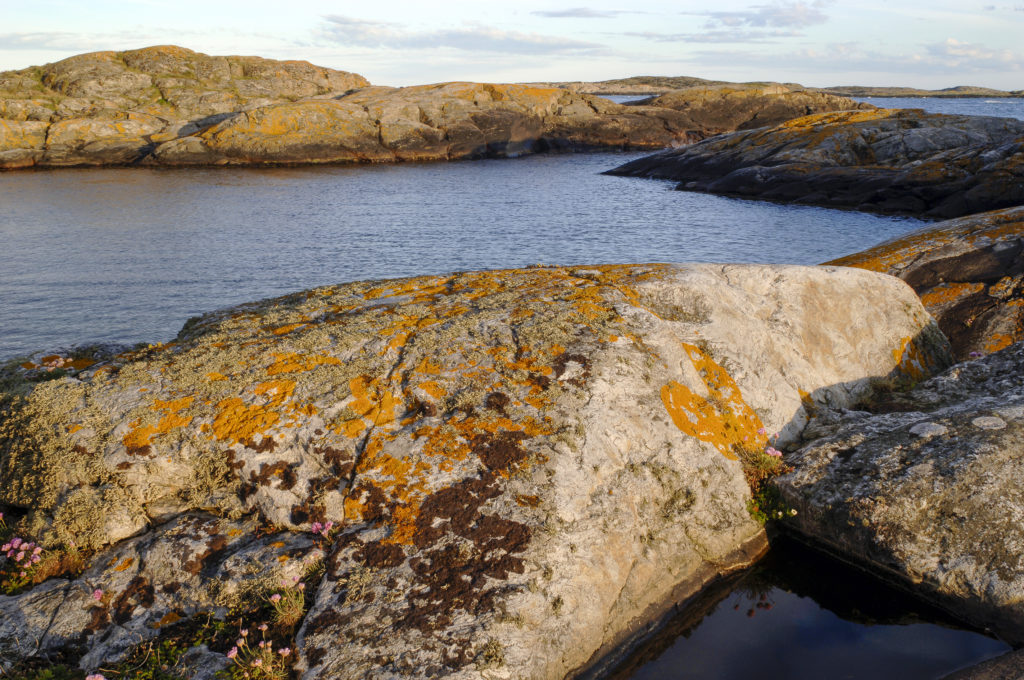
The western two thirds of the island is undeveloped. Tucked between the large smooth rocks and in all the cracks are beautiful rare maritime plants. The ocean and archipelago views are magnificent.
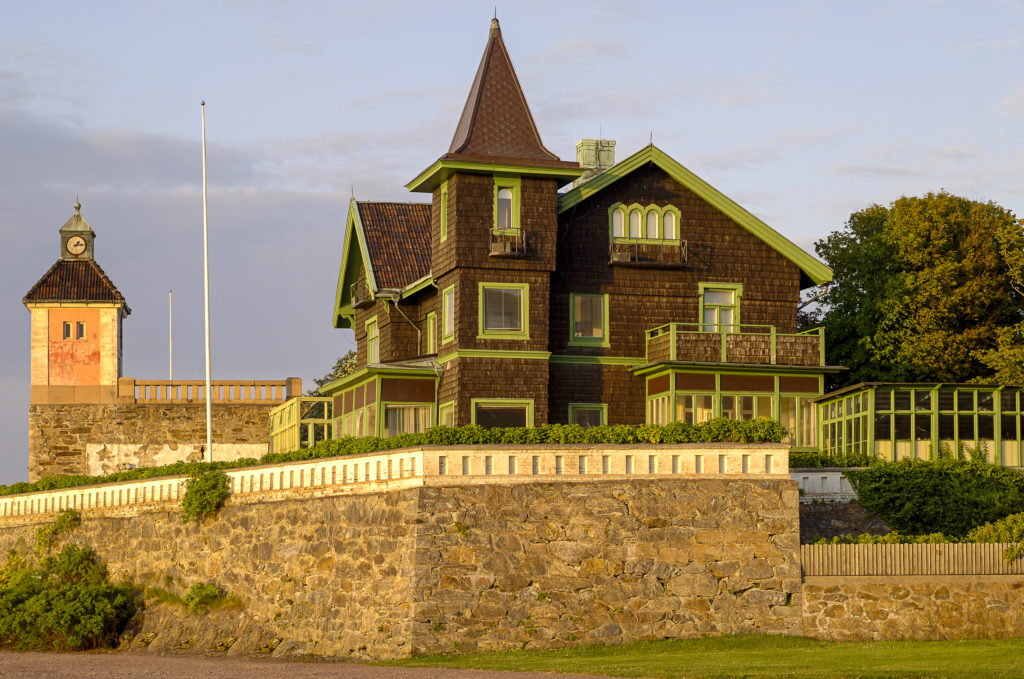
Each entrance to the harbor saw a fortified outpost (the structure on the left and the wall).
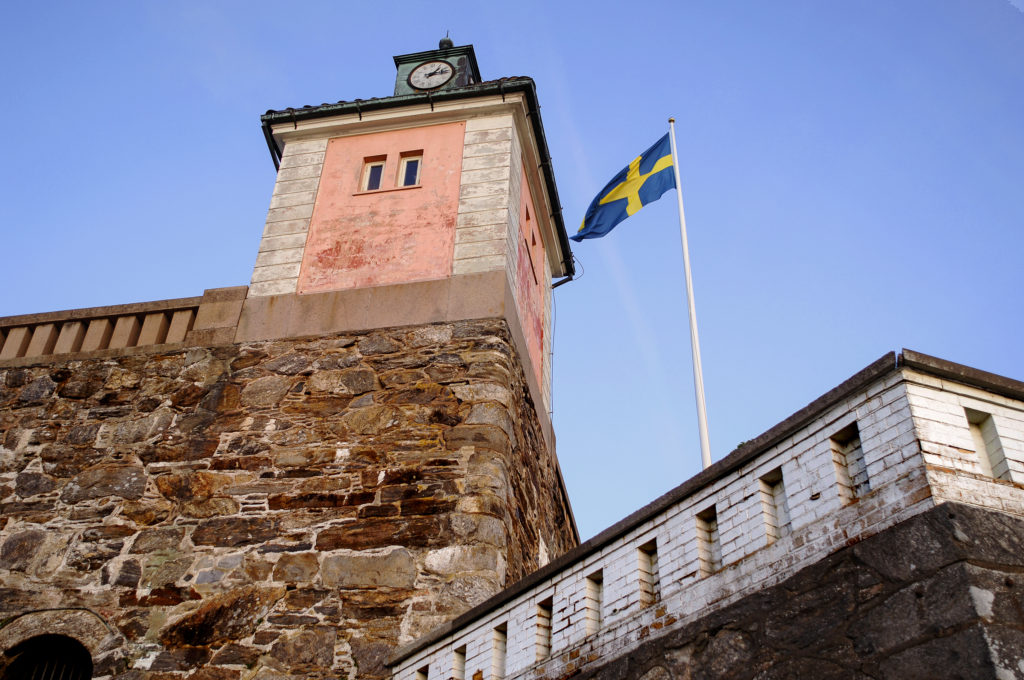
The vault of that structure was used in 1780 as a synagogue. The first in Scandinavia.
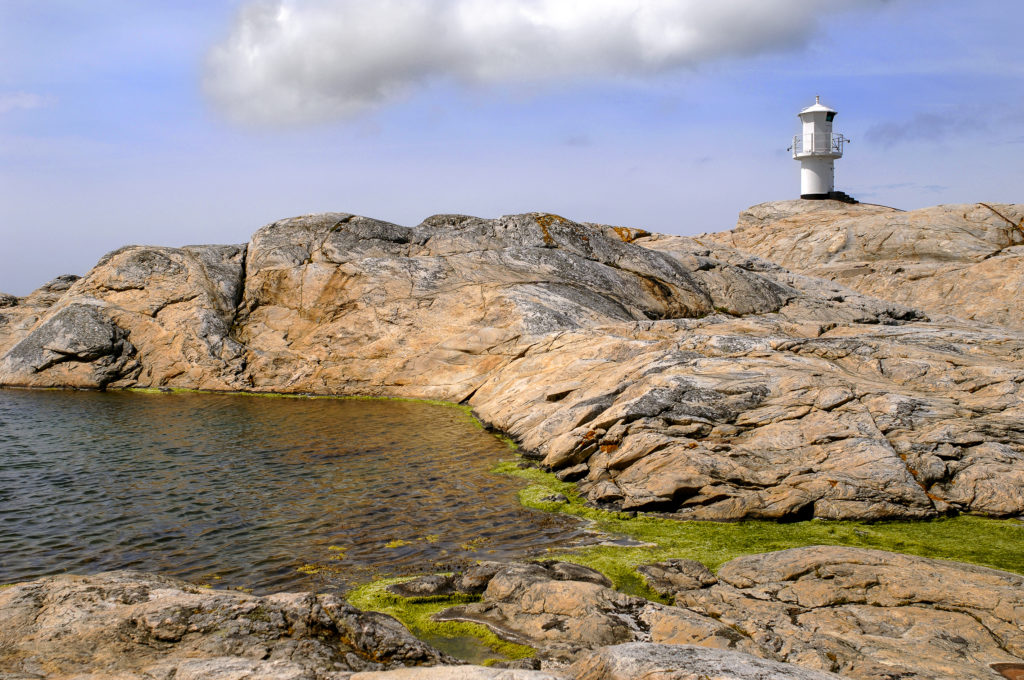
1783 brought the first revolving light installed a top Carlsten Castle. Today more compact versions guide ships to and fro Marstrand harbor.
There is another first to mention. Marstrand Electric was Sweden’s first municipal electric company.
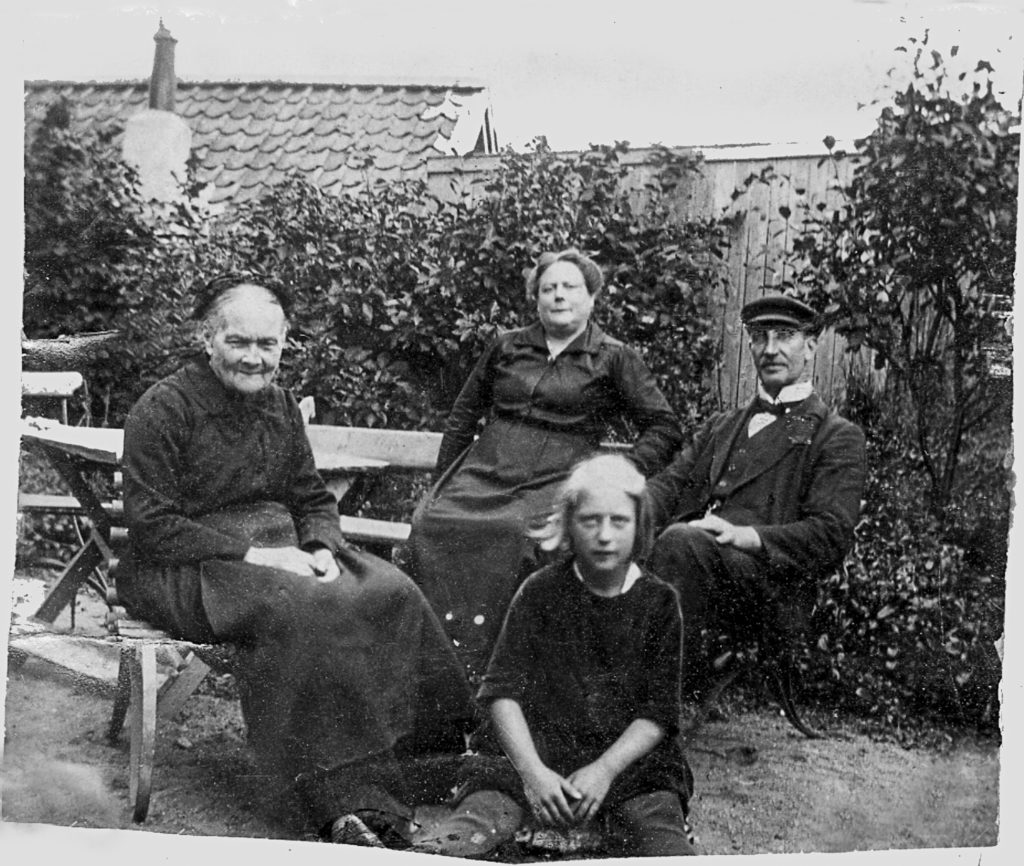
My great grandfather, (My father’s side of the family), August Palm–seated right–had lived in Malmo as an electrical engineer at a prominent hotel.
Apparently a fully wired Marstrand presented opportunity for August and his wife Alma (seated middle). He went to work for the electric company and bought a large two story house in Marstrand.
That’s my great great grandmother, seated left. But I’m not sure if she belongs to August or Alma (I think she’s Alma’s Mom). The girl is Margit, daughter of August and Alma. And my grandmother’s sister.
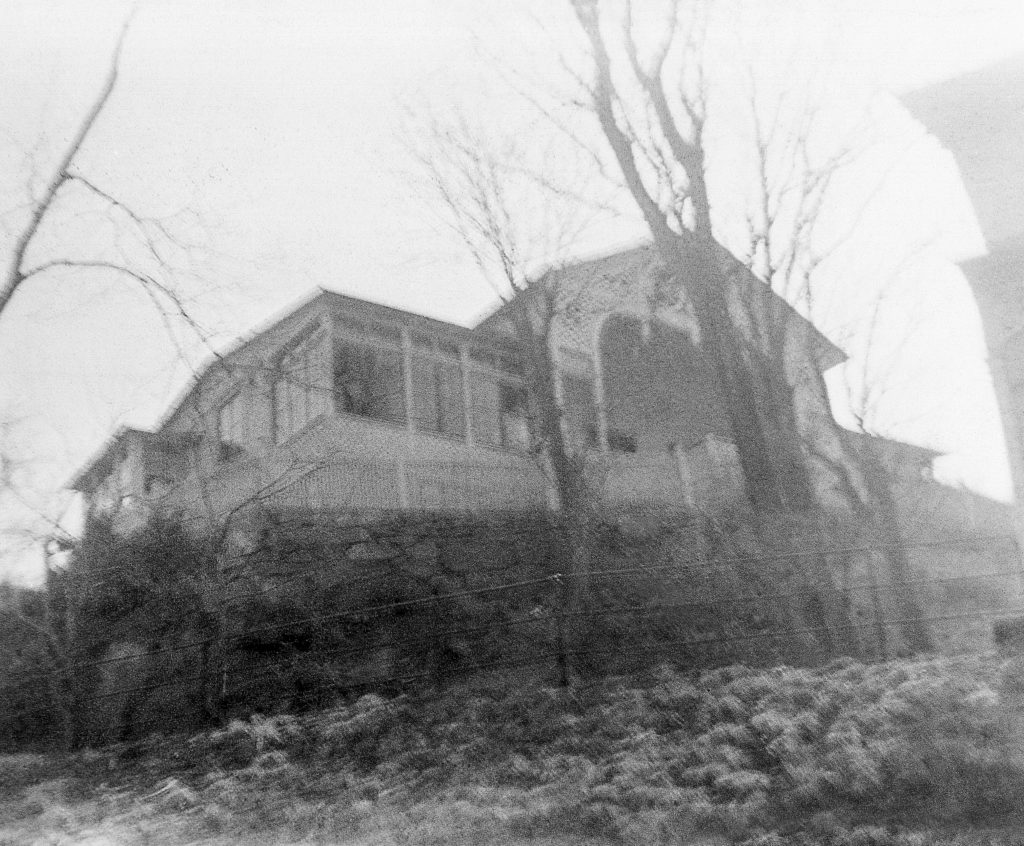
The house not only served as their residence, but as a functioning element of Marstrand’s tourist economy. What we call today a “bed and breakfast.”
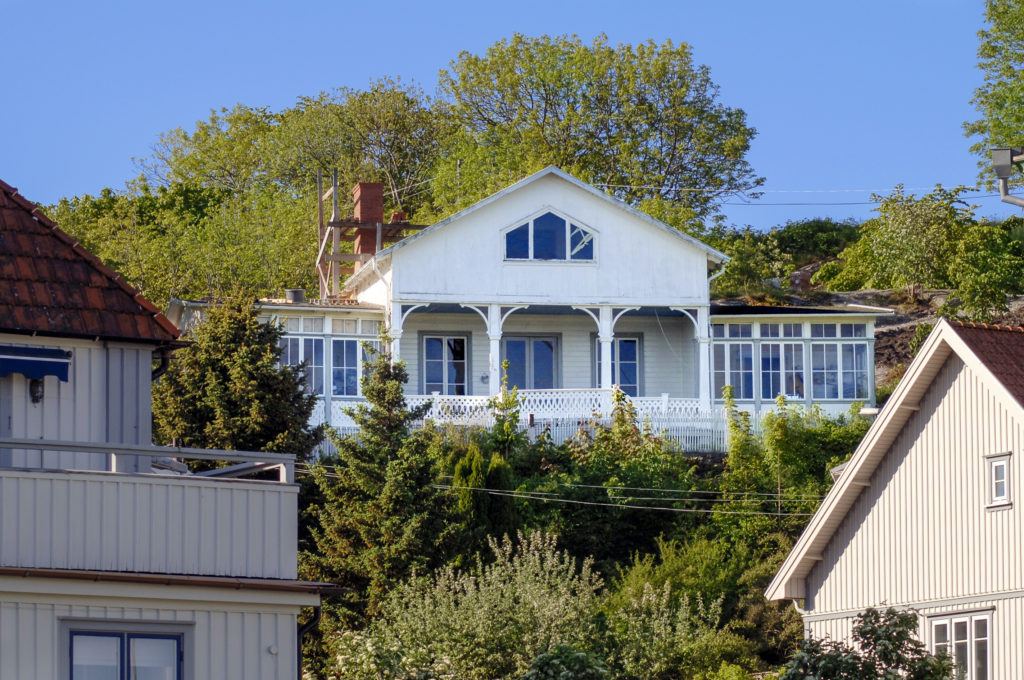
The former Palm residence today. Undergoing remodel work. As I captured this image a gentleman named Oskar asked about my interest in the house. I mentioned the name Palm, and that my grandmother Gunhild lived here as a teenager. Oskar moved to Marstrand in 1972. He said, “I once knew an owner of that house. I have been to many a party there. Some I remember. Some I never remembered, beginning next day.”
I mentioned Gunhild in her teens was known to have played tennis with The King, Gustav V, up at Carlsten’s Fortress.
“The king was a bit famous for that,” he said. “Young was his preference. Maybe check; you might have Royal Blood!”
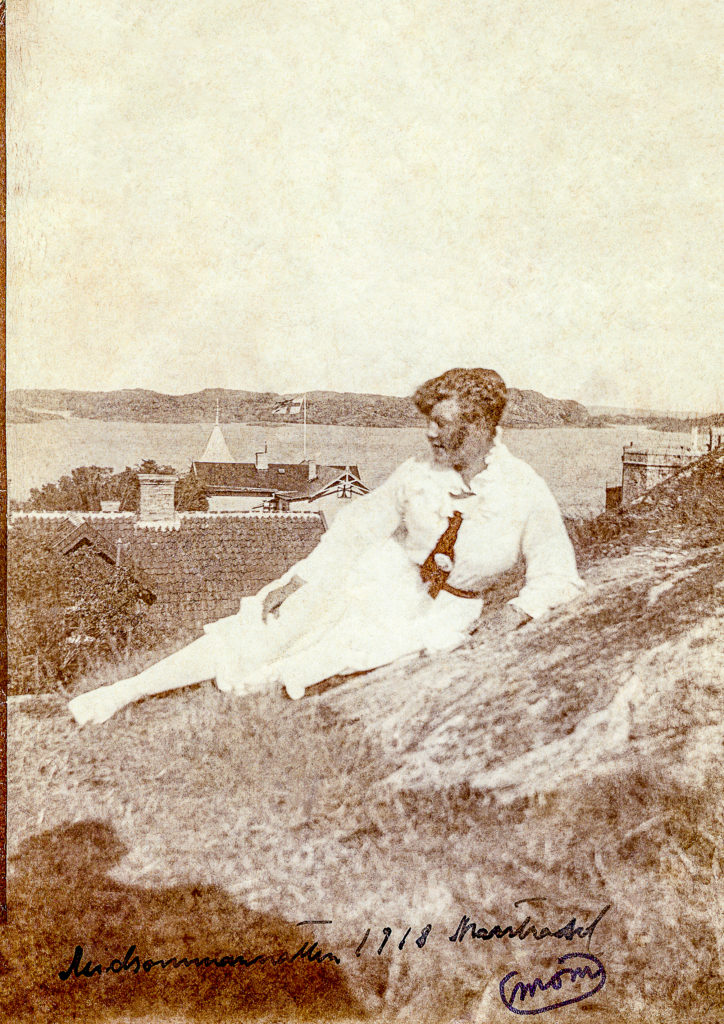
As Gunhild may have appeared after tennis with The King. As a child her nickname was Gulli, meaning gold, reference to her hair. This photo was taken Midsommer, 1918
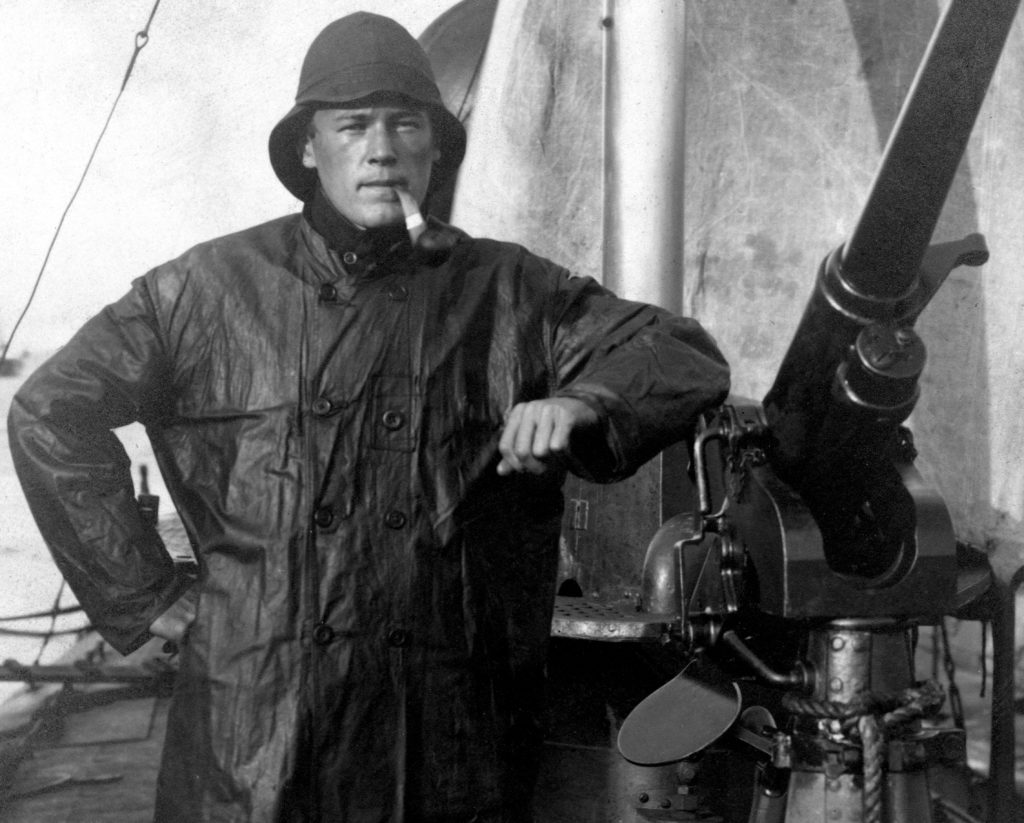
Gustav Soderberg, 1918. He’s standing a top a WWI Submarine. He served in the Swedish Navy.
Both Gustav Soderberg and Gunhild Palm were born in Malmo, Sweden. It is not known when or where they met.
However, writing on the back of the above photo indicates it was taken in Marstrand. In any event, they were married on November 15, 1919.
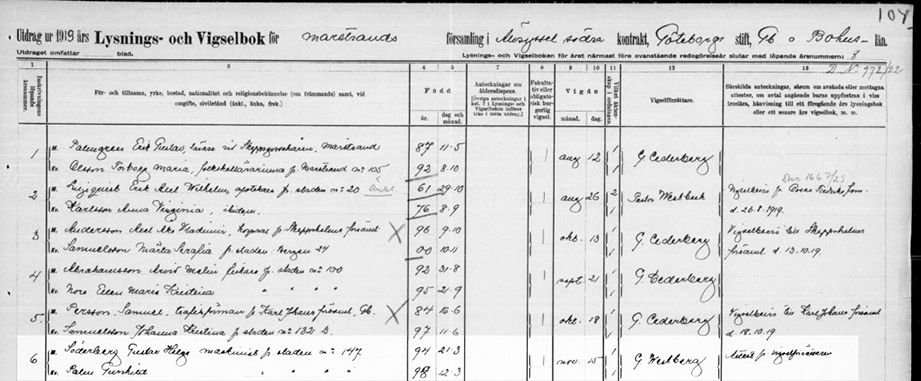
Marriage notice provided by Berit Hären,
Their son Bill Soderberg, my dad, was born September 6, 1920. The name Bill was chosen after Gunhild read a novel with a character named Bill. She apparently didn’t fully realize Bill is short for William.
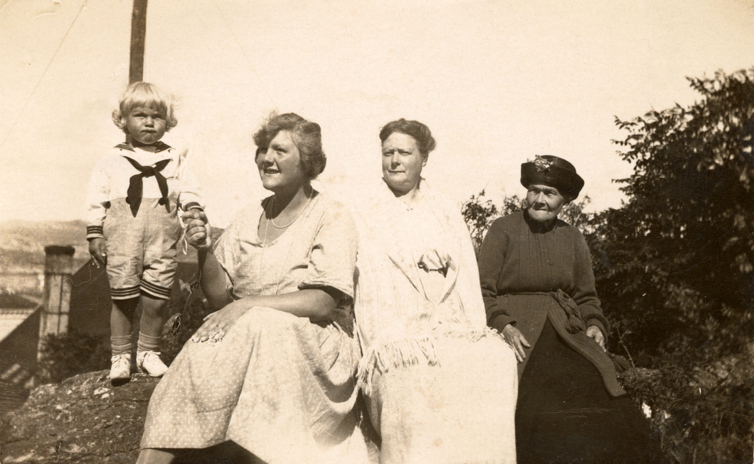
Bill in Marstrand. Gunhild, Alma and Bill’s great grandma.
Economic Times, worldwide–the 1920’s were difficult. Agriculture, coal mining, textiles, shoes, shipbuilding and railroads were all in decline. One factor in Sweden, among others then, it had an agrarian economy in the midst of a strong population growth. With so much of the country made of solid rock, agriculture was hard to expand. Young healthy Swede’s immigrated. In the later 19th and early 20th century 1.9 million Swedes immigrated to the U.S.
Swedes kept together upon moving to the U.S. Western Illinois, Iowa, central Texas, southern Minnesota, and western Wisconsin all sprouted sizable enclaves of Swedes. Some filtered to southern California.
We can only speculate why Gustav and Gunhild Soderberg chose Los Angeles. As a carpenter and house builder, perhaps he had read about the housing boom in Los Angeles. Perhaps her experience in Sweden with some musicals and stage productions, Gunhild may have felt the draw of Hollywood.
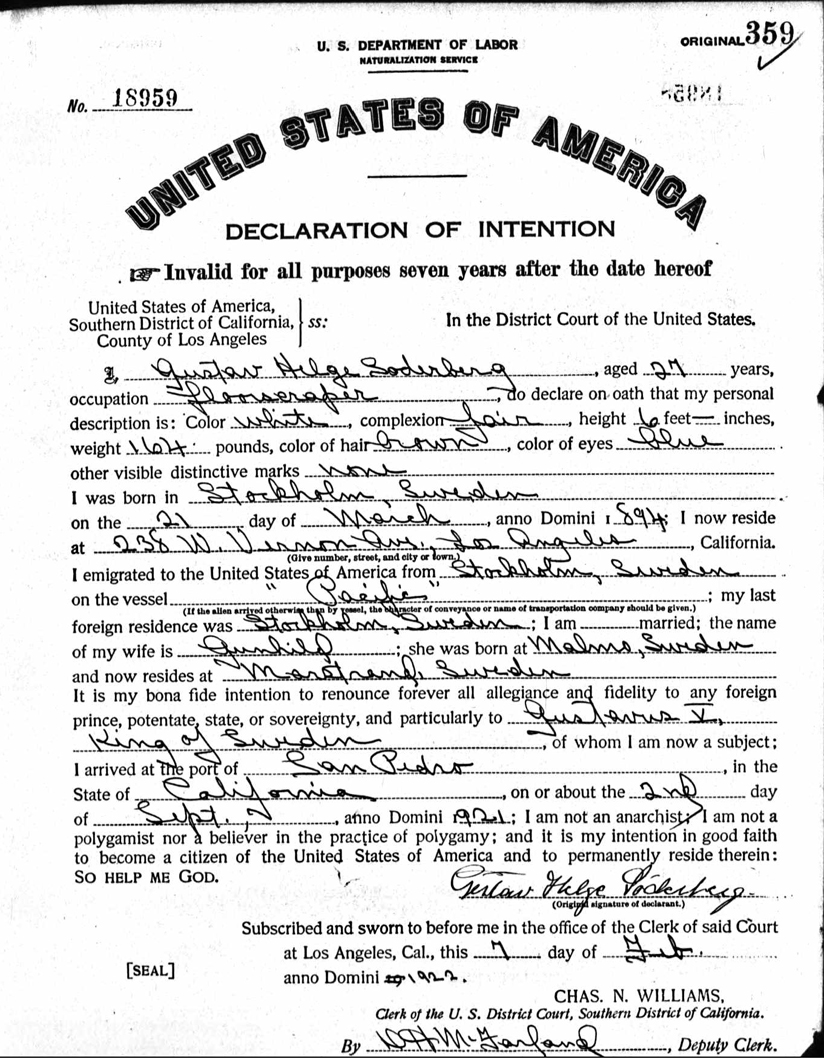
The choice may have simply been connected with where Gustav’s port of entry to the U.S. was. He came through San Pedro in Los Angeles on September 2, 1921. We knew Gustav came in advance of Gunhild and Bill. And it was assumed he came through Ellis Island, as the two had on done later on March 6, 1923. But where was the record? Swedish family member Nicklas Rydberg provided the missing document above.
Bill wrote: “We were pushed onto the streets of New York City, unable to speak the language. And no idea of where to catch the Greyhound Bus to Hollywood, California.
“My Dad had made the trip a year earlier to build a house for us to live in. When we arrived the framing of the house was up and I think it was ready for the roof. But we had to live in a tent, cook over a camp fire, and make do with an out-house.”
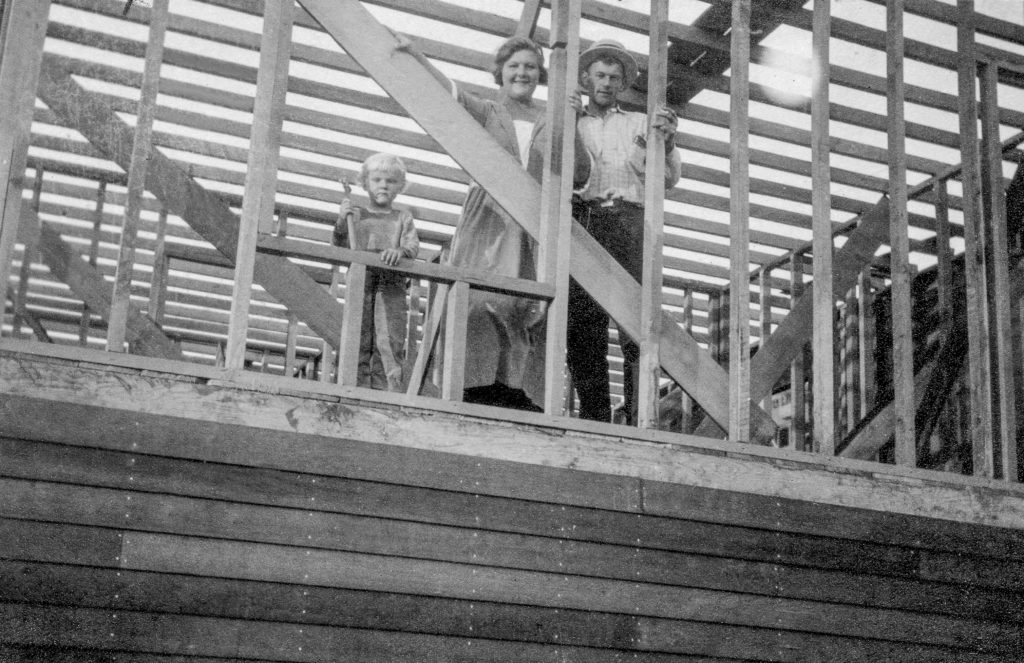
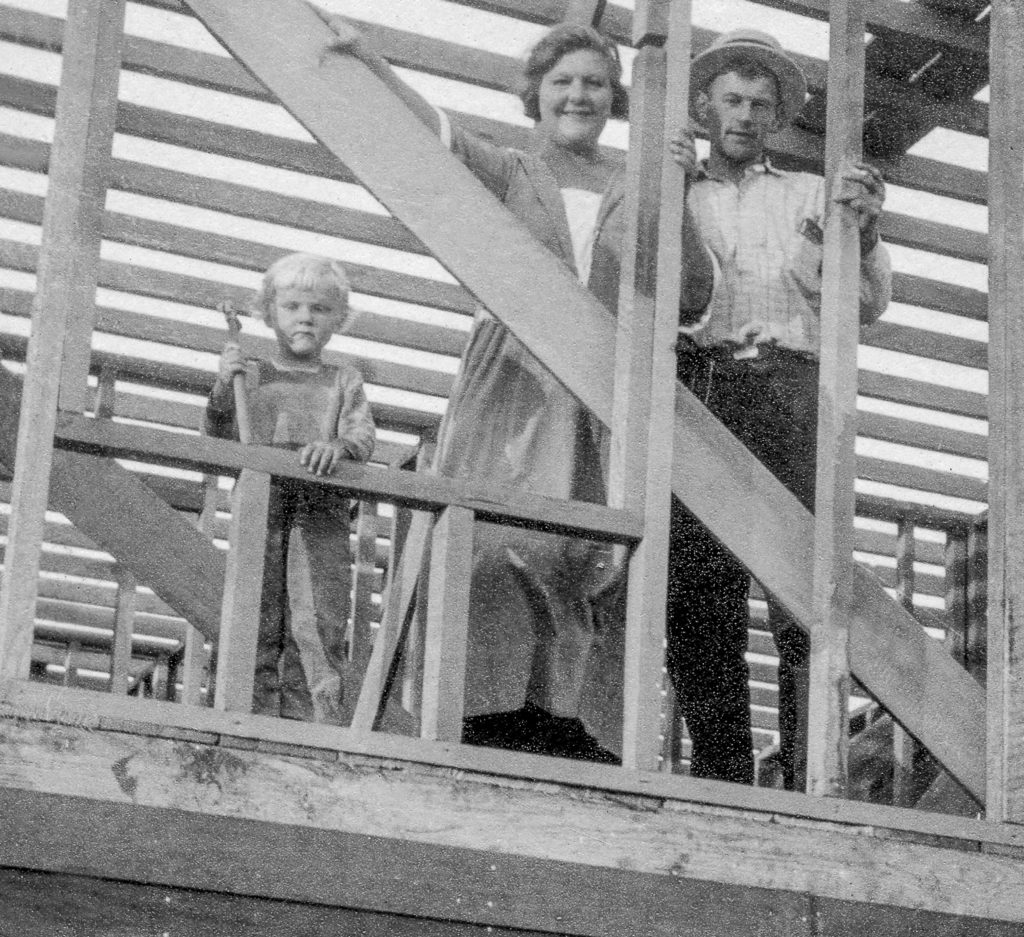
Youthful happy faces showing optimism for a life in their new country.
“My mother soon came down with typhoid fever and was in the hospital for what seemed like life time to me. Meanwhile I was sent to live with some long time friends, the Andersens–also from Sweden, while my Dad finished the house; and while my Mother recovered from the fever.
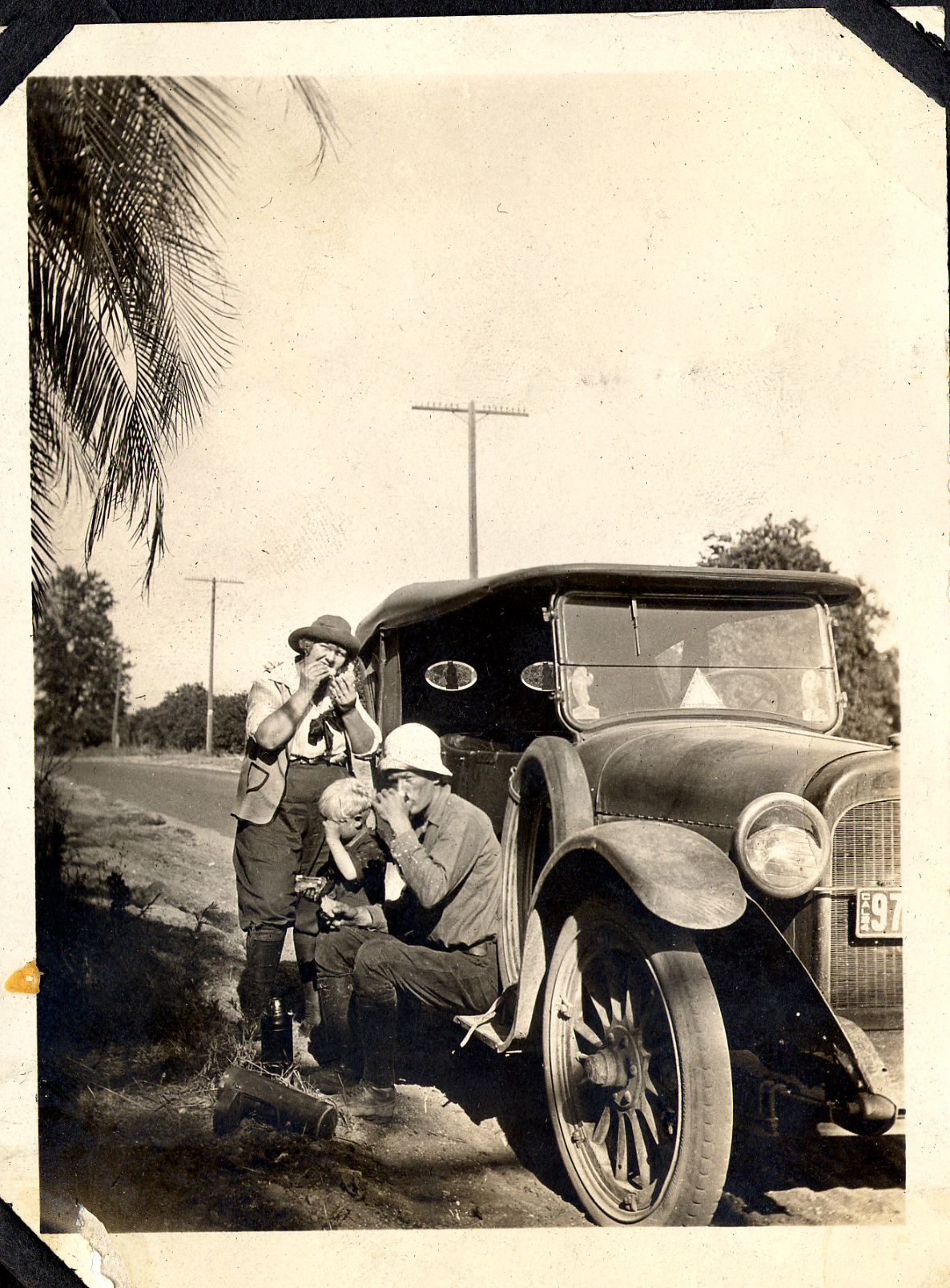
I don’t recall Bill ever mentioning a period of prosperity and well being during this early period of his life. However the history learned by Nicklas Rydberg in Sweden describes Gustav being proud of his professional accomplishments and financial achievements in the United States. “Gustav himself bragged about how well off he was and how much money he made. He owned a big and expensive car; a Bugatti.”
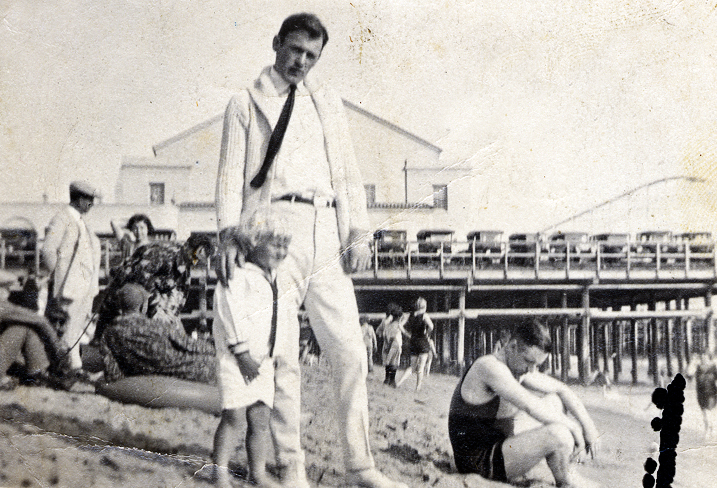
Gustav Soderberg and Bill. Well appointed beach attire, from head to toe.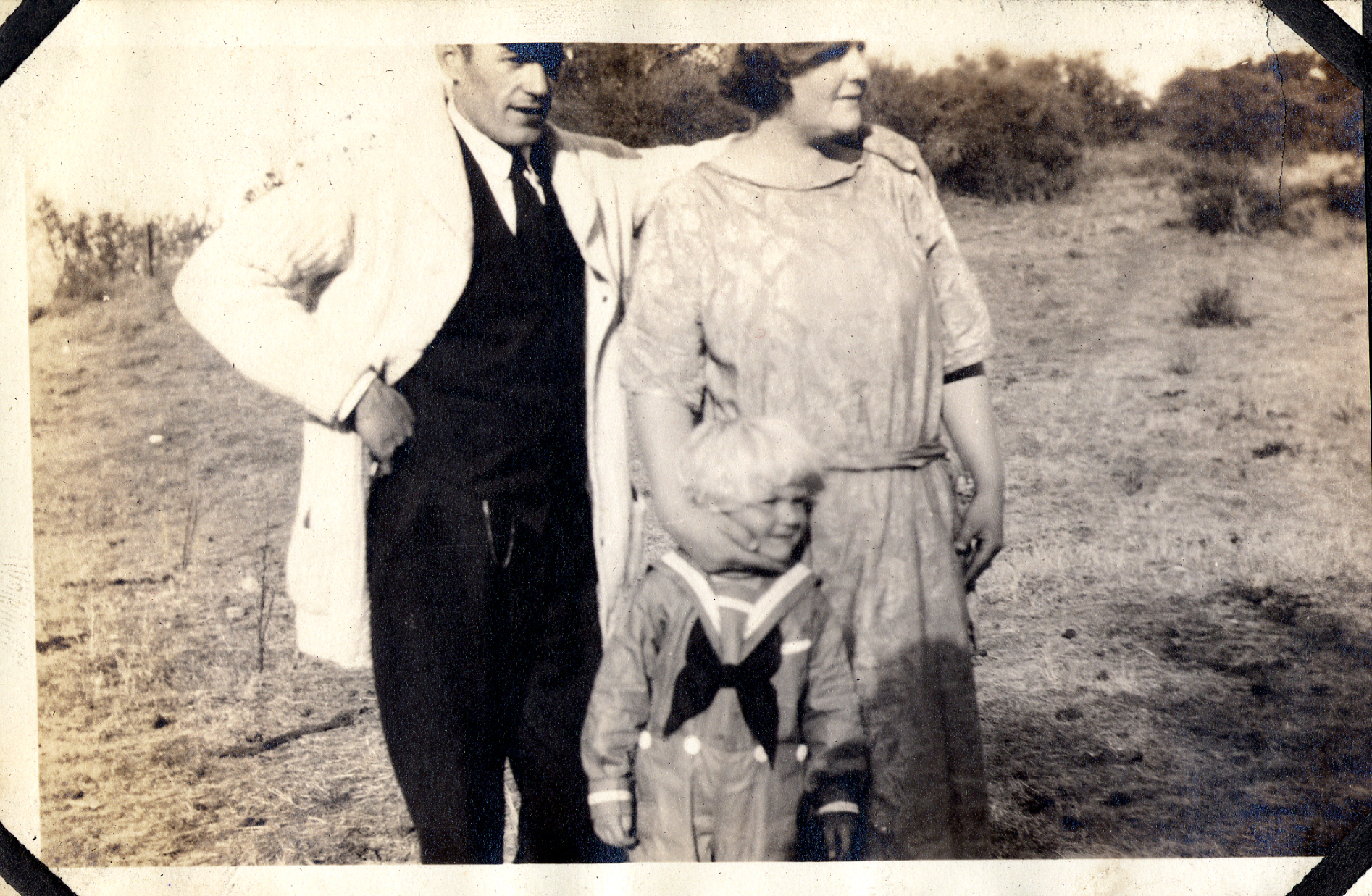
If there was no idea that Gustav drove a Bugatti, then this photo might not completely make sense. Gustav wearing a driving coat? Or simply the sweater seen in the previous photo. Either way nice clothes. Not cheap.
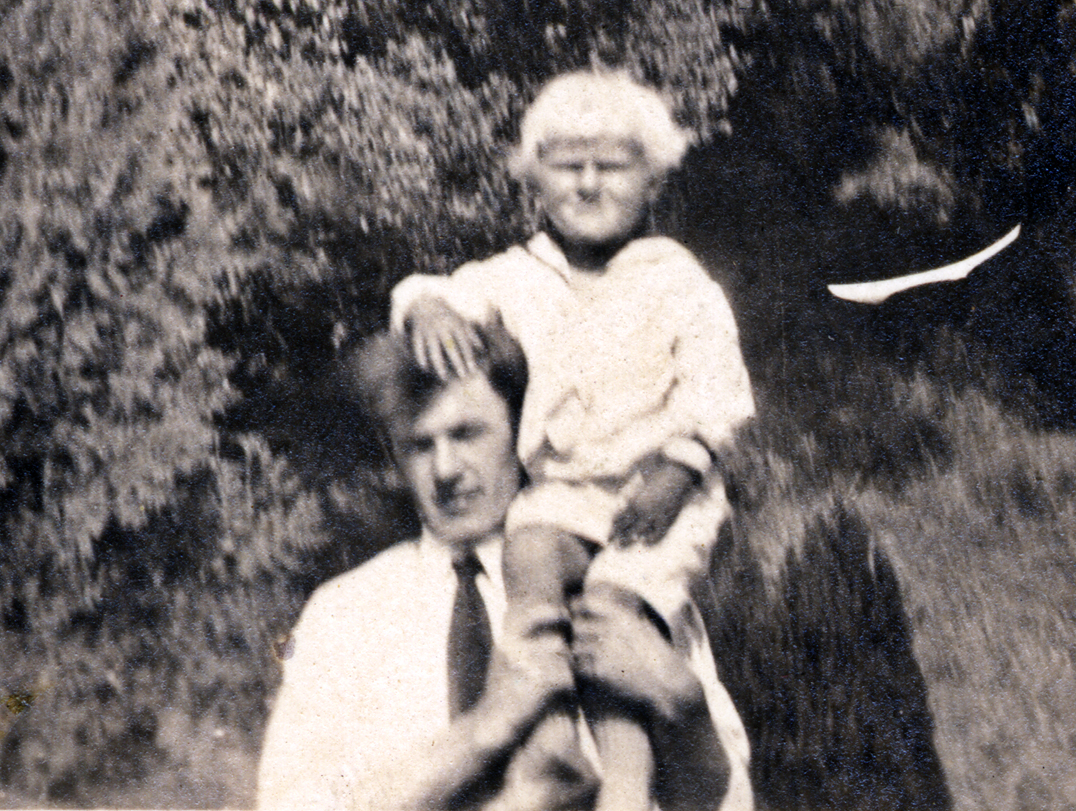
Gustav and Bill during happier times.
Bill wrote: “Swedish was spoken at home. Even by second grade, my English was still not very good–the kids all made fun of the way I talked.”
Bill was held back one grade until his language skills improved.
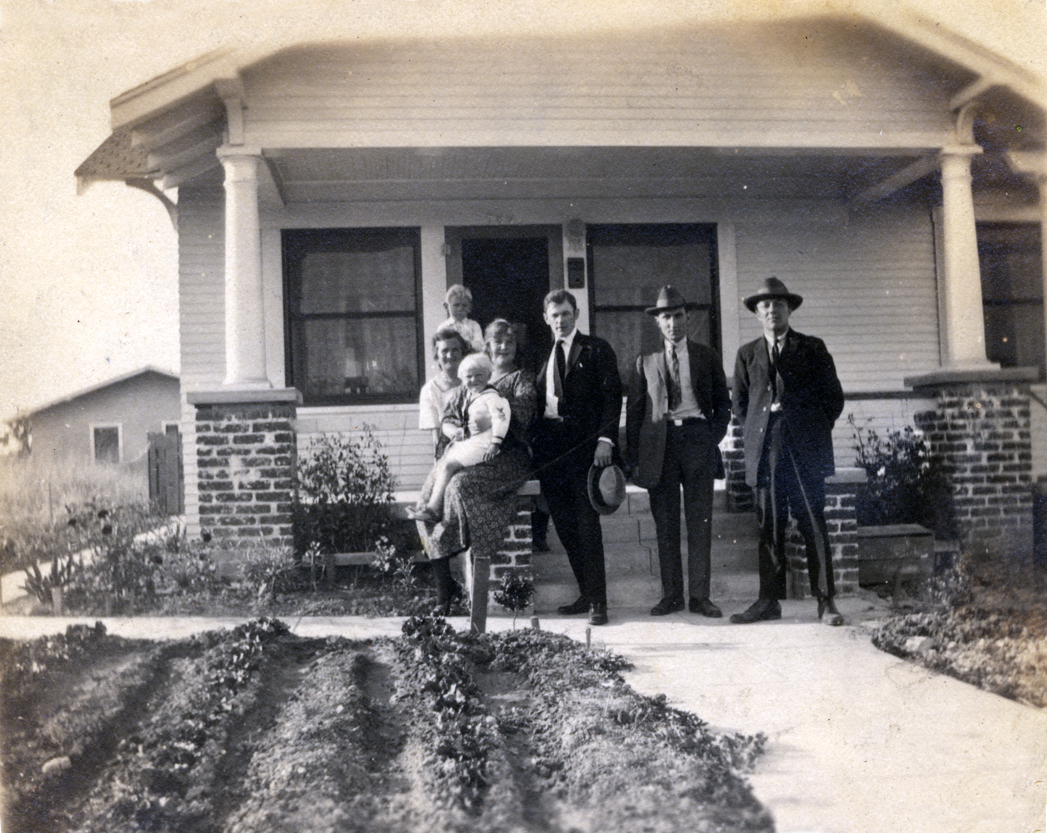
Further work needs to be done find the address of the house on Veteran and Olympic. This is possibly one of the homes Gustav built. A house number is slightly legible.
The family home Gustav built was on Veteran and Olympic Boulevards in West Los Angeles. Olympic Boulevard was originally 10th Street; the name changed in 1928 as Los Angeles was bidding for the Olympics which came in 1932.
Bill remembered playing in the middle of Pico Boulevard catching “horny toe lizards.” He said Olympic Boulevard was mostly waist-high weeds growing through cracks in the pavement.
Weeds growing on what is today a busy street may have said much about the worsening economy the young Soderbergs faced. 1926/1927 saw a sharp decline in construction. By the end of 1928 all construction came to a grinding halt. That amounted to $2 billion dollars no longer moving through the economy. Gustav wasn’t paid for his work. His own bills went unpaid. Gustav must have felt desperation. He proposed moving.
Gunhild was not receptive to that proposal. She had enough of moving and was not about to start over again.
“It was too hard getting into this country, and we’re not leaving.”
Bill wrote that the last time Bill heard from his father was via a birthday card sent from Brazil, 1927. He believed and said his father finally settled in Australia. Greta had also been told that Gustav went to Australia where he became a Communist and an alcoholic.
Two people with accurate information read this blog and have help correct the history presented. One is Berit Hären in Stockholm. She informed me that Gustav returned to Sweden. Gustav Helge and Gunhild were divorced through California divorce court on Nov. 10, 1932. (Bill was 12 years old). In 1935 Gustav Helge remarried to Magnhild Viktoria at Johannes parish, Stockholm in a civil service. Not known to Bill, he would have a half sister in Sweden, as well as Greta in the U.S.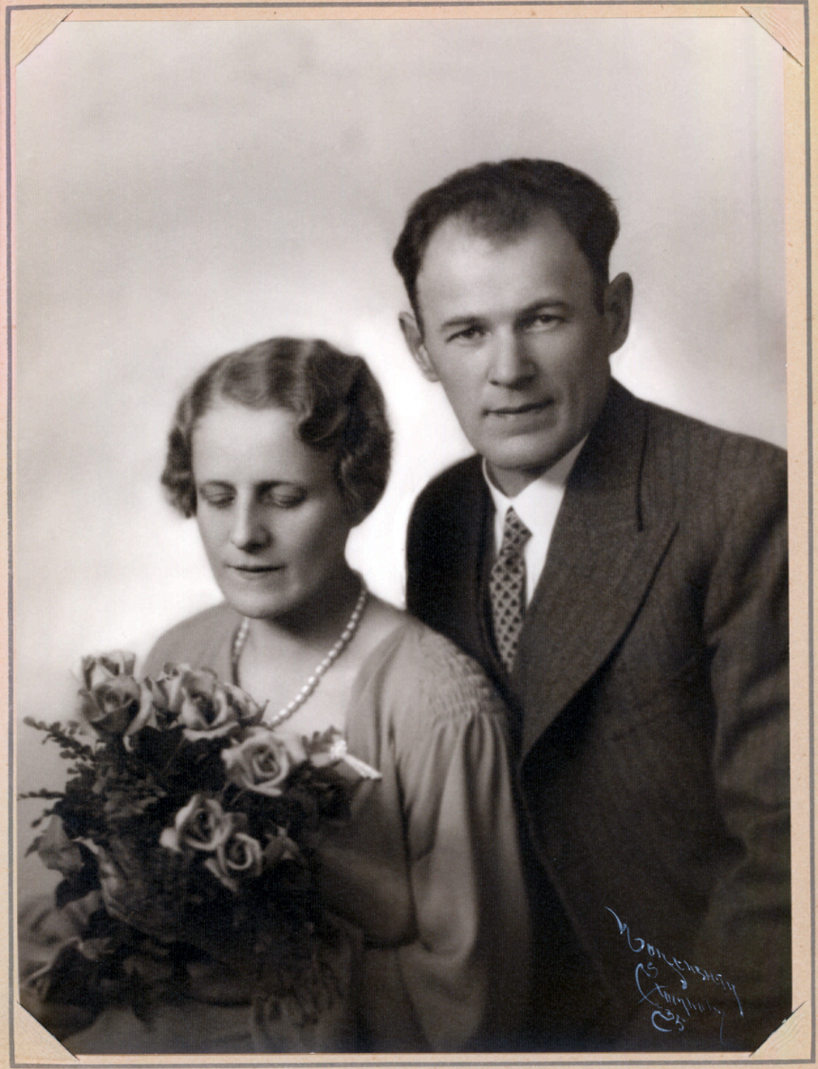
Other information and photos come from Gustav’s Swedish grandson Nicklas Rydberg (my newly found cousin) Nicklas described Gustav as a man with strident political beliefs, and he confirmed Gustav was indeed a devout Communist. “My mother confirmed,” he wrote, “my memory of stories of Gustav arguing his political views and making enemies on the way. My mother tells it was hard to grow up in small country society with a dad like that.”
But more about Gustav later. Back to the story in Los Angeles.
Gunhild and Bill were alone and had to abandon, and actually walk away from, their home in West Los Angeles. Bill often spoke of the long hike they made with their suitcases along weedy Olympic Boulevard to downtown Los Angeles as a homeless family.
A kindly group of women observed their plight. They opened their doors to shelter and care for them until Gunhild was able to fend for her herself. These kind people were a Madame and her Girls.
Part Two of My Family Story. The Swedish immigrants become Americans in Los Angeles. They received bad news from back home in Marstrand, Sweden.
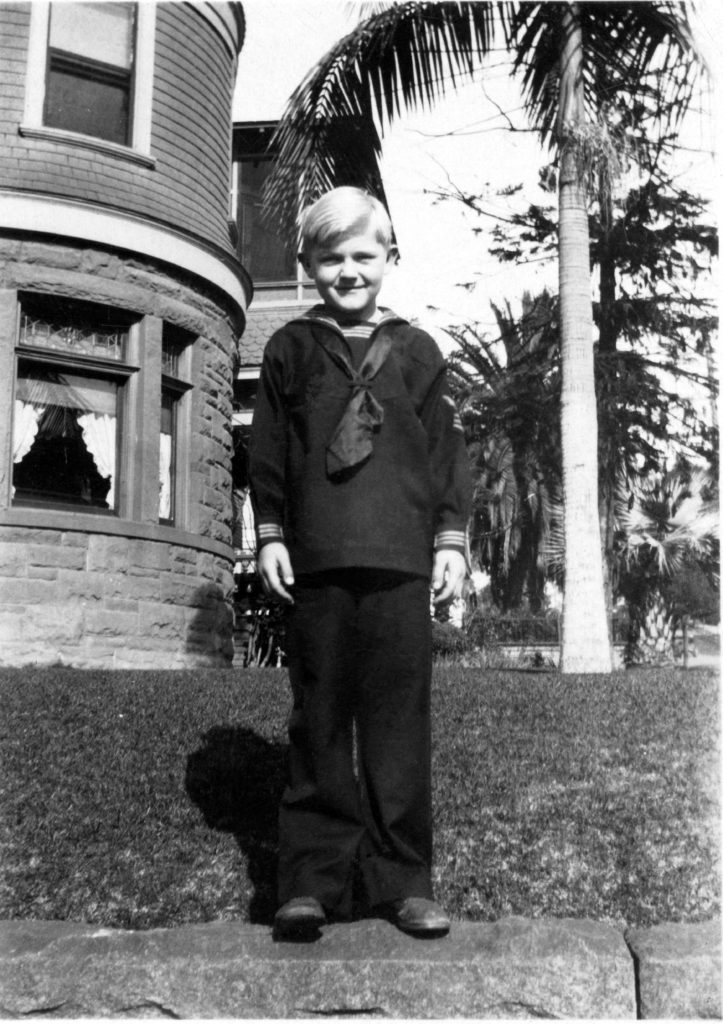
Bill Soderberg, late 1920’s, at Mrs. Burbidge’s Boarding House, Los Angeles
A date wasn’t given to this story. But it was at Mrs. Burbidge’s Boarding House on Ingraham Street and Union Avenue, Los Angeles. Late 1920’s Early 30’s.
Thanksgiving Day. The mouth watering aromas emanating from the kitchen were typical when Gunhild set to work with pots and pans. One may well suppose she already had a stint as an assistant boarding house cook in her mom’s kitchen back home in Marstrand, Sweden. One thing was for sure, when she worked her magic with a stove the results were delicious. Those who saw Gunhild cook say the process was seemingly chaotic. She moved in several directions simultaneously. In a Dervish Whirl she ruled with disorganized order.
That Thanksgiving there must have been numerous tasks she attended to as the turkey sat cooling on the open oven door. She failed to notice one hungry member of the house trot his way into the kitchen. Pointed his snout at the turkey and latched onto it with his jaws. This was a dog, a collie, named Buck. The canine heaved himself with the bird out the back door and beyond.
Upon her discovery of the theft, “Vat da HELL!”
Gunhild tore after that dog with vengeance. The cursing, yelping, rustling and commotion that was heard beyond the kitchen door was followed by her appearance at the threshold, fowl in tote. She wiped, cleaned, patched and massaged that bruised bird back into presentable condition. Upon placing it on a platter, best side showing, she told Bill not to say a word about this to anyone. All was successful. She had a talent for “making do,” and in this case snatched success from the canine jaws of disaster. “Vhere dere is a vill dere is a vay!” One of her sayings in a thick Swedish accent.
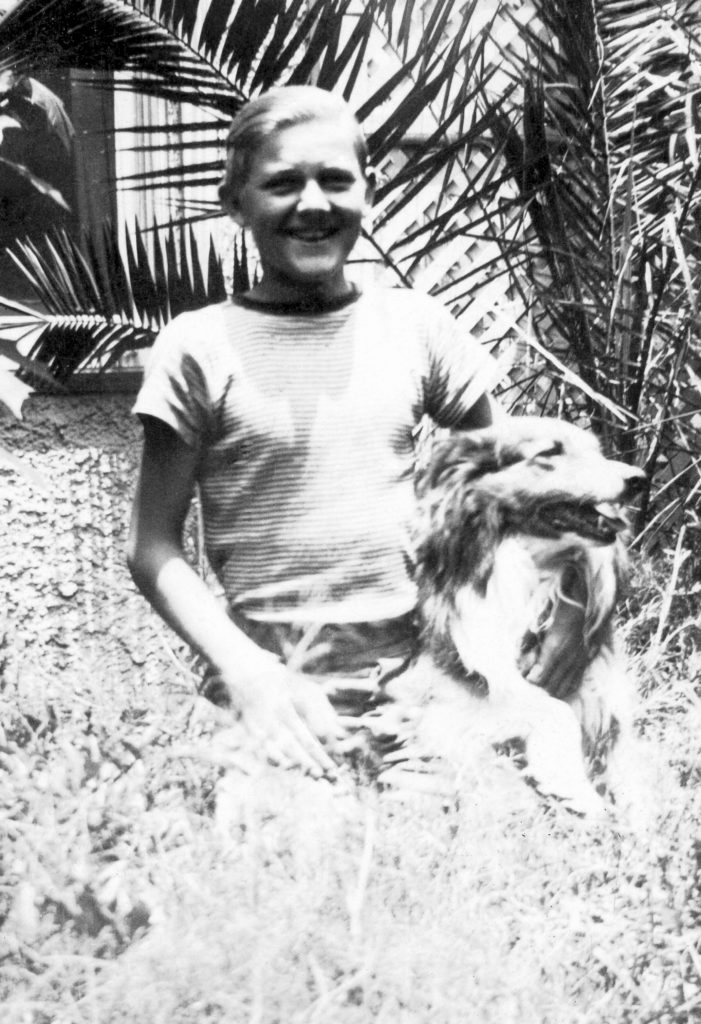
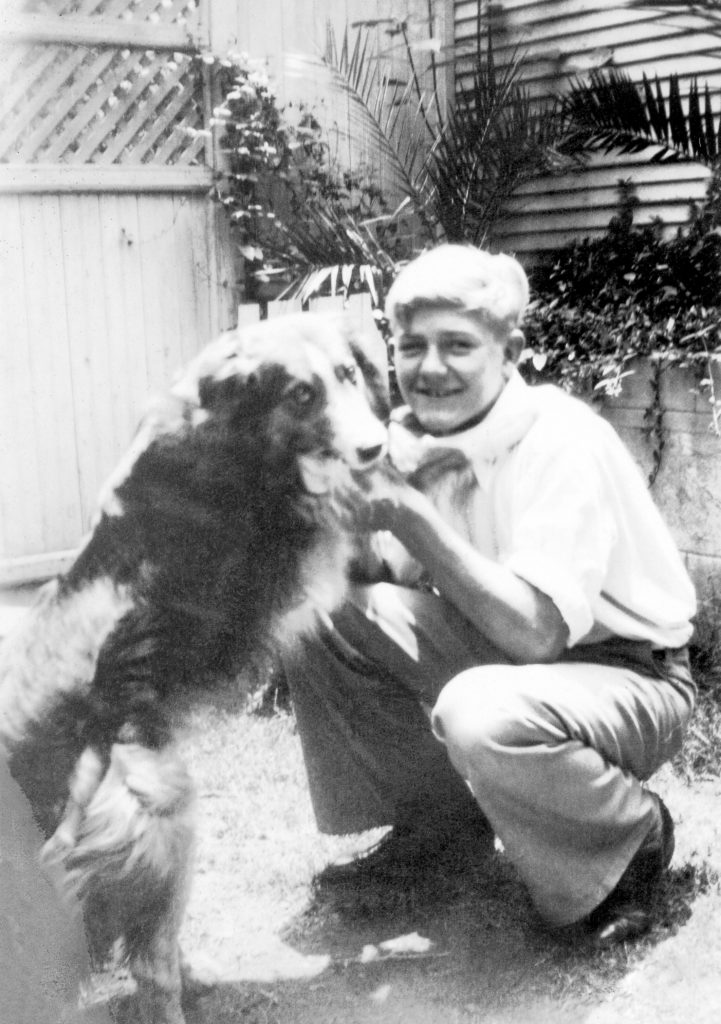
Bill began a working life at a young age. His friend from boyhood is Bob Beattie, age 87, recently told me “Bill sold newspapers on the corner of 7th and Union. His mother then worked at the Commodore Hotel, also on 7th and tried to keep an eye out for Bill.”
He learned the hard way to properly count money and make change. People took advantage of the young immigrant by taking from him more change than they paid. Then he had to fight other kids to keep his corner. Bullies that either stole his papers or his money. Or both.
One had to toughen up quickly to turn a profit with newspapers selling for a penny a piece. On a good day a cleared profit was 5 cents. During the leanest times of The Depression bean sandwiches were a common lunch. There’s probably very few Baby Boomers that haven’t heard the stories of this era. “Waste not, want not,” “Finish your plate, ” “You think you have it so tough…” etc.
“Bill and I met at the Cambria Street School. It was an old fashioned wooden school house. That was either in second or third grade, I don’t remember which. But I do remember Mrs. Finch held Bill back one grade because he still didn’t speak English very well. The kids really teased him about that especially when they heard him talk with his mother,” recalled Beattie.
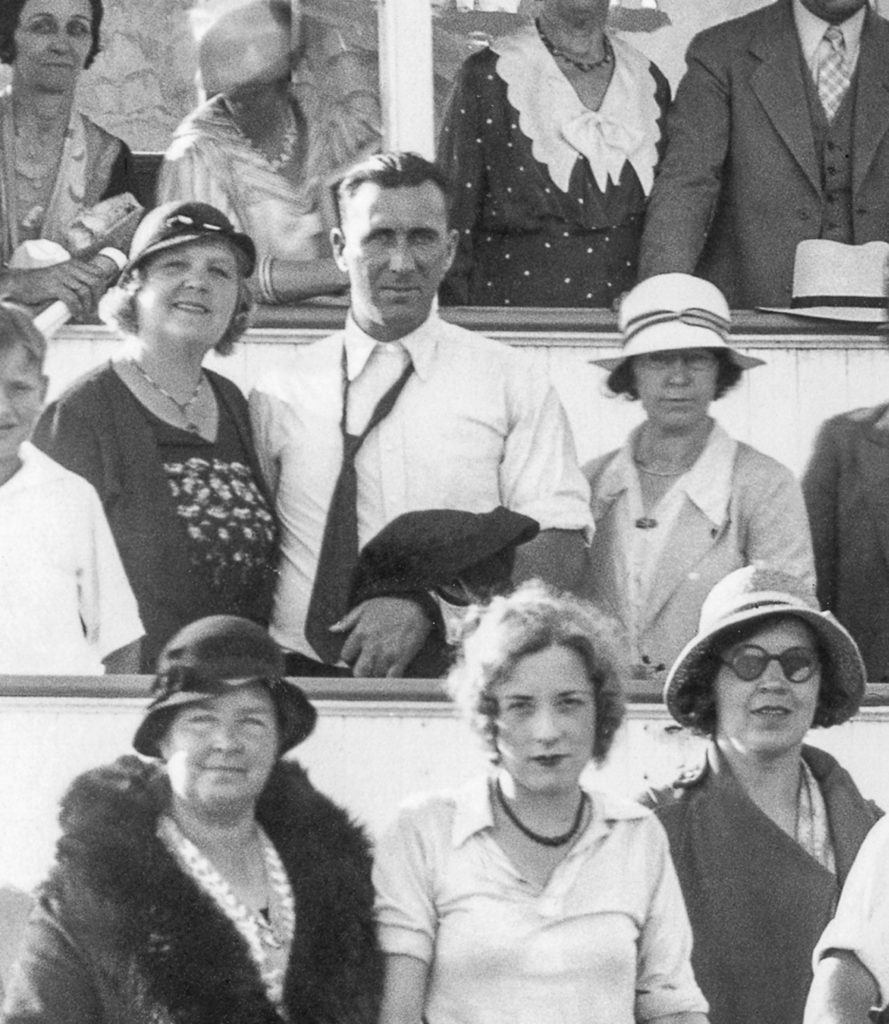
Gunhild and Keith Teter on the Mount Lowe funicular car.
A happy change in their life came when a boarder named Keith Teter checked in at Mrs. Burbidge’s. Keith was an officer with L.A.P.D.
He began his career pounding a beat. When assigned to a squad car an ironic fact came to bear. He never had a driver’s license. His first time out, it was his trustee–the prisoner–that drove. It was the prisoner who taught him to drive.
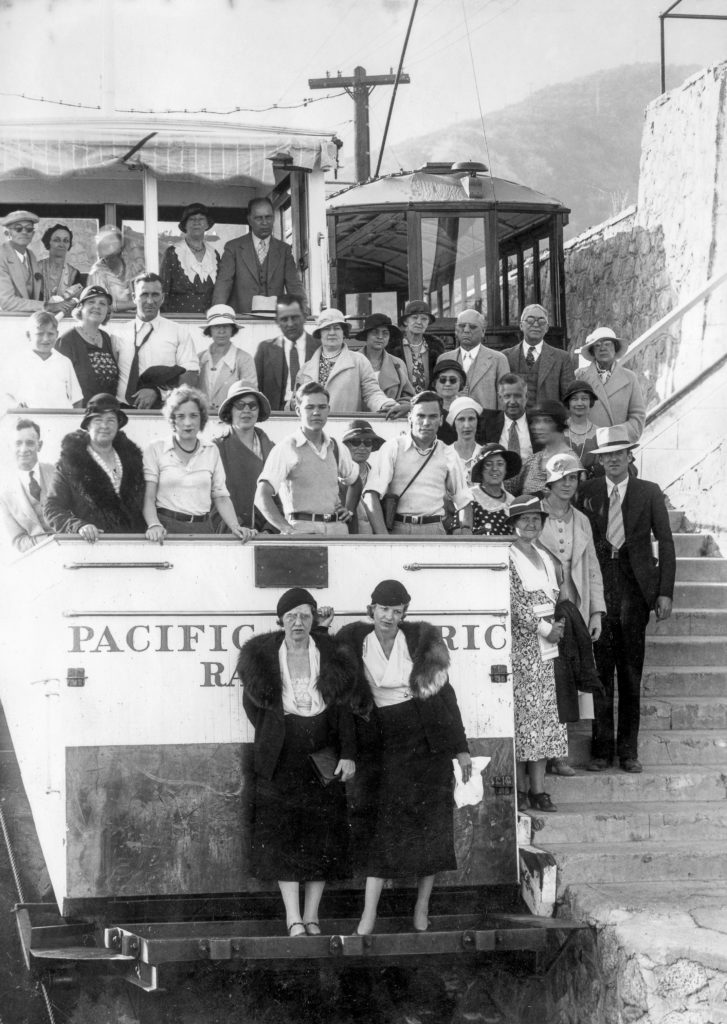
Henry Huntington’s Pacific Electric Railway operated two well known funicular rail cars. One was Angel’s Flight in downtown Los Angeles. The other is the Mount Lowe Car starting in Altadena. I suspect the later is the car is in this photo. (Gunhild and Keith, left side. Next row from the top)
Keith was honest, without fail. After shopping if he discovered too much change was given–even if the amount was only a few cents–he turned around and brought the money back, no matter the inconvenience.
He was the cop that criminals trusted to leave their belongings with after being booked. Their goods would be intact after release.
He never accepted gratuities or freebies. In his day he saw his fair share of calls for help from members of the Hollywood elite. One in particular was Judy Garland. She wanted to thank Keith once by giving him a horse. He declined.
Keith detested violence and bullying. He sought to impart gentleness and kindness in the world. He was careful not to hurt even the smallest of insects.
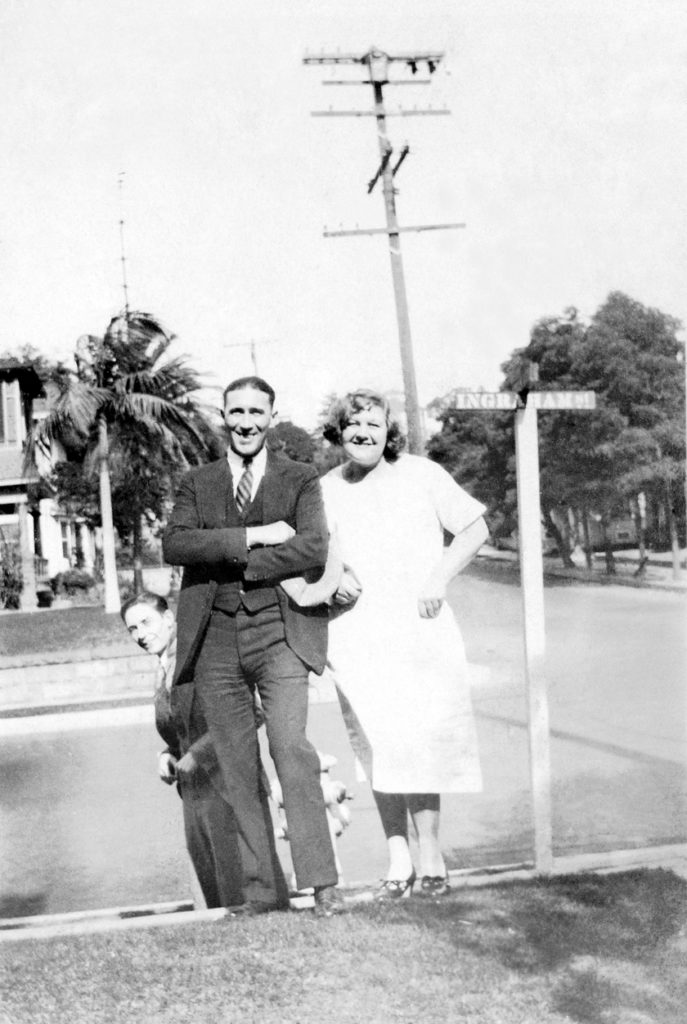
Keith and Gunhild at Ingraham Street and Union Avenue. Note the tiny street sign.
Keith said about Gunhild, “I looked into those blue eyes and knew I had to marry this woman.” He lavished her with flower boxes and arrangements. He always included a card with a sweet sentiment written by hand.
They married on Saint Valentines day, 1933. He was 40 years old and had not married before. The couple moved into their own home on nearby Shatto Street.
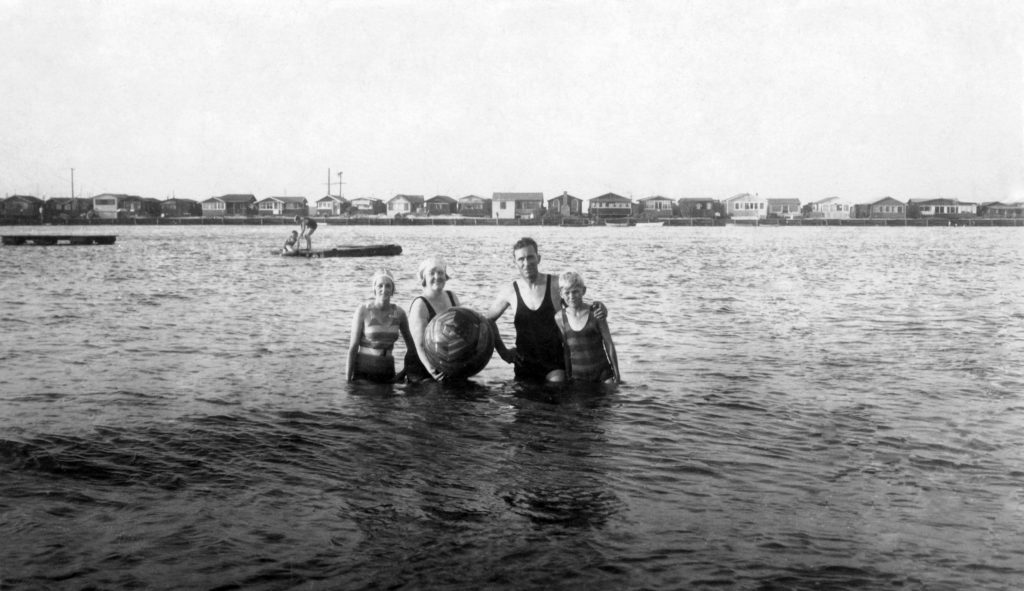
Gunhild with beach ball; Keith and Bill. They’re enjoying recreation at Anaheim Landing. Today it is called Seal Beach.
A sister for Bill, Greta Louise Teter, entered the world in 1934.
“I was a little premature and nearly delivered in the elevator of the hospital,” Says Greta, “The doctor was Dr. Ross of Ross–Loos Medical, a once well known facility.”
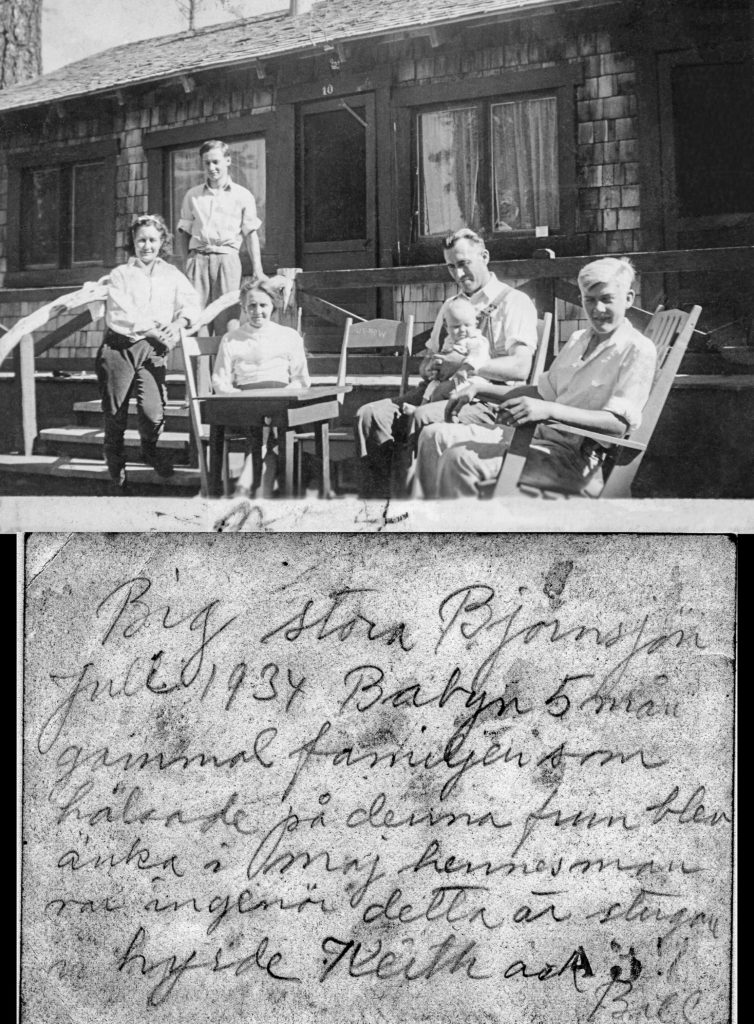
Gunhild’s note in Swedish. Keith holding baby Greta. Bill seated right.
Gunhild loved camping and back country excursions. She brought along her kitchen wizardry as part of the experience. On an old camp stove she could make puddings, cakes and biscuits to go along with shish-ka-bobs cooked over the campfire. S’mores over the campfire.
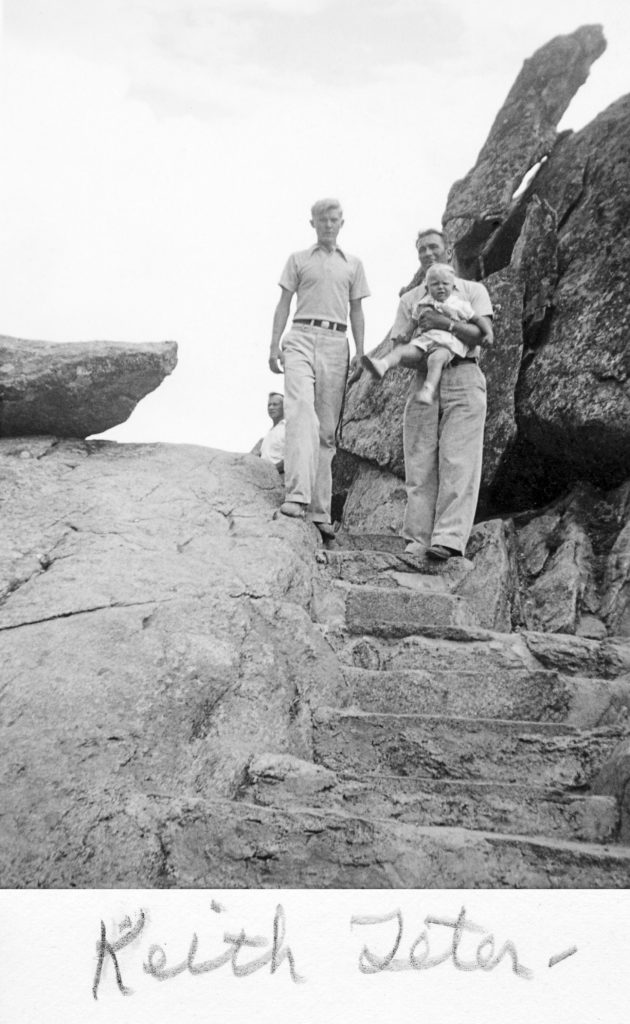
Bill, Keith and Greta.
She cooked roasts, chops, meatballs, etc. When she wanted ham she’d wrap one in butcher paper, put it into the coals from the previous night’s campfire. Potatoes were also thrown in. When the crew came in from a long day of hiking or swimming the feast awaited.
Bob Beattie remembered how most people were trying to work through The Depression. Events in Europe weren’t too much on people’s minds. “It was so far away. The politicians, of course, were following what was going on.”
From the very year The Soderbergs immigrated from Sweden, 1923, Adolf Hitler decided he was destined to run Germany. Through ten years of turbulent political struggle and power building , Hitler became chancellor in 1933. After German President von Hindenburg died, 1934, Hitler declared himself Fuhrer of the Third Reich.
Perhaps the first close look Americans had of Hitler was with the 1936 Summer Olympic Games in Berlin. The year of Jesse Owens and his inspirational performance.
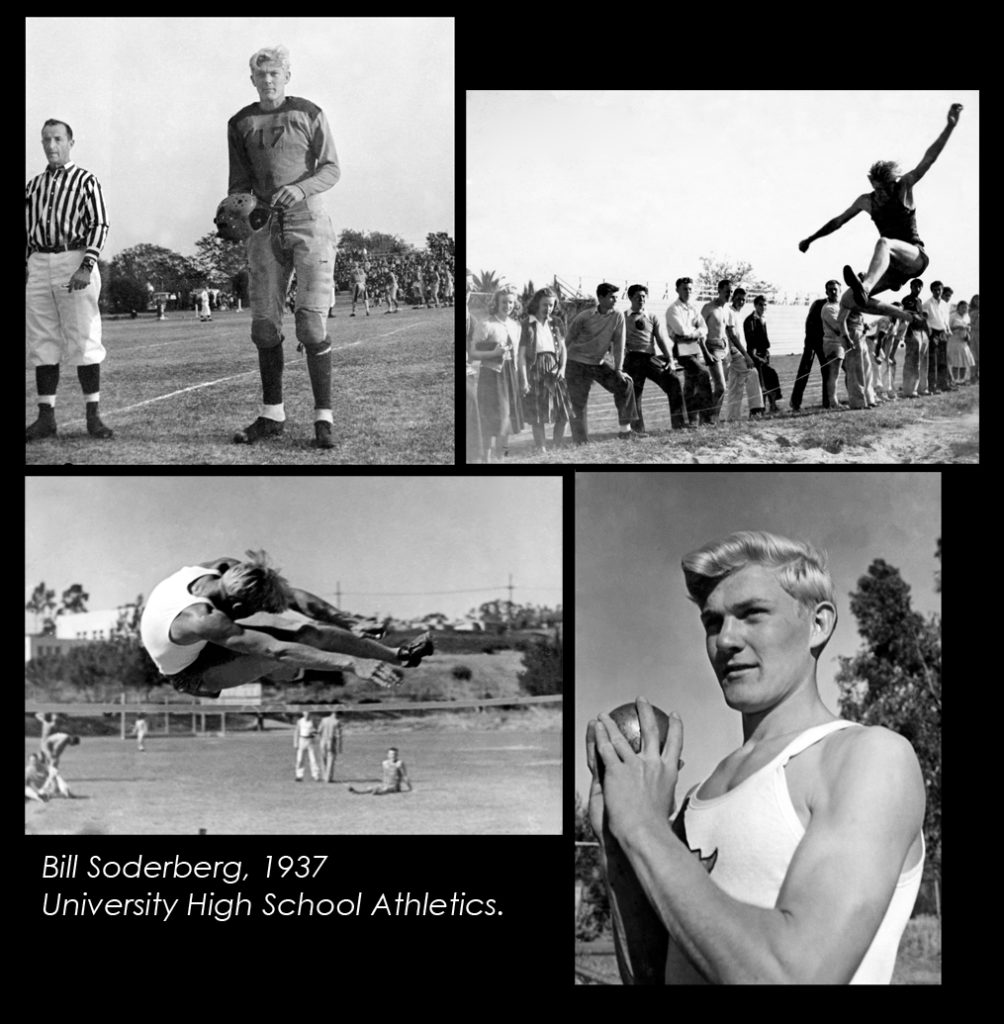
Gunhild loved the football games. She was an enthusiastic spectator.
“Bill and I lost track of each other for awhile. We met up again in 1937 when we found ourselves at the same high school. University High School in West L.A. He was in tenth grade; I was in eleventh; a year apart thanks to old Mrs. Finch back at Cambria School. Bill was a letterman in football, track–the high jump and shot-put. He set school records in many of his events. By then his family was living in a house in Cheviot Hills.”
I asked Bob Beattie if he also remembered, as Bill once described, Olympic Boulevard being waist high in weeds growing through cracks in the pavement.
“Oh my, yes! The west side was nothing but open fields and weeds back in those days. They took one of those fields on Pico and made a drive in movie theater. There was a hole dug out under the fence. Bill and I used lay there to watch movies. You’d run over and turn on a microphone (speaker) to hear the movie. That is until the guard came over with his flashlight.
“That is about the time your dad first met your mother, there around ’37, at the beach in Santa Monica where we all used to go and hang out.”
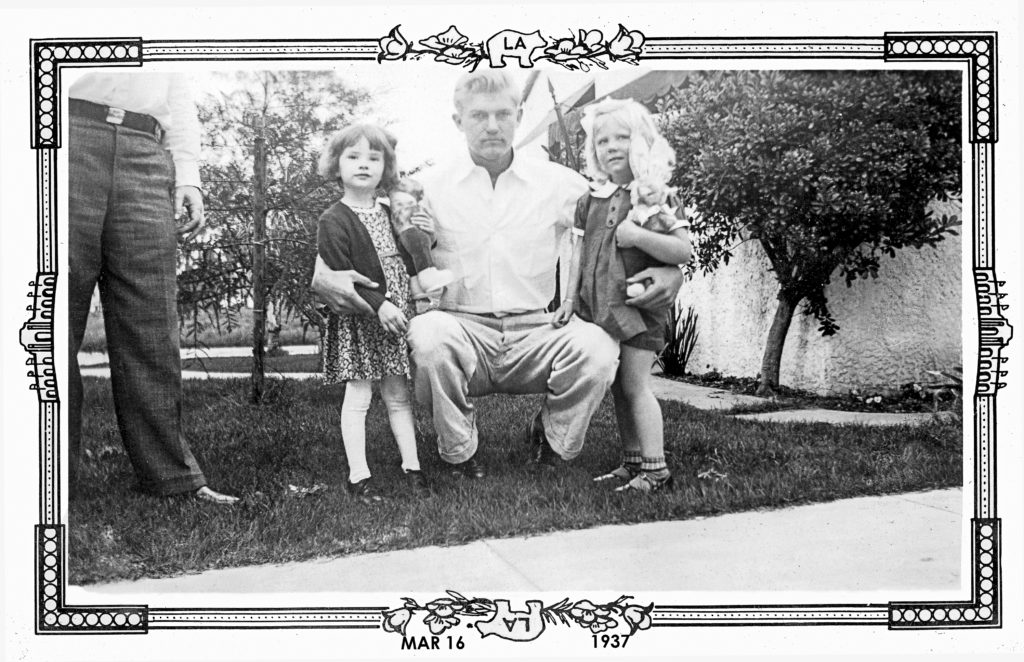
Bill and Greta (right), 1937. Icon of L.A. Collesium frames the photo.
Though thoroughly absorbed with raising a young daughter, seeing her son through high school, running the household of their new home in Cheviot Hills, Gunhild did not forget she had another family living half a world away in Sweden. The news she heard was not good. For some time her mother Alma was in declining health. News only got worse. Gunhild felt she had to do something. The options and choices couldn’t have been easy. But she traveled across the Atlantic once before with a young child under far more difficult circumstances and conditions. She could certainly do this again.
Greta remembers how her mother explained the situation:
“First, Sweden is my old home where I was born and my mother, your grandmother, is old and not well. I have not seen her for a long time and I feel that I should be with her now. Sweden is far away over the ocean and we will travel on a big ship and we will be gone for a couple of months or so. Daddy needs to stay here because of his work and your brother, Bill, needs to stay in school and study hard.”
Part 3 of My Family Story, Marstrand, Sweden. Gunild returns home to Marstrand. Her Mother is ailing.
The journey began somewhere around the first week of May 1938. The first leg was a Greyhound bus trip from Los Angeles to New York City.
“I don’t remember much about the trip on the bus, except my mother’s ankles were swollen, and I was sort of bored. Mother tried to keep me occupied and still by reading stories to me. I made faces at the passengers,” recalls Greta.
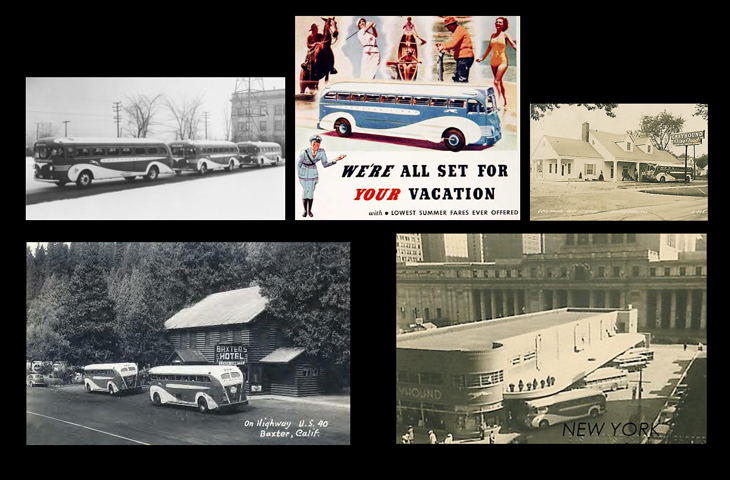
1938 Vintage Greyhound Buses and the common Post Houses and Stations
“The food at the places we stopped to eat was not very good. We were on a budget so my mother didn’t buy very much to eat for herself.”
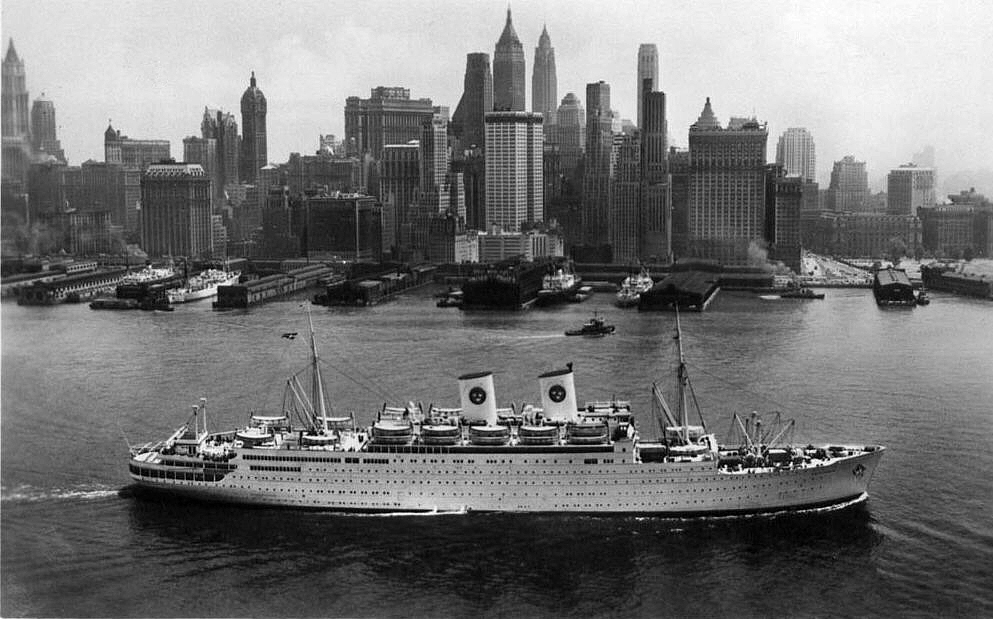
“We finally reached the Swedish American Line, the ship, M.S. Gripsholm. I spent the first few days exploring the ship and engaging the captain and passengers.”
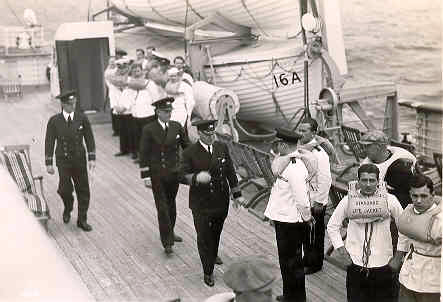
Gripsholm lifeboat drill.
“During the trip there were lots of seasick people, but we were fine.”
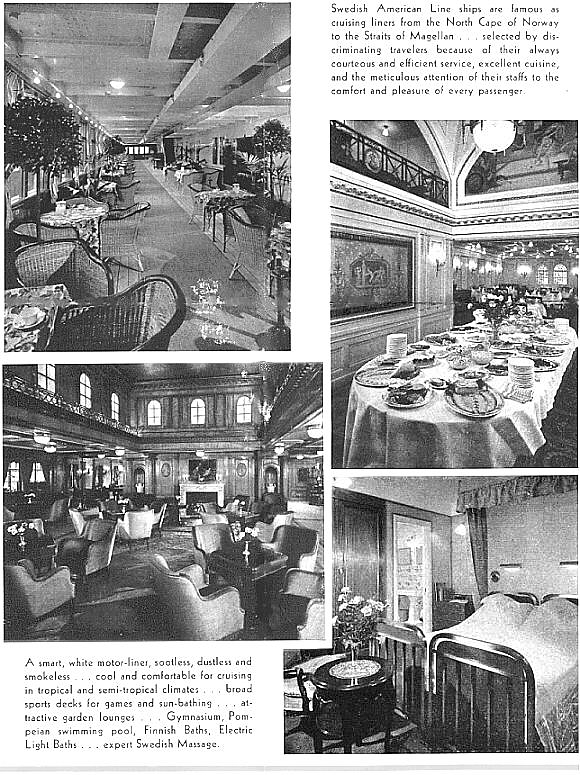
Gripsholm sales brochure–the First Class view. Gunhild and Greta had Economy Class, but still enjoyed pleasant accommodation.
“Life at sea seemed to agree with us. We never missed a meal and the food was quite good. Lots of ice cream. There was a large padded play area. All closed in and ‘safe.’ There were swings and slides and games to play. I remember playing here with children my age while my mother visited with new friends she made.
“There were also concerts and shows every day. Puppet shows and dances.”
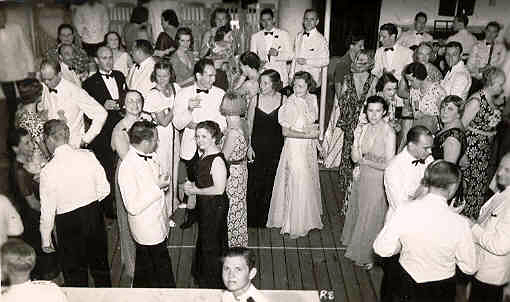
Likely not as many white coats, as seen here, for celebrations in Economy Class. All photos, 1938 Gripsholm.
“When we crossed the International Date Line there was a huge celebration.”
“There were 274 passengers on board this trip. When we reached Halifax we had fog for four days and four nights. The fog horn blew every 30 seconds. It sounded sort of spooky and lonely.”
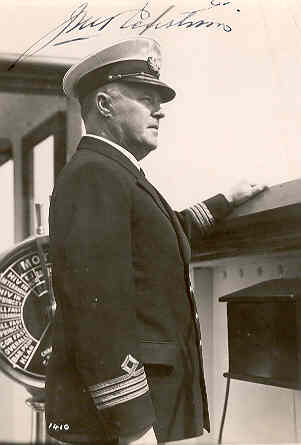
Gripsholm Skipper
“Our skillful Captain didn’t leave the bridge day or night as we had to travel very slowly. We didn’t see land or even another boat for seven days. When we came near Scotland we had 24 hours of wind. It wasn’t until we sighted Norway that we saw the sun for the first time that whole day. We saw at least four ice burgs which they said made the weather so cold.
“I can’t remember how long the trip took, but I know we arrived at Goteborg, Sweden at eleven P.M. July 10, 1938. We were told we could disembark or remain on board for the night. We decided to sleep on board and have breakfast in the morning before disembarking to connect with our ferry to Marstrand. We arrived there at One P.M., July 11, 1938. We were very tired from the long journey.”
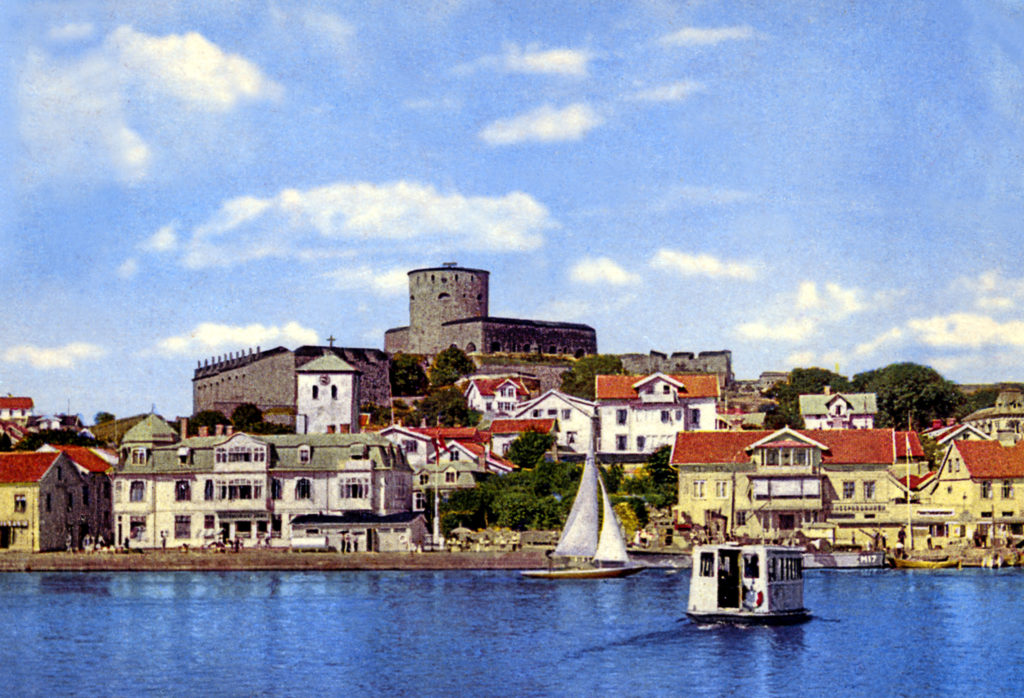
Marstrand, 1938 Postcard
As Greta looked around to take in the unfamiliar sights, she suddenly found herself lifted into the air and looking down into the blue eyes of a smiling handsome older gentleman. She thought he looked a lot like Bill.
“This is your grandfather,” said Gunhild. They looked around. “Where is grandmother?”
Alma came along the wharf slowly and appeared frail. So many years had passed; she was slow to recognize Gunhild. Once the reality of reunion set in, it was a most happy occasion. They looked for a horse and wagon that was arranged for. Alma tired easily, though. During the wait she closed her eyes.
Gunhild explained to Greta how sick Alma had been. And how the death of Alma’s son–Gunhild’s brother, Algot–was a wound in her heart she never recovered from.
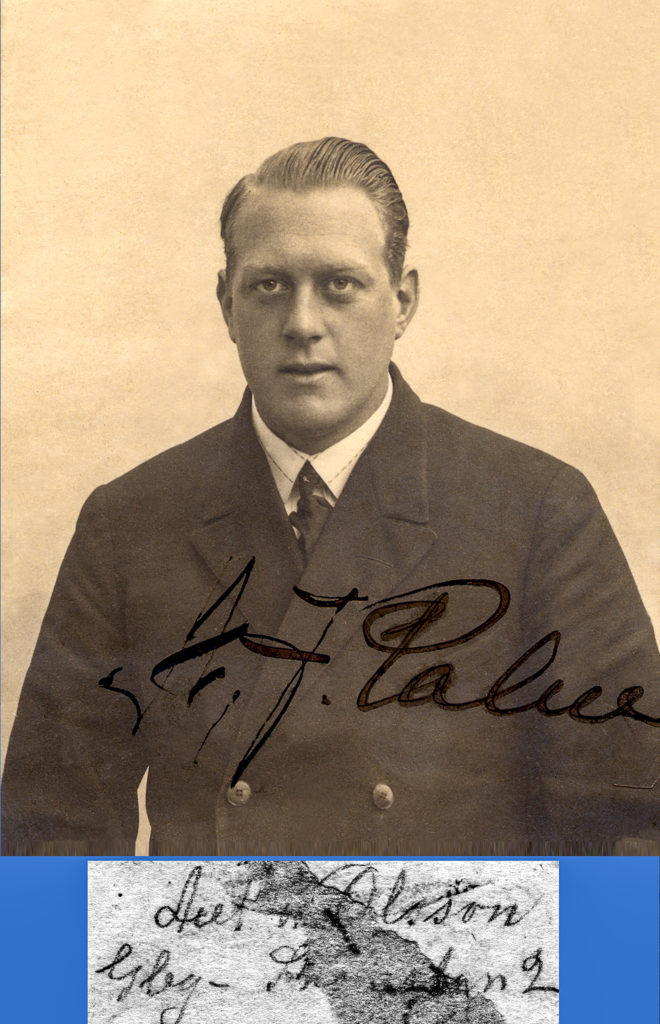
“Uncle Algot”
Algot Fredrik Palm was a career sea captain. An accident at sea claimed his ship. He managed to pull everyone off the sinking vessel. But was unable to save himself. This tragic event left Alma with a sadness in her eyes. An oldness in her face. A smile that was never seen again.
As Gunhild, Greta, August and Alma rode the horse drawn wagon to the walkway of the house, Alma began a narrative that would take hours and days to complete. All the news of the past 15 years on Marstrand.
Some men unloaded and carried the trunk up the winding pathway to the house. The family followed. Alma breathing heavily with each step to the top.
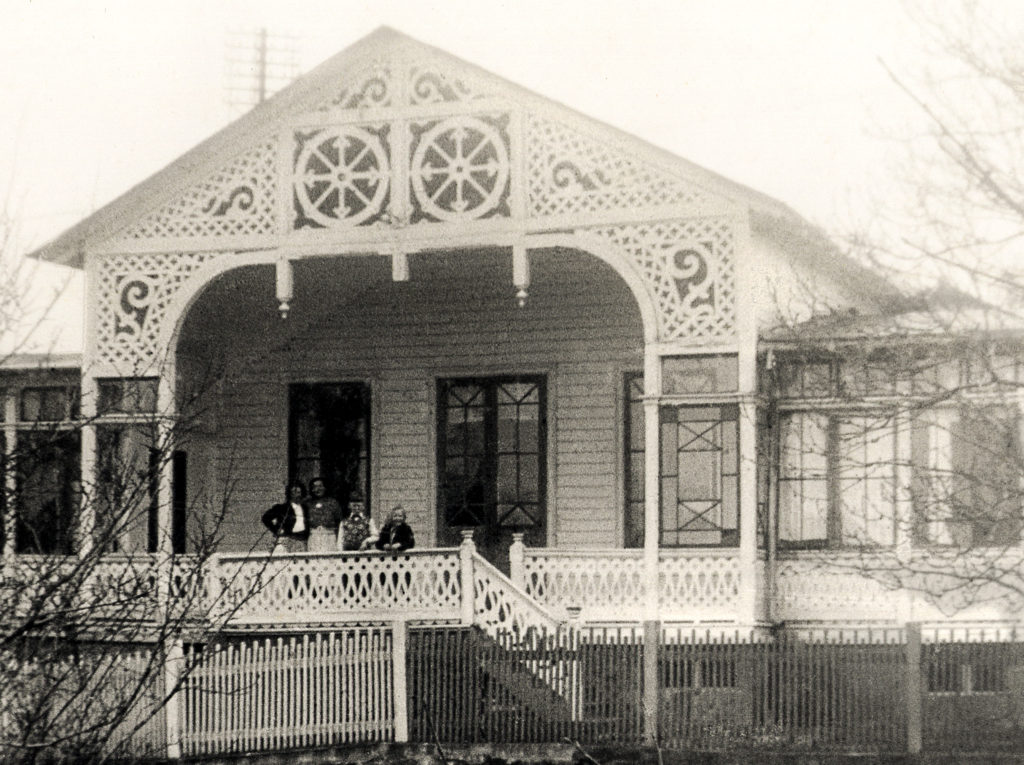
Gunhild, at the window center. Greta, far right
The 1938 August Palm residence had the highest perch of any house on the island. The house was encircled by a gravel walkway. The stairs, as seen here, lead to a large porch or veranda. Highly ornate “gingerbread” cut outs were above and to the side of the veranda.
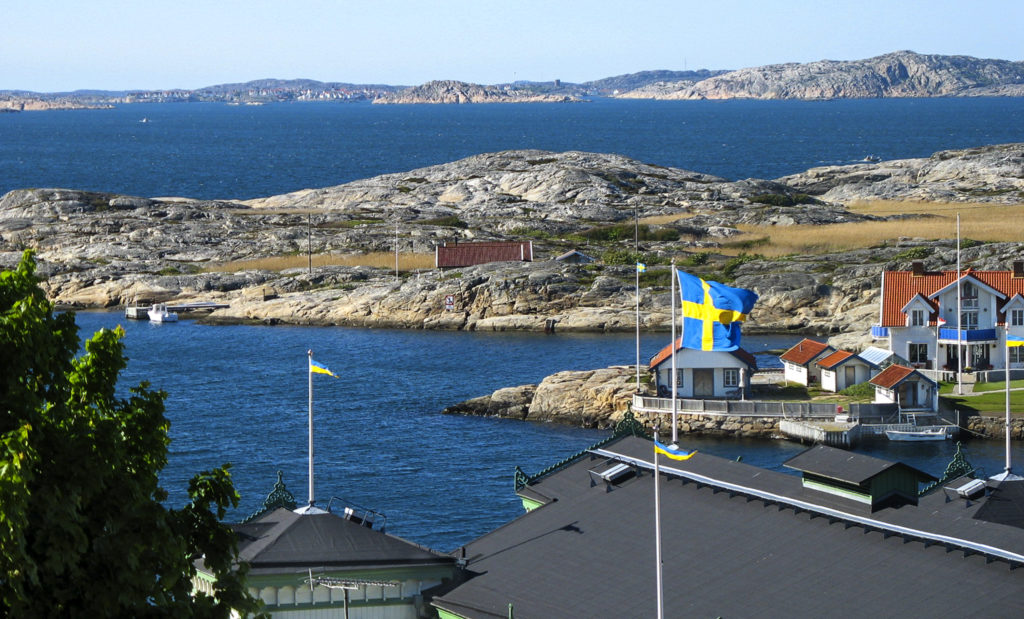
The house retains a spectacular total peripheral view of Marstrand’s northern harbor entrance and bay.

Marstrand Flowers
A flower garden was to the side and to the back. Large multi color poppies. Lilacs with an intoxicating aroma. White, lavender, and purple blossoms hung down from an overhead lattice.
Gunhild utilized a productive herb garden for her kitchen genius. Parsley, chives, rosemary, dill and basil. A gooseberry bush was used by her to render delicious puddings and pies. The same was true of the rhubarb patch.
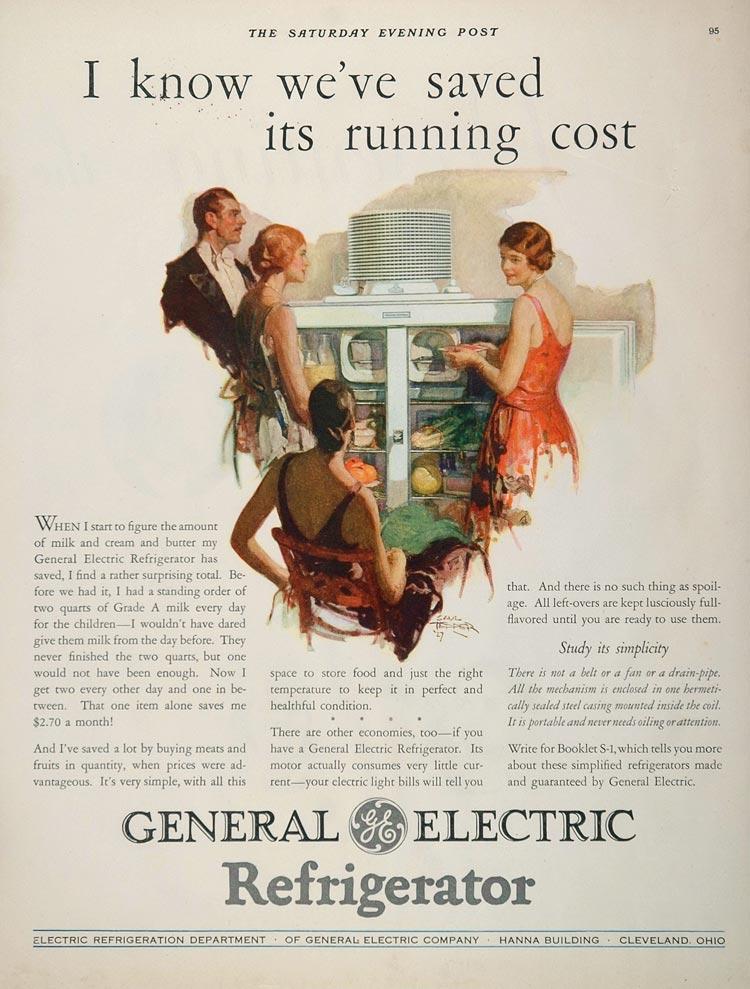
The above advertisement boasts 15 years of developing and selling refrigerators. These units were common place in Los Angeles homes well before 1938. But Marstrand was still catching up.
“We didn’t have a refrigerator, so cold stuffs had to be kept in the cellar below the house through a door from the back porch off the kitchen. It was carved out of the rock under the house and resembled a cave.
“There was no indoor plumbing to speak of. On the left side of the house, from the front, was the ‘outhouse.’ It wasn’t really ‘out,’ it was located on the side slightly under the house. When it snowed, or was too cold to go outside, we used the old fashioned chamber pots.
“Bathing in the winter consisted of heating water and filling a large metal tub in the kitchen. Thus we did not fully bathe every day. We took sponge baths.
“In each bedroom there was a stand which contained a bowl and pitcher on top and a chamber pot below. I admired the pretty flowers and designs which decorated the porcelain.
“Everyday, while we were there, my mother filled all the pitchers on the washstands with water so that we could wash our hands and face in the morning and whenever I got dirty. We poured water in the large basin and after washing we could brush our teeth. Soft water came from a rain barrel positioned under a rain spout from the roof. This was used for washing hair–it seemed to make it soft and silky. All this was certainly very different from back home, but I thought of it as a great adventure.
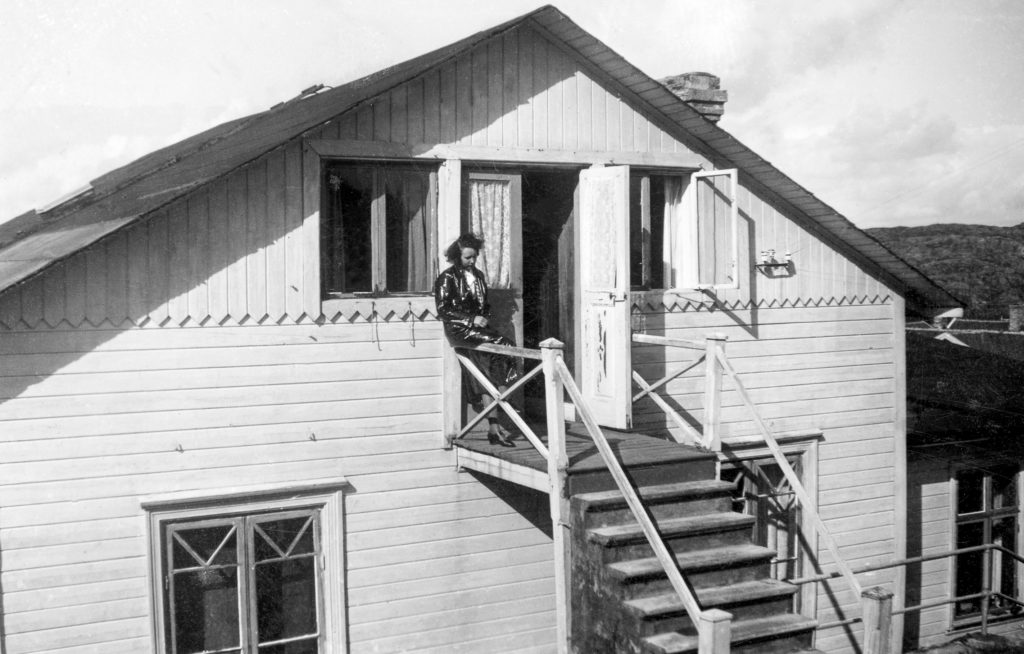
Back View, August Palm Residence. Unidentified guest or friend.
“There were many rooms in this large house and in the summer they were rented out to tourists. When we arrived that July, 1938 the house was full. Mother and I shared a room.”
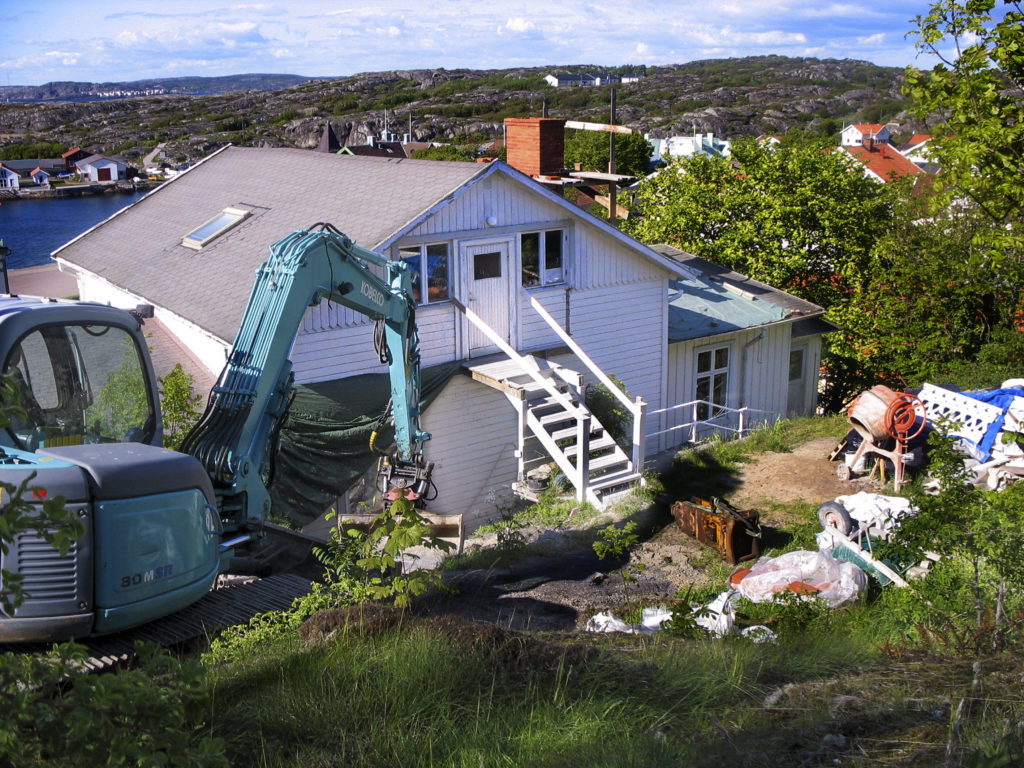
A backhoe is poised for re sculpting the back yard. Construction matter occupies the former herb and flower garden. Only ghost rhubarb and gooseberry plants remain. I wonder if the breeze ever echoes phantom huffs of Greta’s friend, the wily bull. (read below).
Greta helped with water pump duty. The only plumbing in the house was an old metal water pump attached to a wooden kitchen sink.
“Sometimes I helped out when the guests were there. When Mama cooked in the kitchen, and busy preparing food at the sink, guests frequently ran out of water for the pitchers on the washstands. Since mama worked by the pump I didn’t want to disturb her. So I surprised her by running over to the back of nearby Carlstens Fortress with a bucket to fetch water. This pump was hard for me to operate, but eventually I was able to fill a bucket with the cool fresh water it produced.
“Unfortunately there was a large angry bull who hung out thereabouts and hated me with a vengeance. He often saw me walking with a full bucket and charged at me like a locomotive. I ran for my life and spilled the bucket’s contents as I ran. I learned to watch for him and bide my time until he was fast asleep standing in the warm sun–he slept very well on his feet. Sometimes when I ran from him, I slipped on a ‘cow paddie.’ I fell flat on my face and got manure in my hair and on my clothes. My how that stuff was slippery! He never quite reached me, though. I managed to elude him every time. I wonder now if it was only a game with him. That he didn’t really want to catch me, but only terrify me. I’m sure he could have trampled me if he wanted to. I was certain he smiled wickedly at me every time I came into his sight.”
Part 4 of My Family Story in Marstrand, Sweden. A view of 1938 life in Marstrand.
“Of Boats, Fish Tales, and Pigeons.”
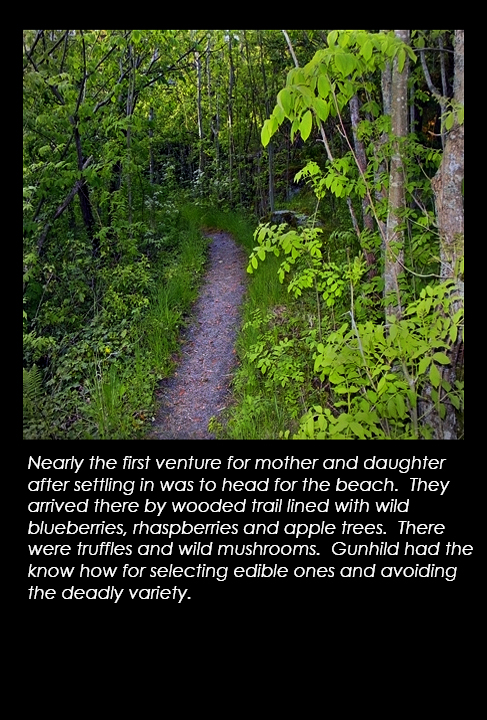
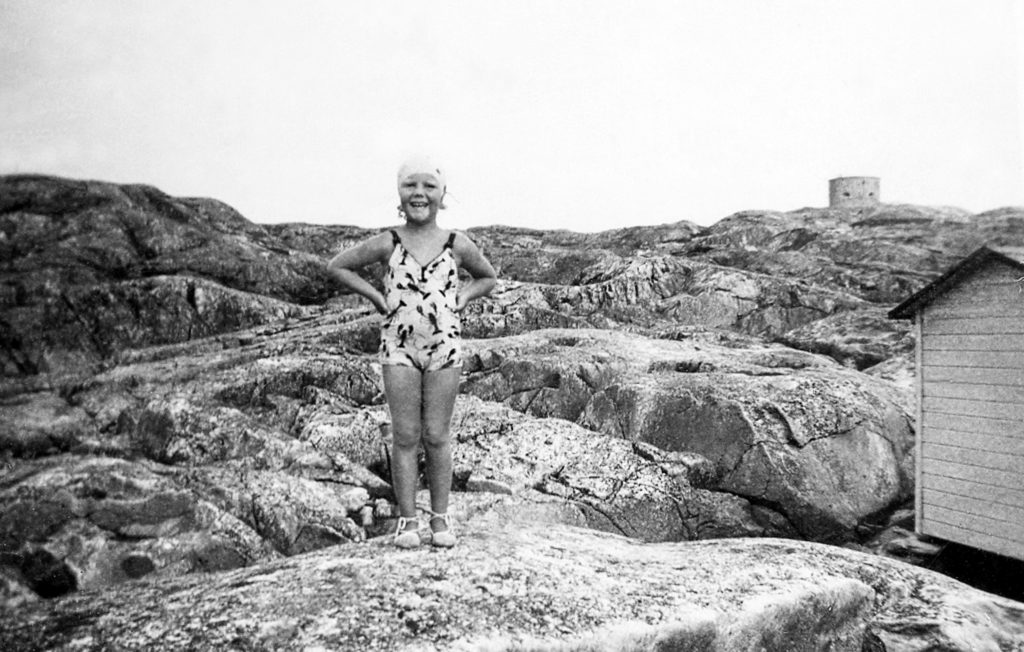
Greta at Marstrand beach in her stylish lobster motif swim suit. That’s the same wooden shelter for changing shown in the previous photo. Carlstens Fortress in the background.
Greta learned to swim here. She was in the water up to 3 hours. Even 5 hours. Initially her body experienced some shock doing this.
“I was really in for a big surprise. The water was so COLD!!!. We had a hard time getting used to it at first. There were several times my skin was blue and I shivered when I got out of the water. As time went on we got used to it and found it very invigorating.”
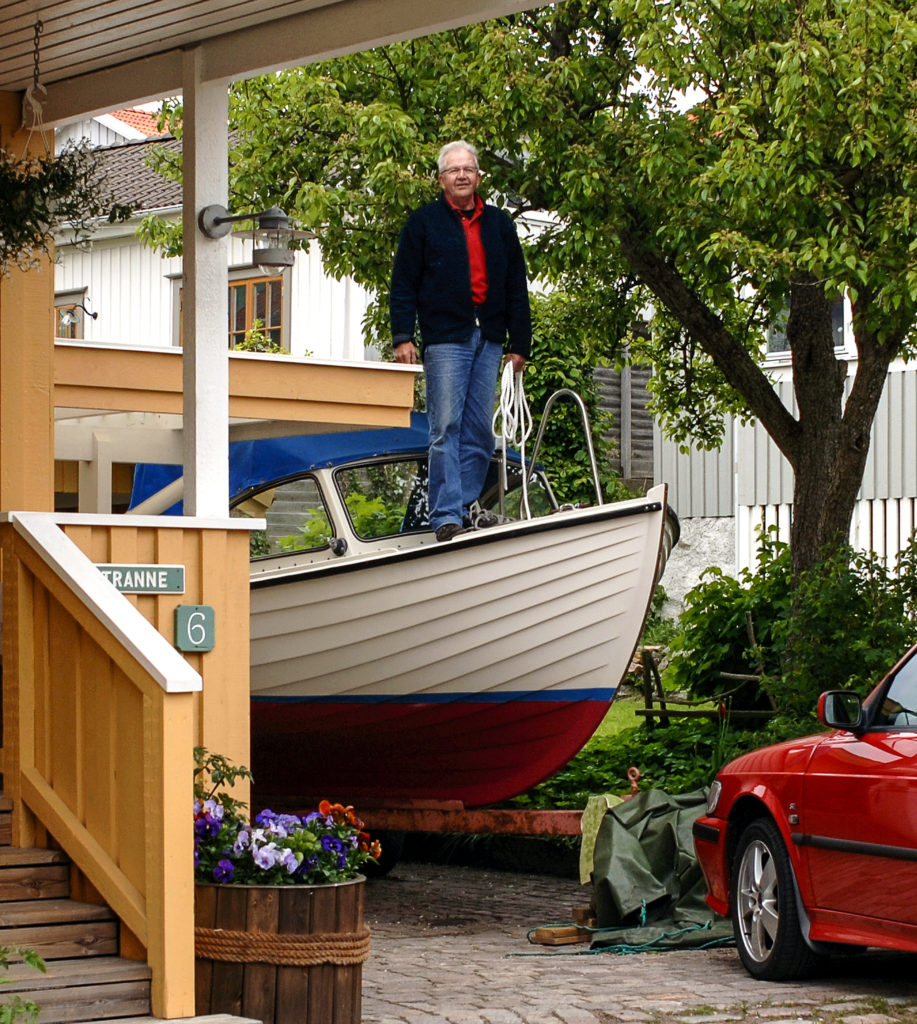
“‘All The Swedes in Marstrand love their boats,’ Mama always said. ‘They have at least one boat of some kind. Some have several. Even the poorest has a rowboat,'” quoted Greta. “Mama’s friends had some large grand boats, and took us sailing from time to time.”
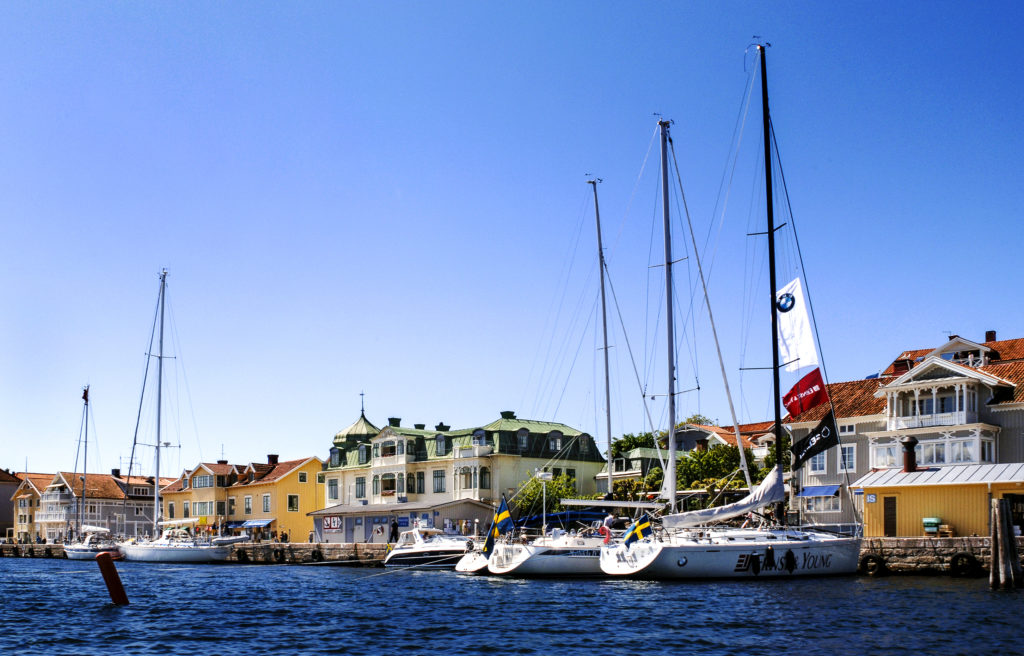
A view while Crossing Marstrand Harbor in a small boat. Skippers Lena and Gunnar Danielsson, Inn Keepers of Korsgatan 5–excellent, highly recommended Marstrand accommodations (and extremely nice hosts as well!). lena.gunnar.danielsson@telia.com
“Summer was a glorious time in Marstrand. How wonderful the breeze felt. Cool, yet warm blowing through my hair. And the sky–how blue it was. The water was crystal clear and I could see rocks at the bottom and fish swimming around.”
One of Greta’s cherished memories is when Grandfather August took her fishing. Gunhild packed a picnic lunch for them. Pork sandwiches with cheese and home churned butter on heavy brown bread. Coffee cake and wild pears for dessert. August Palm had a common row boat. He fished with only a simple baited line, or string, held by hand. There was a bit of ritual or method he taught Greta. After catching a fish, he instructed her to blow on its mouth before casting for the next. With the second fish she blew on the tail. With the third fish and all the following ones, this procedure progressed. One eye, then the other. One gill, the next. Top fin, bottom fin, and so forth.
“It was so amazing to me how when grandfather August told me to blow on a part of the fish that I would immediately catch another one.” Fishing was over for the day when there were no more parts to blow on.
At evening time August Palm liked to regale family and guests with fishing tales. Gunhild noted he added to the stories each time he told them. Sometimes he enjoyed a glass of schnapps. The stories became wilder and wilder. The fish got bigger as well.
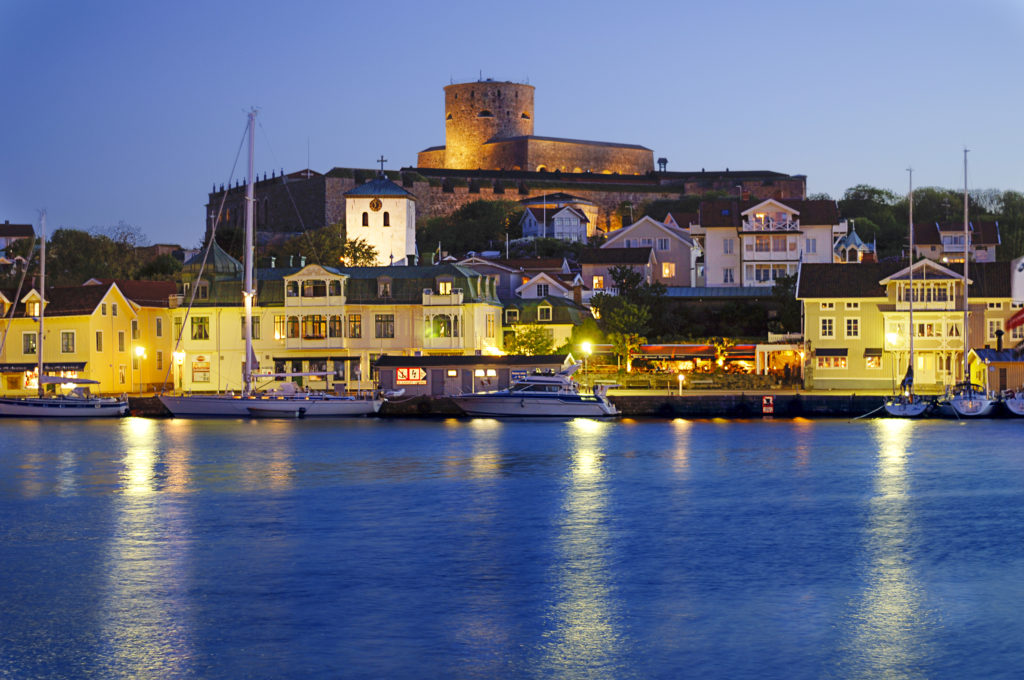
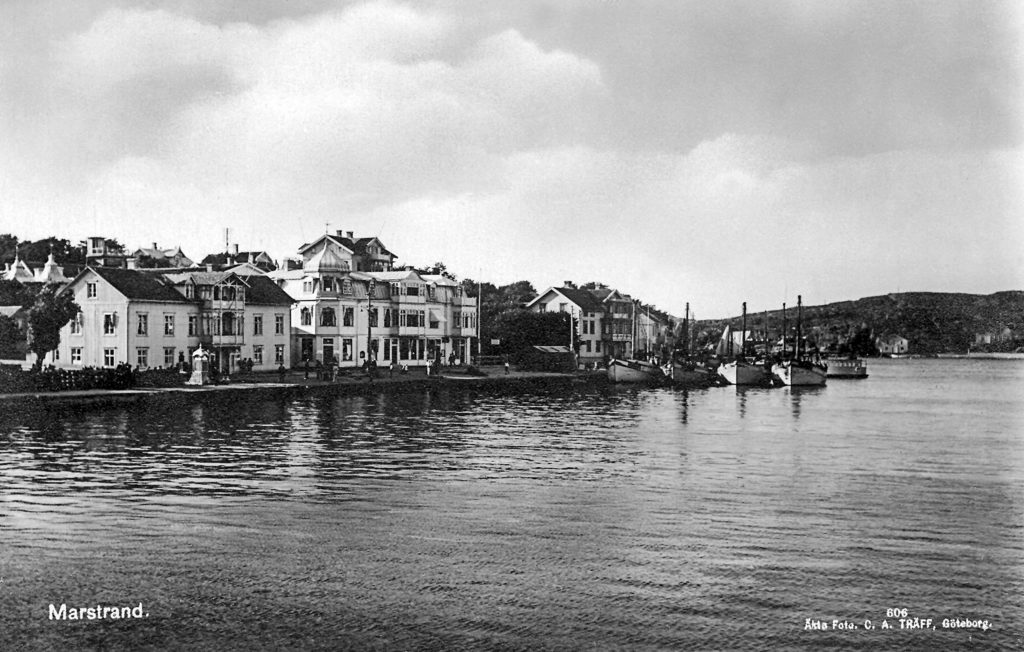
Marstrand wharf and Harbor, circa 1938/39
Fish was plentiful and Swedes ate a lot of it. Most food in 1938 Sweden was expensive and often scarce.
Much of this had to do with trade arrangements Sweden had with Germany. For instance, every week a German ship came to dock at Marstrand’s wharf. Crates of butter were loaded on board. Gunhild wrote there were 23 tons of butter loaded up every year and sent off to Germany. The ship remained docked for a week before rotating out for another to take its place. Aboard each ship were thirty five to forty German soldiers that made their presence known.
Hotels and restaurants had priority to meat, produce and other goods not shipped to Germany. Gunhild was perhaps mindful of that when she observed German soldiers at Marstrand hotels living it up. “They ate like horses,” she said.
Meanwhile butter in Sweden was expensive. So was milk. There were very few vegetables. Gunhild wrote that fruit was hard to get and “nearly the price of gold.” Meat of any kind was hard to obtain. Once she went to the butcher shop for calves liver, but had to order it. Two weeks passed before delivery.
Sweden had to placate an aggressive German war lord and to remain as neutral as possible during his rein of conquest. By the Summer of ’38 Hitler had taken Austria without resistance. Czechoslovakia was his next target. It appears whatever hardships Swedes were asked to endure during these years–there were many– it was considered a better option than to infuriate der Führer and to suffer bloodshed, bombs and stripped sovereignty.
Critics contend Sweden was an armed camp for Hitler. However it is certain Sweden aggressively bolstered its defense budget, mobilized forces, called up reserves, and educated citizens on what to do in the event of hostile invasion. In the words of one government official “to make ourselves as indigestible as possible.” Sweden intended to go down swinging if the bully came looking to fight. In Marstrand that thought appeared to be on everyone’s mind. And as Gunhild noted, “Swedes vowed to fight to the last man.” Even Greta’s young playmate and best friend Gunnar wanted to fight as well.
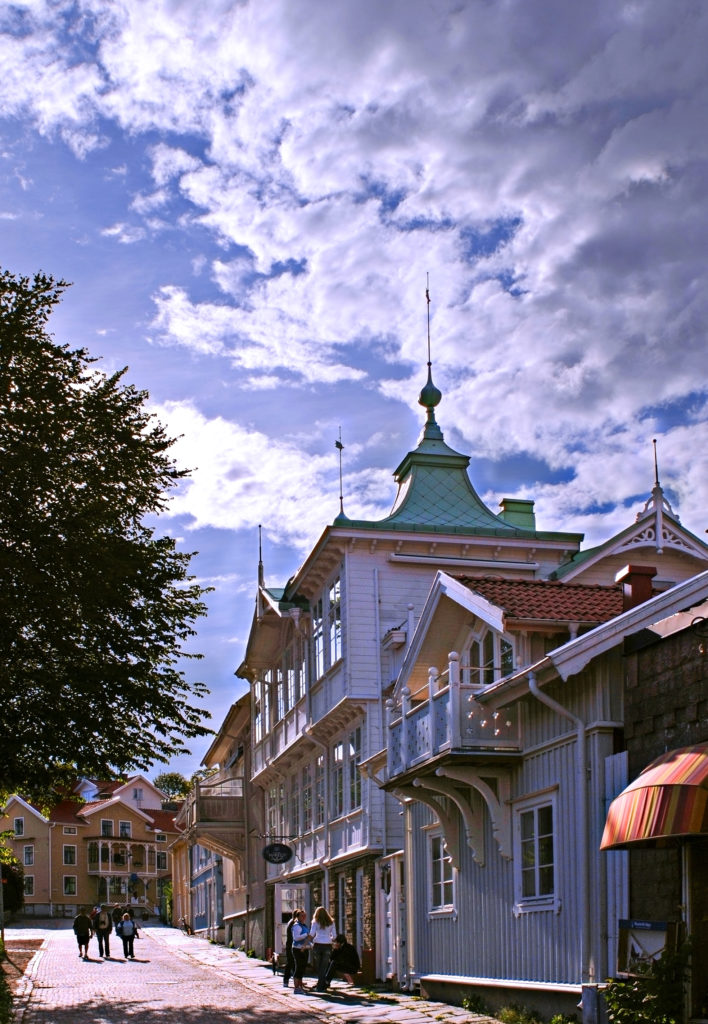
The Meat Market and Bakery once occupied the nearest two storefronts of this photo.
Gunnar’s father owned a meat market. When Gunhild sent Greta to pick up some meat, Gunnar’s dad handed over some salami or bologna with some cheese and crackers for Greta to much on for her walk home. At the bakery they surprised her with miniature bread loaves suitable for doll’s tea parties. Even the pastry shop provided doll size pastries for the young American girl who quickly learned Swedish.
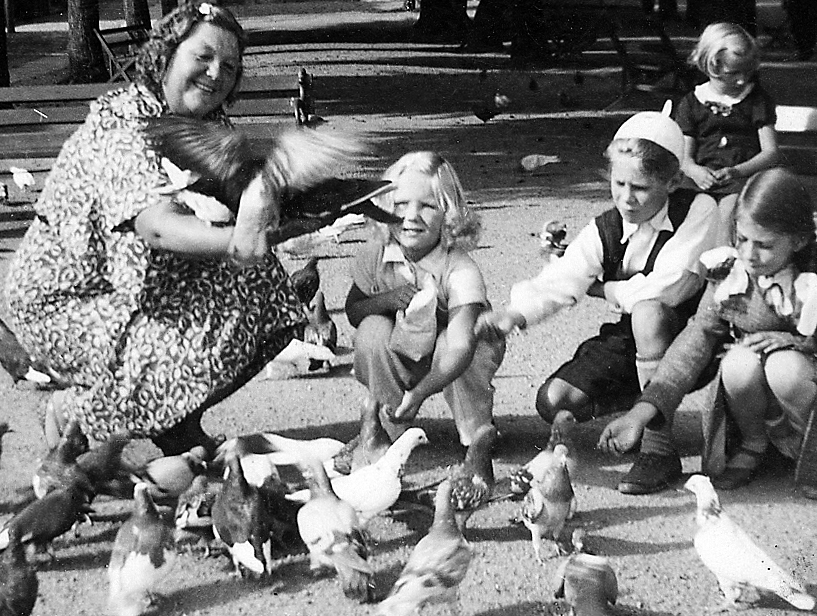
The hardware store also provided treats. Here Gunhild, Greta and the Mayor’s children use complementary bird seeds to excite Marstrand pigeons.
Not only was her quick learning of Swedish helpful at making friends, but so was her possession of gum sticks Keith enclosed in every letter. “I shared with my new friends who thought American gum was the most wonderful in the world.”
Routines, Daily Life and Social Customs in Marstrand
Part 5 of My Family Story in Marstrand, Sweden.
As the month of August, 1938, ended the warmth of Summer was over. Alma’s condition continued to worsen. Gunhild detected signs of stroke as Alma became more confused and forgetful. “Perhaps she was just holding on until she saw my mother again,” said Greta.
Gunhild arose early on mornings to light the old wood burning stove of August and Alma Palm’s large rustic kitchen to warm the house. “Mama cooked wonderful things on that old relic. She cooked in heavy copper pots and pans which had a lip that fit into various holes of the stove top. The rims kept the pots from falling through into the fire below.”
In addition to cooking August’s fish catch of the day, Gunhild made a curry sauce for shrimp. She also made a mustard sauce or mayonnaise dip for boiled shrimp. “Mama conjured up the most delectable dishes. Each one was wonderful.”
Greta discovered by going down to the wharf in late afternoon she could collect all the shrimp and small fish she could carry when the fisherman cleaned their nets. “They permitted me to take what had fallen out of their nets onto the ground.”
When August Palm came home in the afternoons he looked forward to Swedish pancakes with lingonberries dusted with powdered sugar. This was served with pea soup. Sometimes there was an oven pancake filled with sweet smoky bacon or ham. Other favorites on the Swedish menu included boiled fish eggs, fish eyes cooked in butter, escargot, caviar, and fish soup. There were pig’s blood pancakes. Perhaps because this delicacy looked like chocolate, children clamored and fought for the first one off the pan. Other occasions called for roast pig, goose, meatballs and sandwiches.
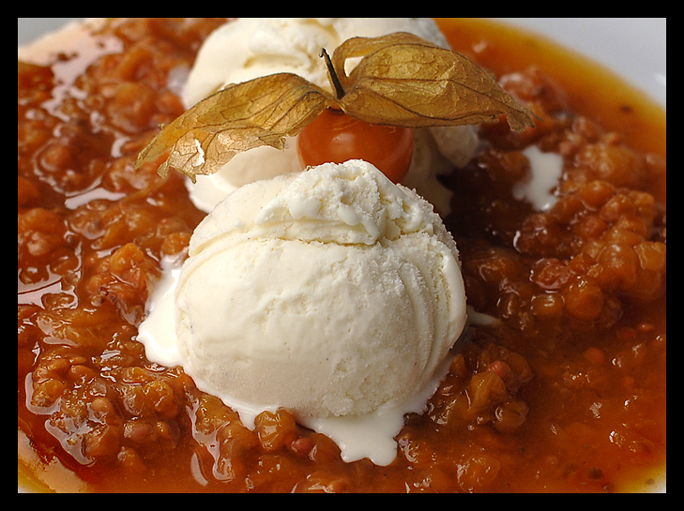
Ice Cream melting in a warm cloudberry sauce.
Gunhild made fruit soups. On that trail though the woods she collected wild rose hips. From this she made a creamy smooth light orange color soup. The blueberries and raspberries were rendered into luscious rich pies.
Four P.M. was a significant hour in Sweden. This is when people stopped to socialize. To go visiting or to have visitors. The coffee pot was the icon of this custom. In addition to serving coffee there was an array of pastries and coffee cakes. Gunhild made an especially good tan color, coffee and cream flavor Mocha Cake. Another favorite was Marzipan Cake. Her French style pastries won the admiration of everyone. Not a day passed in September without Gunhild and Greta visiting friends or neighbors at coffee time. They were particularly fond of a special rich golden apple bread one household offered them.
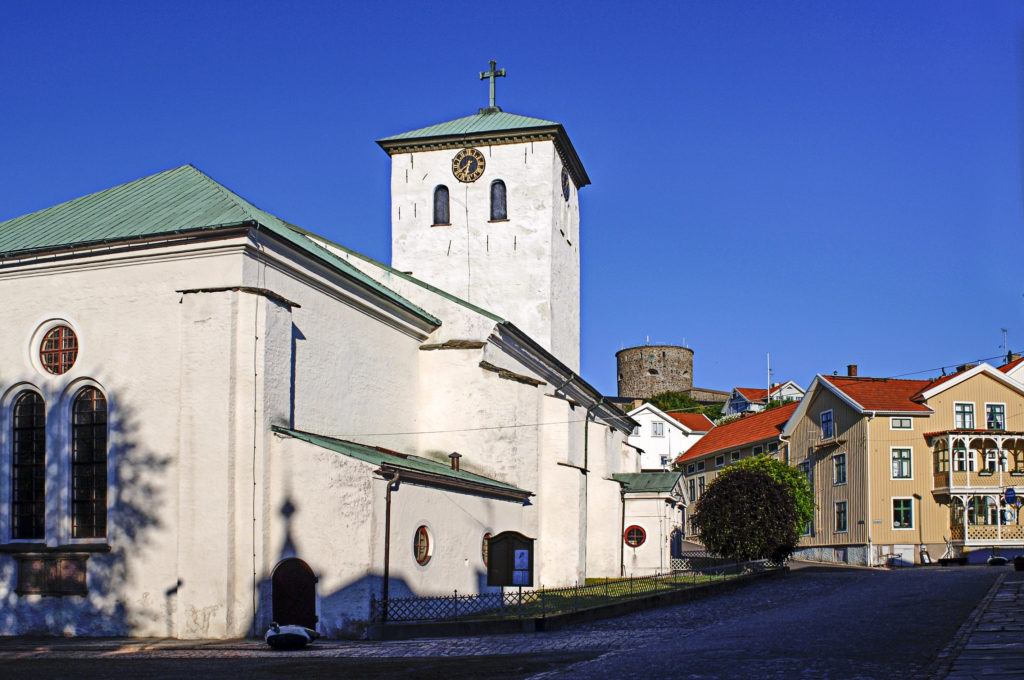
Lutheran Church, Marstrand’s only remaining structure from the middle ages. From the 13th Century when it was a Franciscan convent.
“On Sundays we usually went to church. One Sunday after church we took the little ferry across the bay and walked a long way. We stopped at Mama’s friend’s house for coffee and coffee bread, and lively conversation.
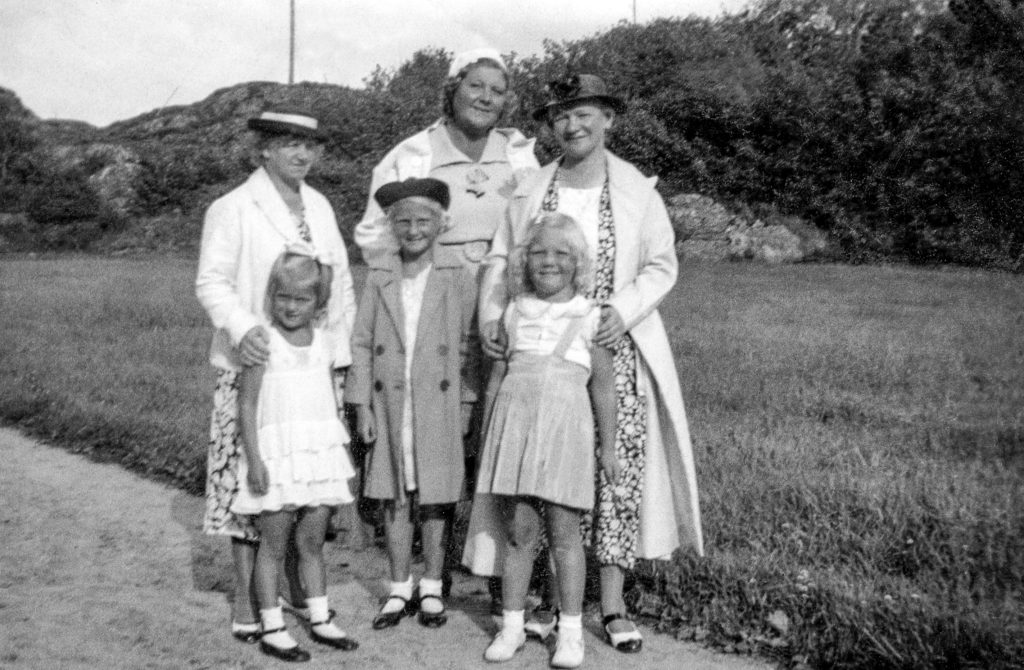
Gunhild (tallest) center, Greta right, and friends all dressed for Sunday.
“Mama’s friends always seemed so cheerful and happy. Like they had just received a very pleasant surprise by our visit. There are numerous islands scattered around Marstrand. It wasn’t unusual for people to get together for wonderful food and a picnic on one of the islands. Ladies attending these functions brought the most delectable dishes that they knew how to make. We carried a large copper pot of coffee with a potato jammed onto the spout to keep the coffee from spilling and to keep it hot. When everyone was assembled we climbed into a boat or two and headed off for an island.”
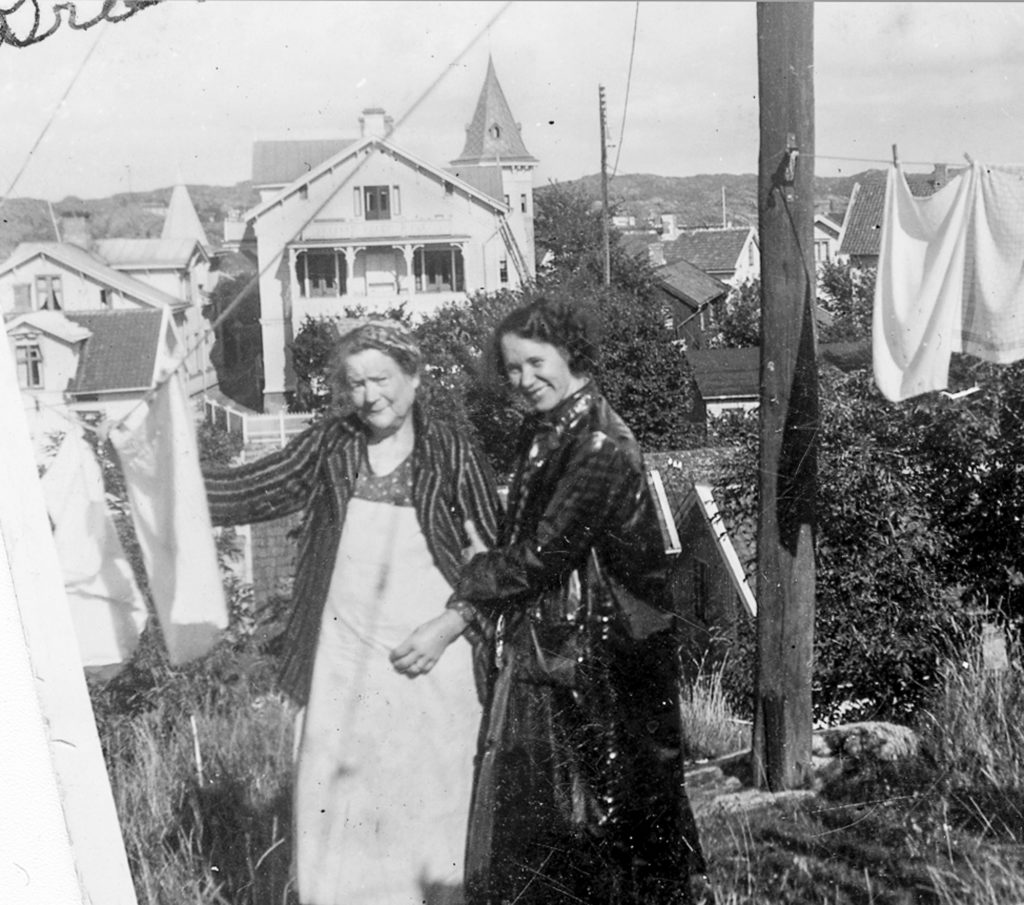
Alma held steady by a family friend. Laundry day.
“Monday was customarily wash day. Before it snowed and water froze, we took our laundry to a small nearby lake. We used ‘jellied’ soap, green or blue, bought by the pound at a little grocery store. We scrubbed the clothes on the rocks at lake’s edge. Sometimes Mama made a ‘brush’ by tying twigs together and scrubbed clothes with it. We rinsed out clothes in the lake. Then hung them to dry on bushes and rocks.
“In winter Mama heated water on the stove and we did our laundry in the large tub in the kitchen–the same one used for bathing. Then hung the clothes to dry.”
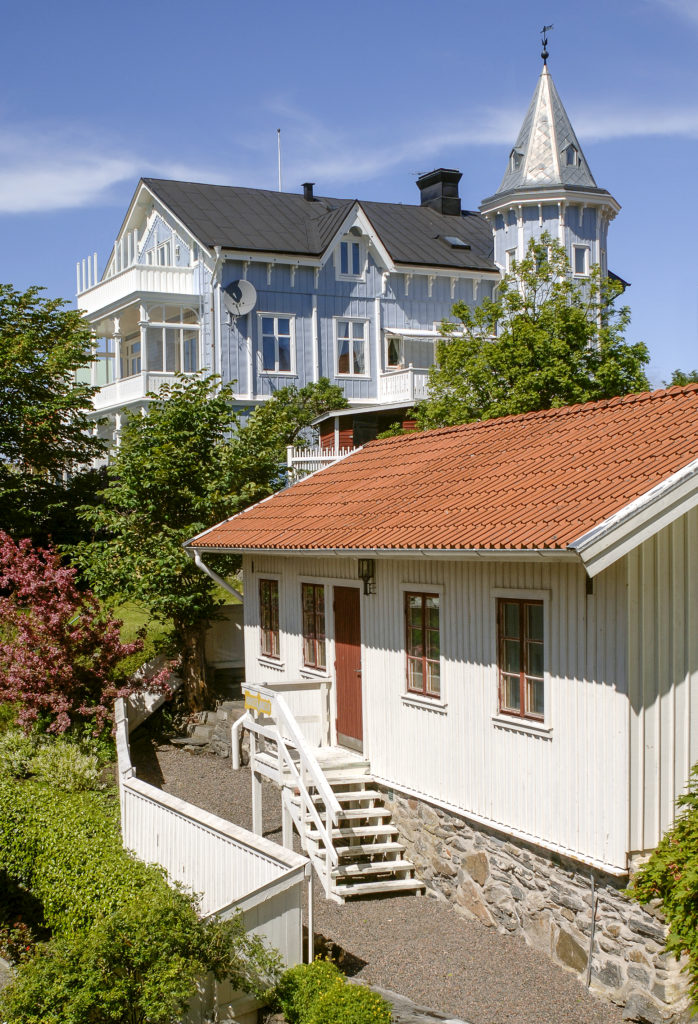
The structure in the foreground houses Marstrand’s History Museum. I noted the house in the background is the same house in the background of the previous photo. Alma and the laundry.
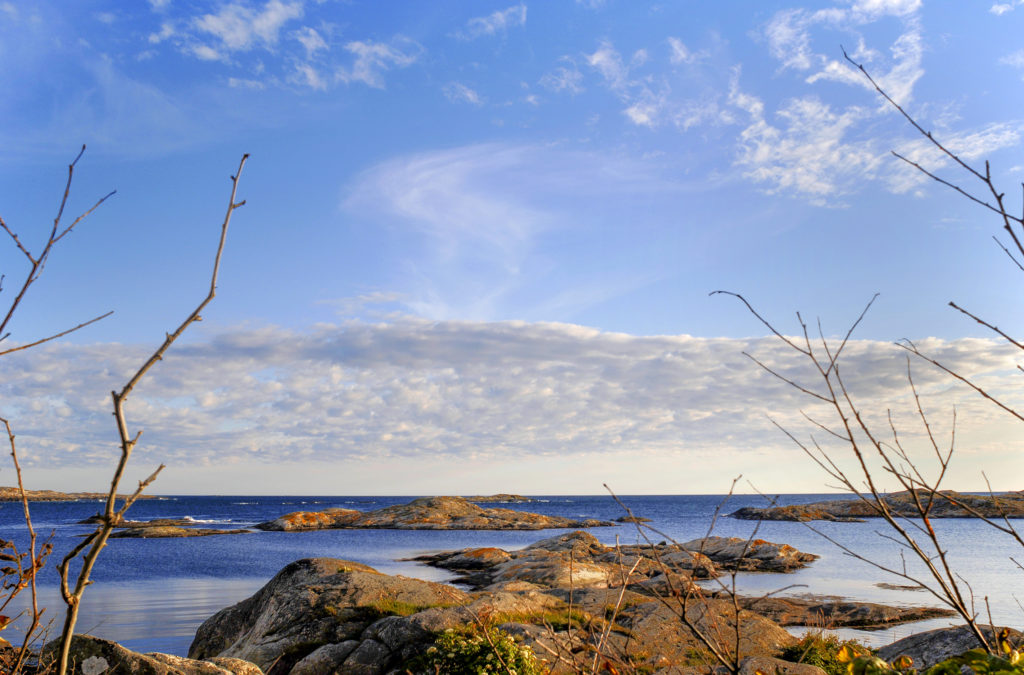
Temperatures dropped significantly in September. Two weeks of thunder and lightening finally yielded to a bit of sun. Gunhild and Greta took that as cue to go swimming. But the water was 5 degrees Celsius. “We thought it was most invigorating, and when I got out of the water my body was a rather lovely shade of blue.”
Alma had a birthday in September. She seemed to rally a bit. Greta thought it was because Gunhild was there and the summer guests had all left. One Sunday there was a party for Alma. Ladies gathered for coffee. And in the words of Gunhild, they ate “a lot of junk.” Almost every one of them ate 6 to 7 pieces of coffee bread, cookies and birthday cake.
“The price of fruit, vegetables and cheese is so high, they don’t eat properly,” she wrote to Keith. Shortages only worsened as time went on.
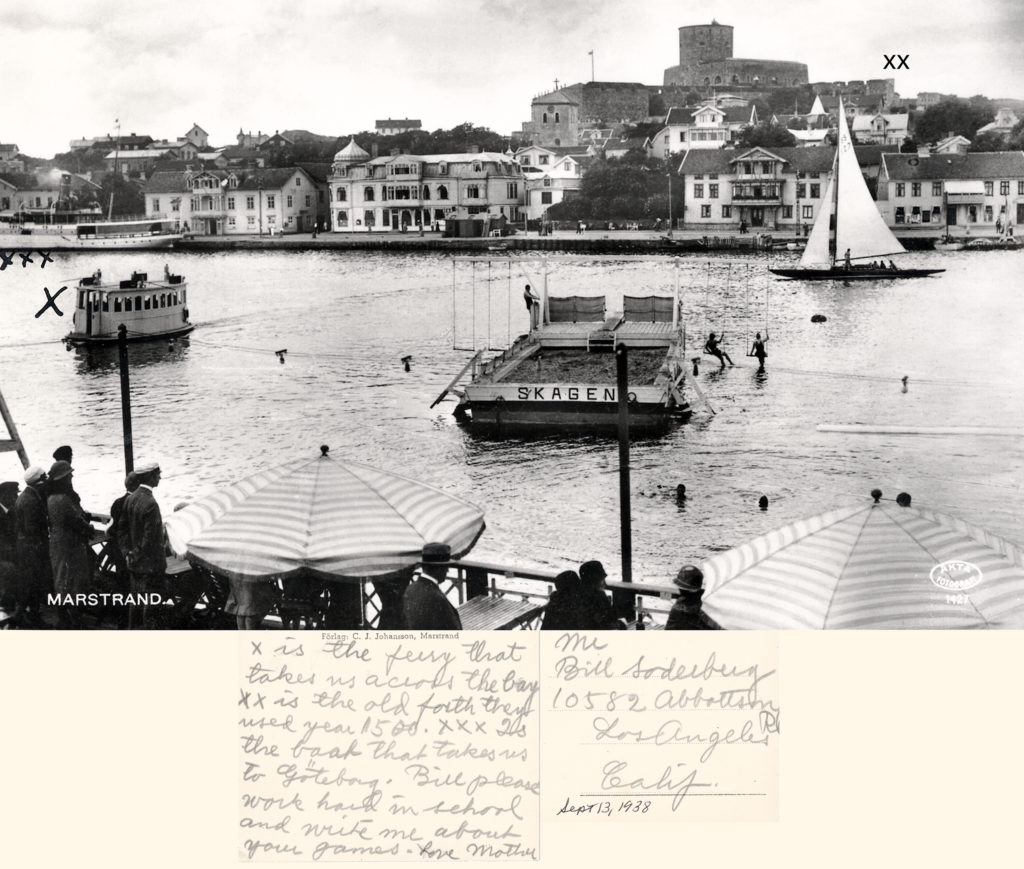
Post Card Gunhild sent to Bill, September 13, 1938. The single X marks the ferry from Koön, the neighboring Island, to Marstrand. The double X indicates Carlstens Fortress. Triple x is the ferry they rode from Göteborg to Marstrand. 1938 is the year a road from Göteborg to Koön was begun. Greta remembers the sound of dynamite used by the road builders.
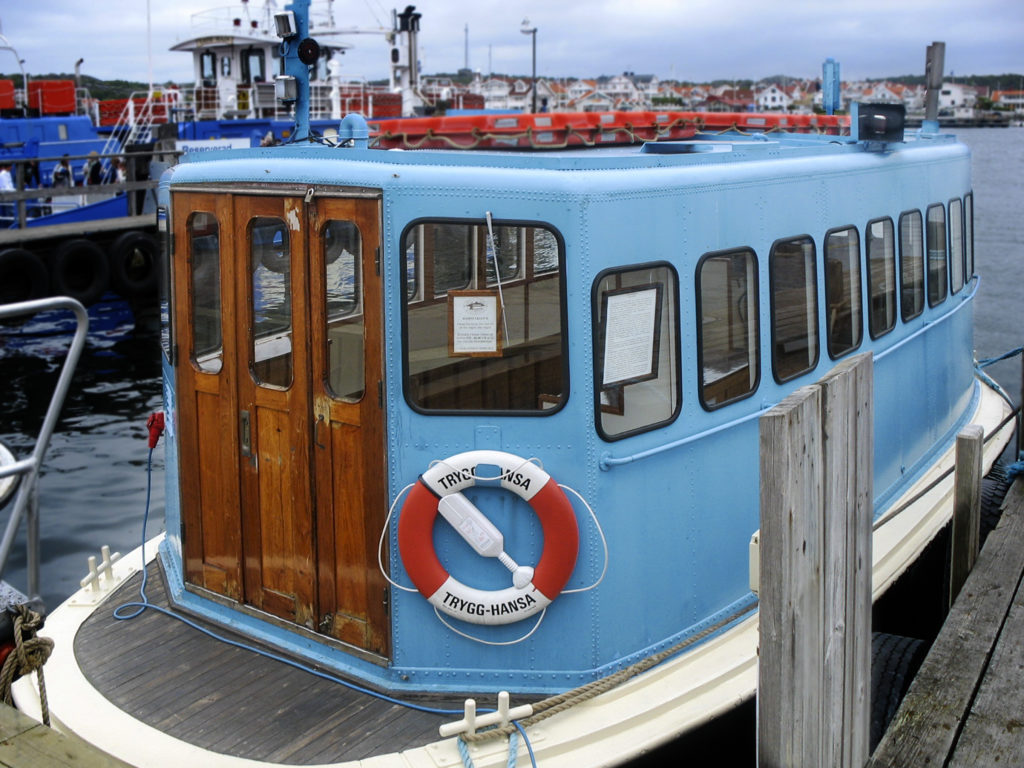
The old style ferry boat–also shown in the post card–was retired and replaced by a larger modern vessel. The old one lives on today as a boat for hire. Tours and parties.
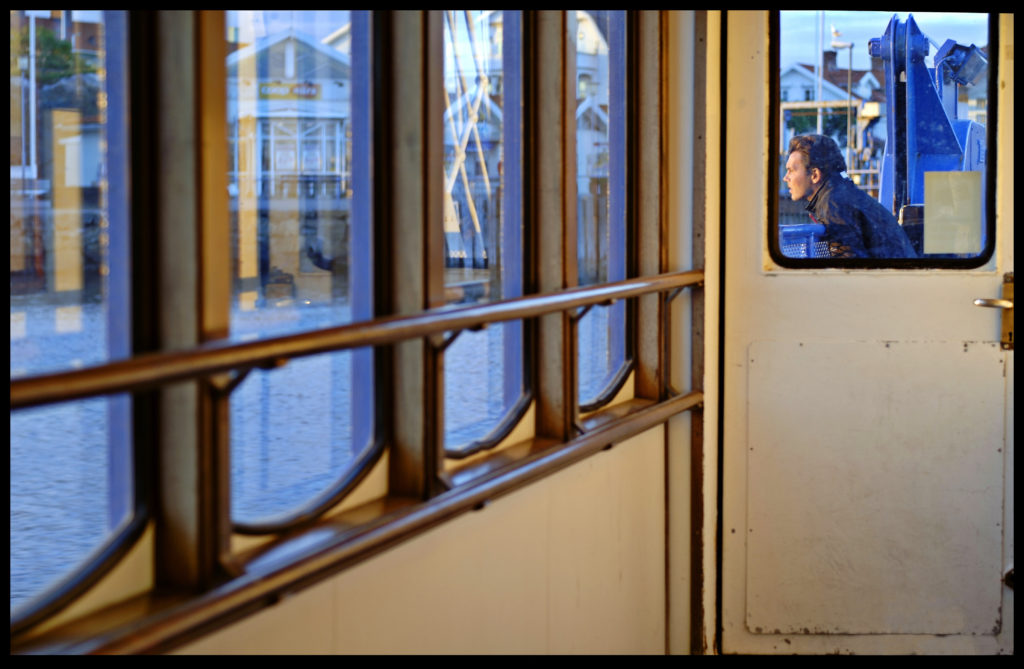
Modern Marstrand Ferry. The shoreline of neighboring Koön island in view. Today’s Marstrand is not only the historic small island but also includes Koön island and Marstrand Island. There is still only one way to reach Marstrand island. By water. Swim, boat or ferry. The bay crossing by the one and only ferry between Koön island and Marstrand takes only a few minutes.
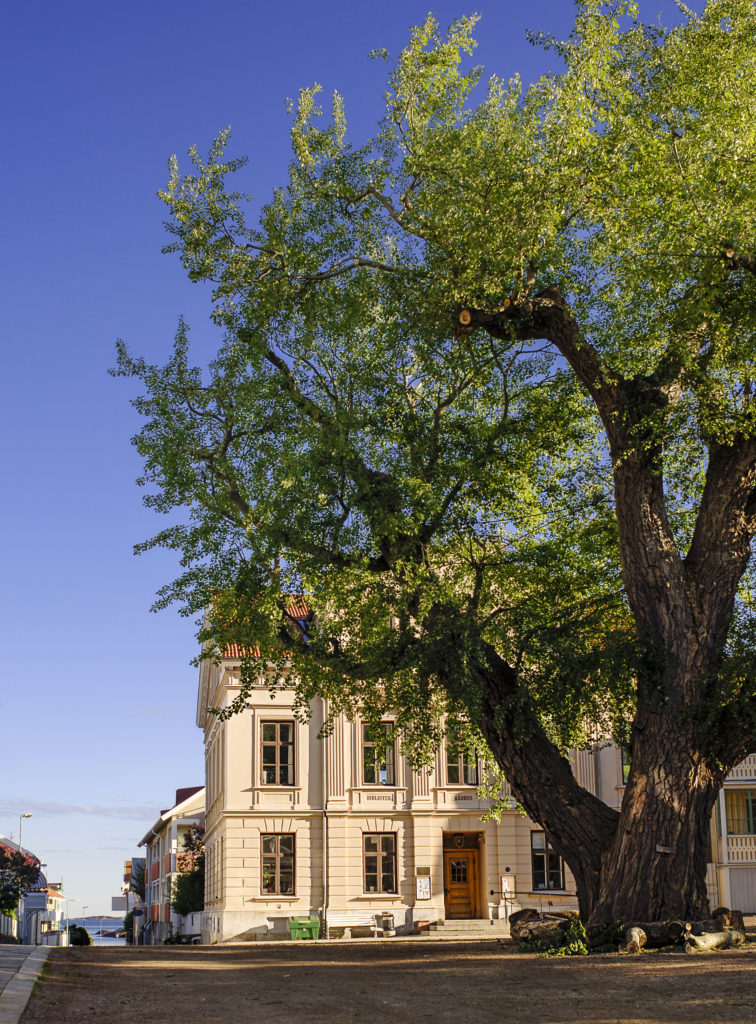
Town Hall dates from 1647, and is the oldest secular structure in the Bohuslän province. In the days of witch trials, the cellars held indivuduals awaiting execution. If the old poplar tree could talk, it might say it remembers all the times members of the Palm family had walked by. And when Greta ran errands. It was a younger smaller tree she saw on her way to the butcher or the baker.
It was while running an errand Greta was involved in a “freak accident,” by Marstrand standards.
No boats were involved. Not even the fierce lightning which grandfather August said often struck people “in these parts of the country.” She was struck, but it was by the only motorized vehicle on the island. “There I was lying flat in the street. I couldn’t move, not even to cry.”
The breadman was nearby and placed her into a large bread basket. They went to the nearest house while others ran to find and fetch Gunhild.
“According to Mama, I was black and blue and bumped and scratched all over. She patched me up. And within a week or so I was nearly back to normal. More or Less.”
German soldiers, snow in Marstrand, and Christmas.
CHAPTER 6: “THEY EAT CHILDREN.”
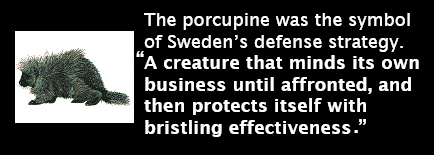
Greta remembered “Everyone held their breath because there was much talk of war. The Swedish people were given instructions for many different situations.” There were steep increases in sales taxes and income taxes. Duties were levied on imported goods. All to pay for stronger defenses. Swedes actually gave more from their pocket than its government asked through various charitable groups.
Germany wielded influence over Sweden through various threats and reprisals. Gunhild mentioned how Sweden needed medicine and vaccine for an out break of Hoof and Mouth Disease (Anthrax). Their request to Germany was answered with a resounding “NO!” Hitler reiterated a familiar and phony claim he used when taking Czechoslovakia. He said northern Sweden, and the iron ore mines, were “old German territory.”
Those Machiavellian tactics also affected life in Marstrand. By 9 P.M. the streets were empty. Almost everyone was inside. “The Germans like all of Marstrand to be ‘tucked in’ for the night,” said Gunhild.
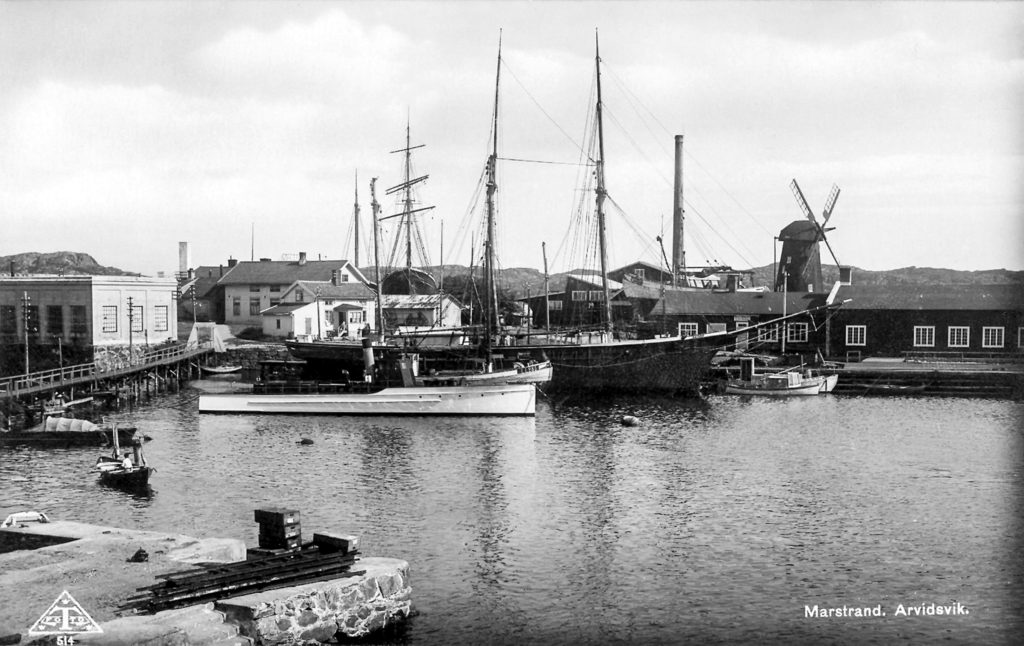
Children knew an element of fright at this time as well. They were told they must stay away from the German soldiers because “They eat children.”
“One dusk evening my mother was working at the hospital as a volunteer nurse. Grandfather was supposed to watch me, but I left the house and went ‘exploring’ down by the wharf. I saw a couple of ships anchored there, each having the big black German cross on the side. I hid in the bushes to watch. I wanted to see what kind of people ‘ate children.’ I hadn’t seen a German up close before. I watched as they loaded the boats. ‘Why, they look like regular people,’ I said to myself. Suddenly, right beside me I saw a pair of shiny black boots. I looked up slowly and gasped. It was a German officer!! ‘Oh, he’s going to eat me,’ I thought. My heart was pounding wildly. If I could only disappear into the air or something.
“The German officer was very tall and blond with the most startling blue eyes I had ever seen. They were kind eyes; they were smiling too. He leaned over and patted me on the head. Gently he said in Swedish, ‘run along home, little girl. You shouldn’t be out here so late.’ I bolted up and took off running as fast as my legs could carry me, never looking back, till I reached the house.”
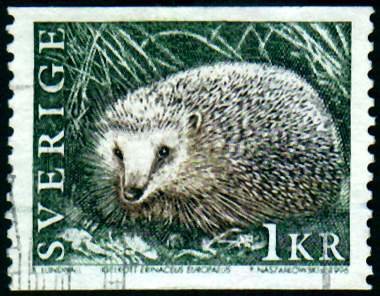

The porcupines (actually they’re hedgehogs in Sweden) that Greta knew came near the house to drink milk left out in shallow platters.
“They let me carefully touch them. I’d never seen a real porcupine before. I was much intrigued by the quills and HAD to touch them.” When the last porcupine disappeared to hibernate, winter seemed official.
“The trees lost their leaves and looked like hungry skeletons reaching for the sky.”
The sun wasn’t visible for days. A biting wind swept off the North Sea without break. “When you breathed it felt like tiny icicles piercing your lungs,” said Greta.
Gunhild wrote to Keith and Bill steadily. Not only to bridge the long distance of separation. But she needed funds for cold weather clothing. Perhaps she had not anticipated their stay lasting into winter. Undoubtedly all measure and calculation of this was related to Alma’s condition. By winter She was only able to make coffee visits. Otherwise she rested as Gunhild took over all household work. Yet perhaps she seemed stable enough for Gunhild to suggest Keith might visit next summer. Better summer than winter because of the cold sharp wind that “seems to blow right through you.”
Greta noted “They make a big fuss over Christmas. Everyone prepares for it.” August and Alma had standing annual invitations to an extremely fancy celebration at City Hotel. Only long term full time residents were invited. Not the seasonal residents or visitors. No invitation for Gunhild and Greta.
Gunhild planned a home menu of ham, head cheese and sausages–among other things. She teamed up with a neighbor to produce dozens of “rich, fattening, flavorful sausages filled with lots of delicious herbs and spices.”
Gunhild said, “Lots of cholesterol! They eat many things here which are not good for you.” The Californians missed all the fruits and vegetables readily available back home.
“Mama made her own head cheese, too. I remember seeing it sitting on the sideboard wrapped in a white cloth and squeezed down in place with an old fashioned flat iron.”
Alma complained of feeling ill all the night of December 16. A Doctor came. Her nausea and diarrhea was from stomach cancer. Her condition was eminently grave.
A continuous lengthy drift of snow, the season’s first, came to Marstrand on Monday December 19th, 1938. It was with the appearance of this wintry white blanket Alma Katarina Palm passed from earth.
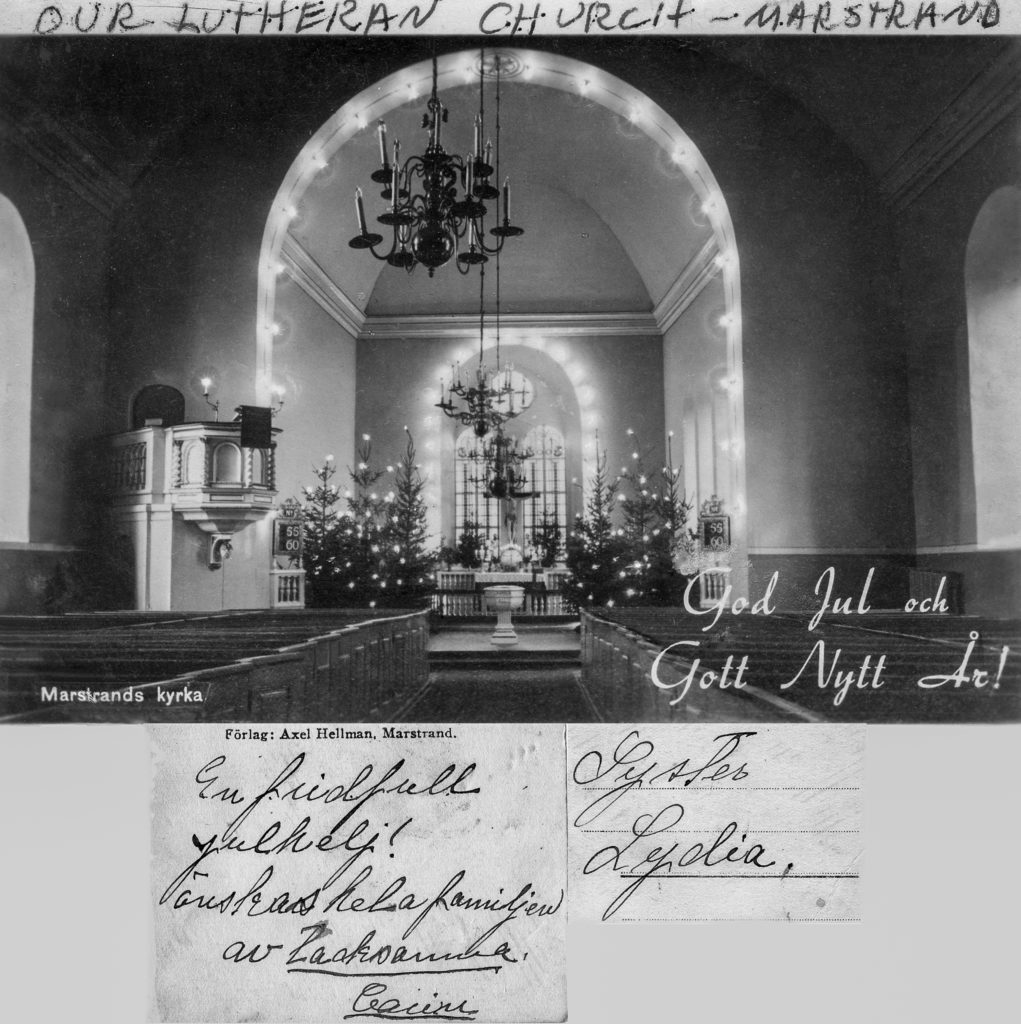
Her funeral was at Marstrand Lutheran Church.
The church service was set against a backdrop of flowers and six large Christmas trees decked with lights. “Everyone said the funeral was beautiful. I thought so too–as far as funerals go,” Said Greta.
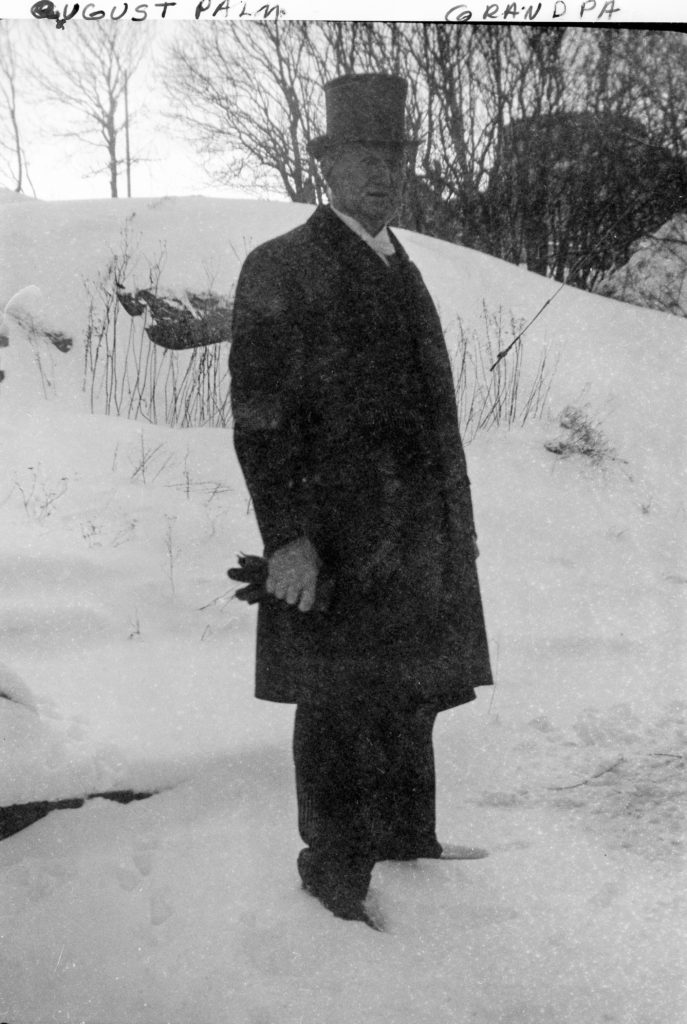
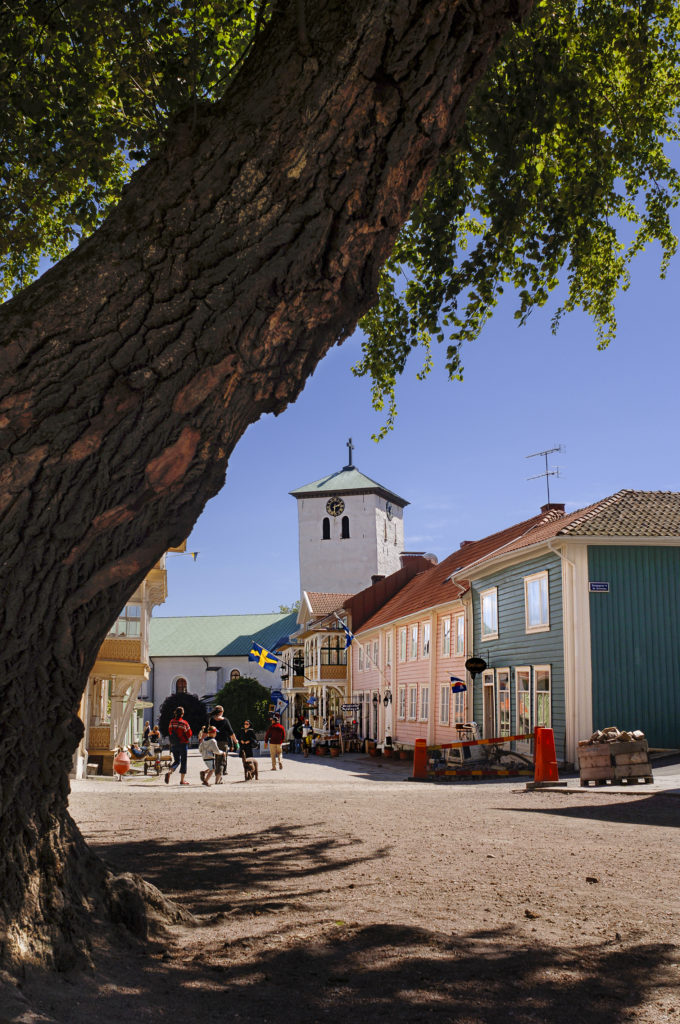
The old poplar tree in the middle of Marstrand’s concourse was witness to that snowy day in December of 1938 when family and friends gathered at Marstrand Lutheran Church (center, with clock tower).
A cafe, Bergs Konditori, was contracted for the gathering after the funeral. Pastries and coffee were served. The cafe was decorated for the occasion.
Gunhild’s sister Margit seated left. Margit, in from Stockholm, stayed up all night with Gunhild at Bergs Konditori to catch up on fifteen years of being apart. Plans eventually emerged for Gunhild and Greta to visit Margit in Stockholm.
Present site of Berg’s Konditori. It wasn’t at this location in 1938, but this store front then contained Greta’s favorite pastry shop where the doll party miniature pastries were given to her.
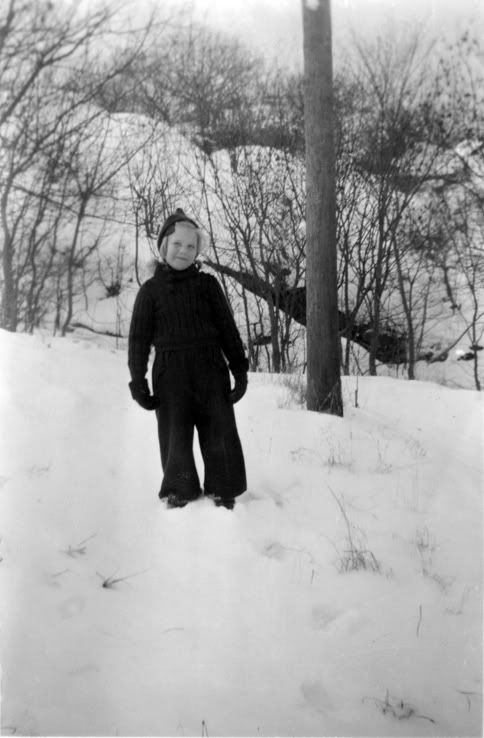
“Christmas came and went quietly. After Christmas I received my first pair of ski pants. I had never seen snow before. I noticed one day how it settled clean, white, and sparkling on a metal rail.” Greta touched this delicate sight with her tongue and suffered instant frozen fusion with the metal. No give or release to all her effort to extract herself. Her attempts to scream and cry for help amounted to no more than garbled tongue-numb utterances heard by no one. Fear, panic, desperation were focused into one “do or die, now or never” YANK.
“Blood was running down my chin and I realized I left a portion of my tongue on that treacherous rail.”
CHAPTER 7: Adventures on Ice.
In the midst of Winter that early part of 1939, Gunhild had more than fulfilled her Swedish family duty. She was homesick and ready to plan their return home. She wrote to Keith and asked for fare money. As soon as feasible.
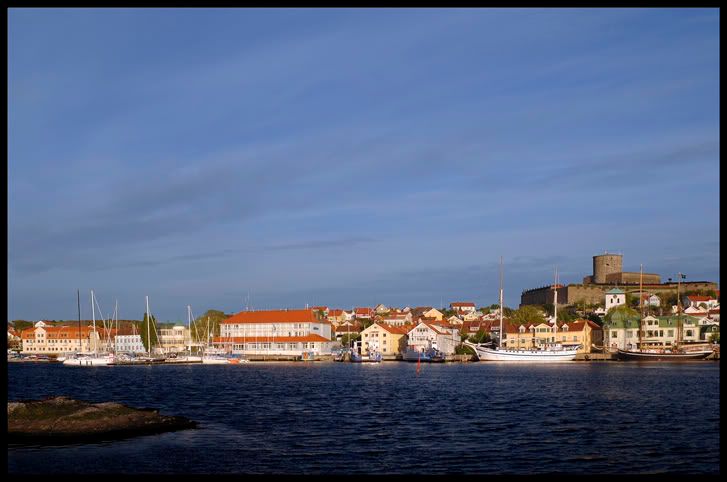
She also described to Keith some of Marstrand’s famous boat races. Norway’s Crown Prince Olav participated in one.
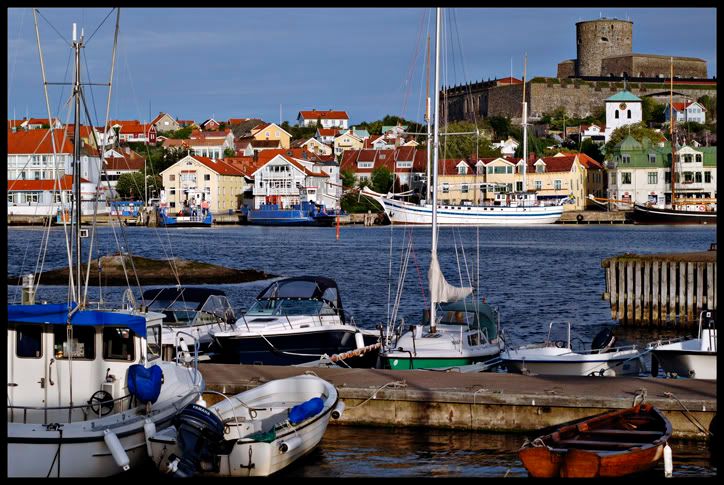
That year Gunhild and Greta also went boat racing.
“We didn’t win, but it was very exciting. When the race was over, everyone was all wet from the stormy conditions. The ocean was so rough and wild it was hard to dock. I received a severe injury to my leg trying to disembark,” Said Greta.
Greta’s fifth birthday was in February. Gunhild threw a little party attended by Greta’s friends. They ate cake and candy along with servings of coffee and tea.
One rainy day in February Gunhild commented they hadn’t seen the sun in months. “When it isn’t raining, it is cloudy and gray.”
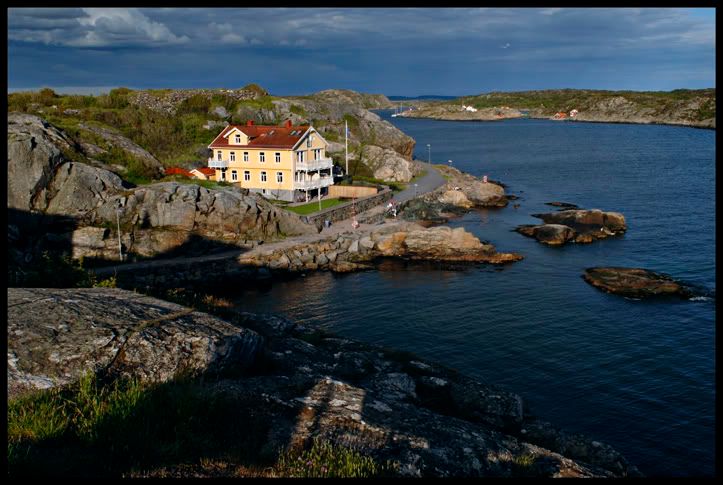
It seemed no matter if it was winter or not, if the opportunity presented itself for them to go swimming, they did.
Greta recalled, “In February, there were ice floes breaking up in the ocean. I tried sitting on those chunks of ice. Talk about a frozen behind!!! Our bodies became numb from the cold, and quite blue, I might add. But the feel of our blood surging through our vessels was exhilarating. One really felt alive.”
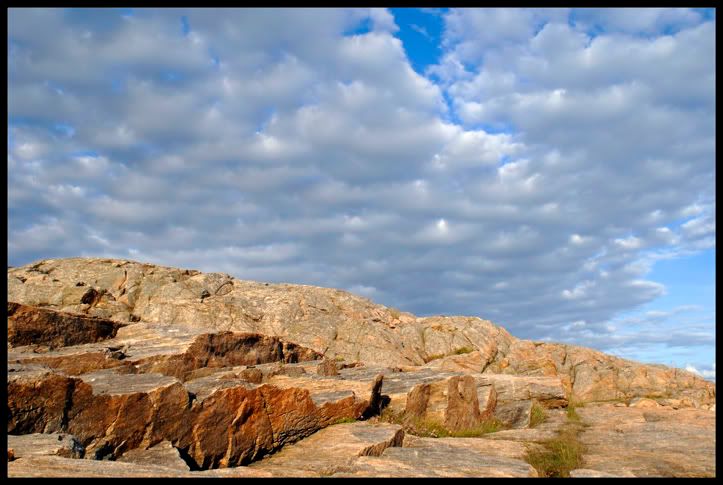
“When it wasn’t raining, we went for long walks.”

If one simply walks, it takes about an hour to go around the island. But with so many interesting rock formations, delicate plants or flowers, and vantage points to enjoy, it takes longer.
“It was still very cold but the air was clear and crisp. I don’t think I have ever again found the air so pure and energizing. Marstrand was so beautiful, unspoiled and healthy.”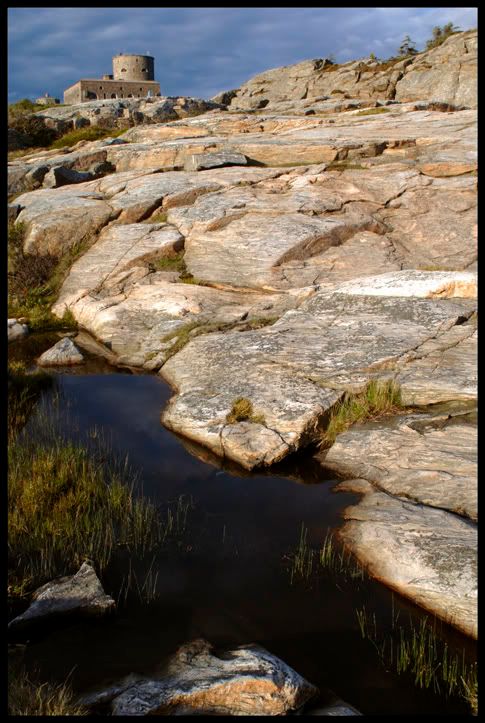
“I explored the rocks and looked for shells and tiny creatures trapped by the tide among the crevices. It was a whole different world there. I discovered many types of strange creatures. Some were in shells. Others were creepy, crawly, slithery things. Some had strange colors. Others had no color, and were transparent. I was fascinated.”

“It felt so good to breathe the fresh air. Such a smell!!! Tainted with ocean salty smells. There was nothing like being at the North Sea.”
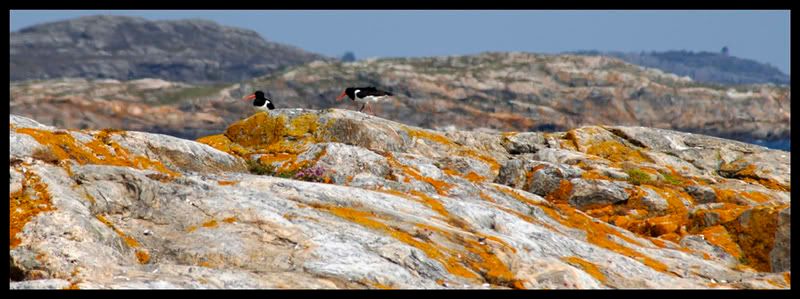
Marstrand Wildlife
“After days of glorious clear weather it again stormed with the wind crackling around the house. It moaned like someone in great pain.
When we went out in the snow or very cold weather, we ate a thick slice of dark bread spread with bacon drippings saved in a jar by the stove. As disgusting as it sounds, it was quite delicious. It gave us a lot of calories to burn and kept us warm as we ran around in the snow. Another trick I learned when I went out in the cold was to put hot boiled potatoes in my pockets to keep my hands and body warm. Then later when they were cool I ate them when I was hungry.
At Mama’s friend’s house we made a toffee with nuts . When it was boiling hot we dropped dabs of it in the snow from a wooden spoon. Within seconds the dabs were hard and cool. We either ate it or put it in a dish for later. But was most wonderful when still warm.
When it was frozen all around the island, there were skating parties. Groups skated around the island and ended up at someone’s house for hot coffee and glogg.“
Glogg, meaning glow is a Scandinavian beverage typically associated with winter, but especially the Christmas season. It is made with combination of red wine and akvavit (a beverage distilled from potato or grain. It may be flavored with caraway seeds, anise, dill, or coriander). Added to the mix are raisins, slivered almonds, diced bits of dried or candied fruit. Recipes vary. But the festive part comes when everyone gathers around to watch the lighting of the glogg. Sugar cubes in a cone strainer are dipped into the mixture then lifted back up. A lighted match to the alcohol-drenched sugar gently ignites a flame. Thus the burn, the mull, the glow or glogg. The glowing sugar is mixed into the kettle of combined ingredients, and the glogg is ready to serve.
It warmed you to your toes, said Greta.
These parties were a Swedish feast. Smorgasbord, they called it. Fruit soups, roast pig, goose, fish, meatballs and sandwiches.
Boats around the island were locked in place when the ocean froze. Owners could walk to their boat, cut a hole in the ice, and extract it for storing elsewhere. The sight of the hole and the fresh skin of ice intrigued Greta. But this was forbidden territory. Gunhild specifically instructed Greta not to play there. But five or six playmates didn’t have this restriction. When she told them she couldn’t go, they goaded her along by calling her names. Scaredy Cat, Chicken, a Mama’s Girl. She didn’t stand for that and ventured out.
Before long Greta encountered the sight of her fascination. A freshly cut boat hole. It drew her over to inspect its icy glaze. Her application of just one booted foot to the surface was enough to plunge her into the wintry ocean. Her once warm clothes and mittens turned instantly cold and heavy. Fortunately her fingers found the edge of the thick ice.
I was too shocked to panic. I didn’t even cry out. When the children realized I was missing, they came back to find me. There I was peering up at them. My only thought then was how angry Mama would be. The oldest boy, maybe 10 or 12 years old, shook his head and reached into the water and pulled me out. I stood on the ice shivering cold and motionless. I better walk you home, said the boy.
When Gunhild appeared at the door and saw Greta standing there in her stiff frozen snowsuit, the only words uttered in reference to the miss hap were the boys. She fell into the water.
Mama didn’t scream. Mama didn’t yell. Mama didn’t spank me. Not a word was ever discussed with me concerning the incident. Instead Greta received the warm blanket treatment. A brisk massage for her cold limbs. Hot tea. Then off to bed warmed up with hot water bottles.
There was a unique day in March every year for the Palm family. Gunhild and August shared the same birthday, March 12. Particularly noteworthy of that year, August was 70. Gunhild planned a special party. A farmer came to the house and took her order for a select leg of veal.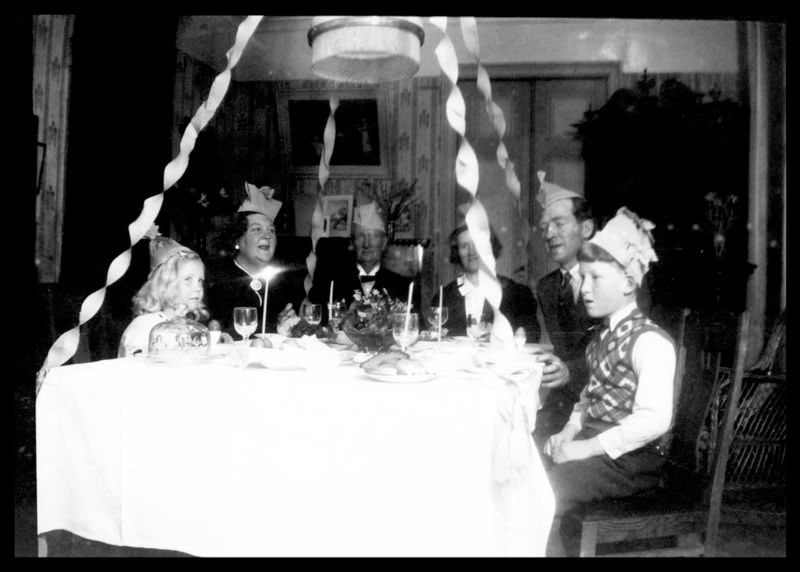
Birthday party for Gunhild and August. Greta, Gunhild and August left side. Greta’s best friend Gunnar and his parents, right side. After the feast other guests arrived for cake and coffee.
In March 1939 Germany annexed the remainder of Czechoslovakia. Suddenly all eyes were on Poland. Gunhild wrote that Hitler considered banning tobacco and coffee in Sweden. What would the Swedish people do without their coffee? It was just a reminder that Hitler hadn’t and wouldn’t forget about Sweden.
The heightened political tensions led to a call for to all foreigners in Sweden to fill out forms and be counted. Gunhild and Greta complied.
Gunhild seemed to become a bit restless with the quiet life in Marstrand. It is very quiet here so I think I long for noisy places. I haven’t been in a car since July 11. She anticipated a visit to Stockholm since Margit’s visit to Marstrand in December. When the funds finally arrived from California, they were off to Stockholm.
CHAPTER 8: Stockholm!
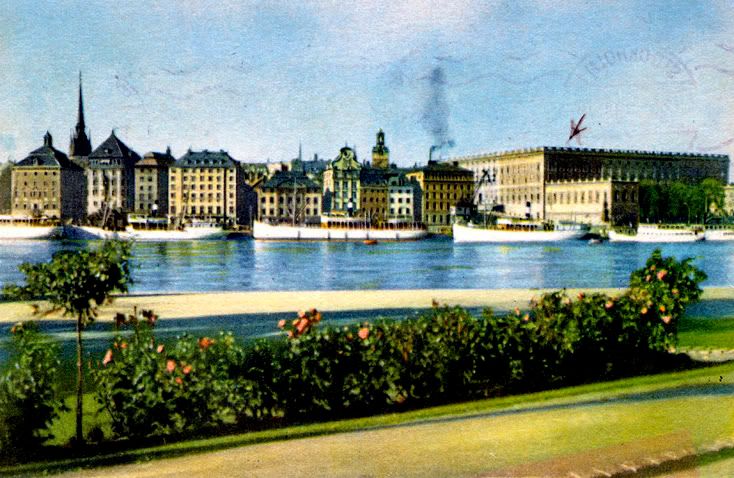


“Stockholm was a very cosmopolitan city even in those days. Mama was eager for me to see as much as we could,” as Greta recalled.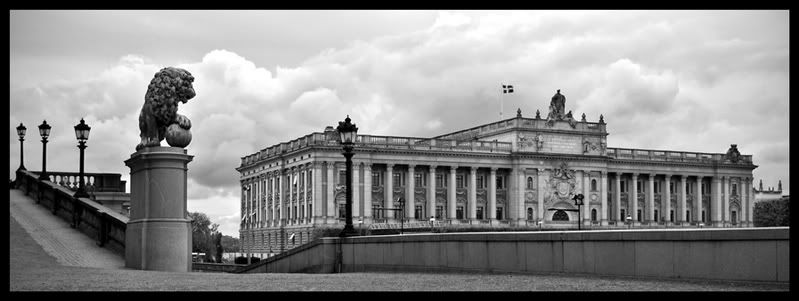
Stockholms slott (Parliament building. The lion is part of the Royal Palace), 1690-1704
“We visited the place where the king ‘lived.’ All I remember is a very huge building with lots of massive carved furniture and lots of red velvet.”

“We saw the opera house which was also immense and we admired the architecture which was very old.” Opera House (Operan, 1887) in this photo behind/through the Viking boat mast.

Nationalmuseum (National Museum), 1846
“The museum was very interesting to me as I loved to hear stories about Vikings. This museum held many artifacts from that time.”
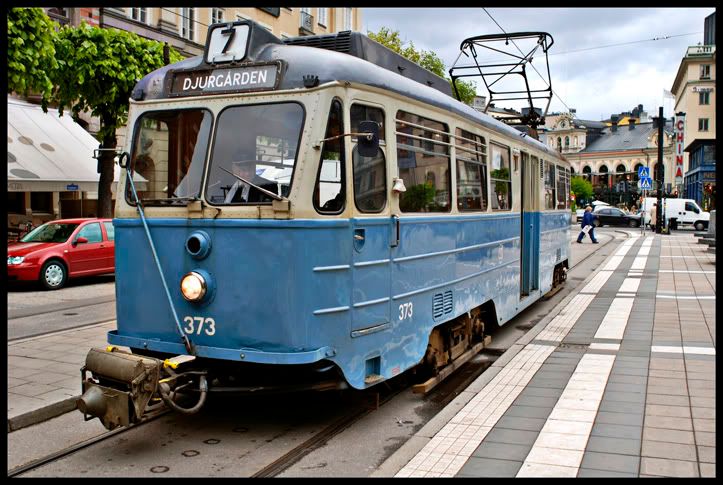
The old street car today delivers limited service. Linking central hotel and shopping areas with Djurgården where many of Stockholm’s important museums and cultural sites are located. Tunnelbanan, the Stockholm subway, moves people nowadays. The first installment of Tunnelbanan was in place during Gunhild and Greta’s visit. The main period of construction, however, began in 1944.
“There were little street cars taking people here and there around town. We rode on them many times. There were also horse drawn carts, too.”
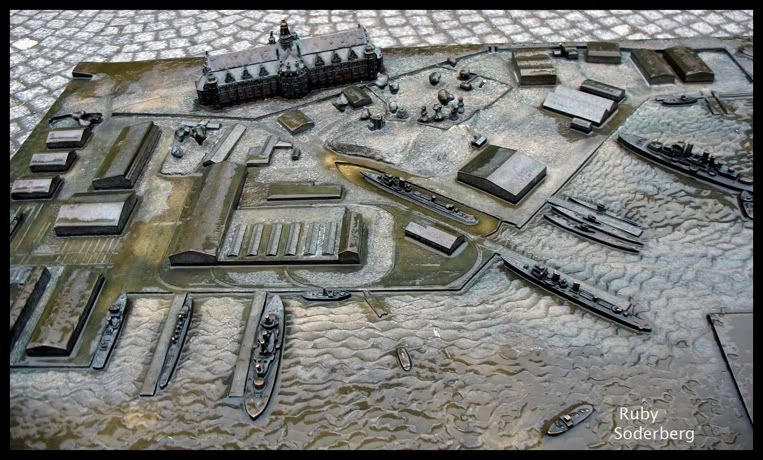
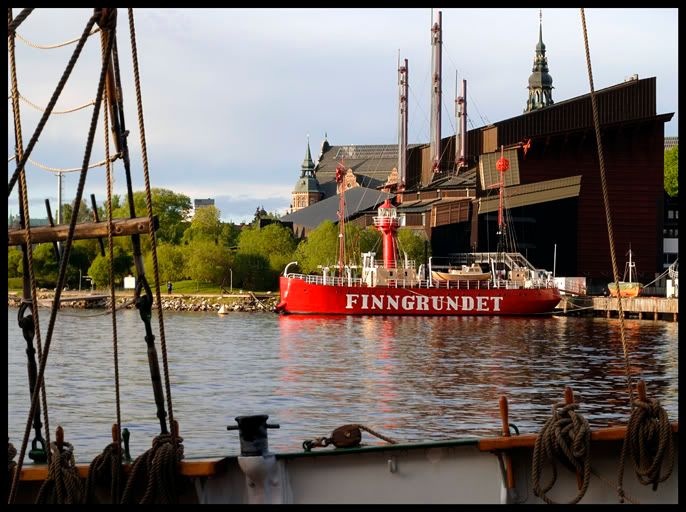
Above is a relief map/sculpture is of Stockholm Harbor about the time Gunhild and Greta were there. Bottom photo is a view toward that area depicted above. Nordiska Museet (Nordic Museum), 1889. left, rear. Vasamuseet (Vasa Museum), 1987, Center/Front (Behind red “light house” boat).

“We visited several parks, also, and I fed the pigeons.”
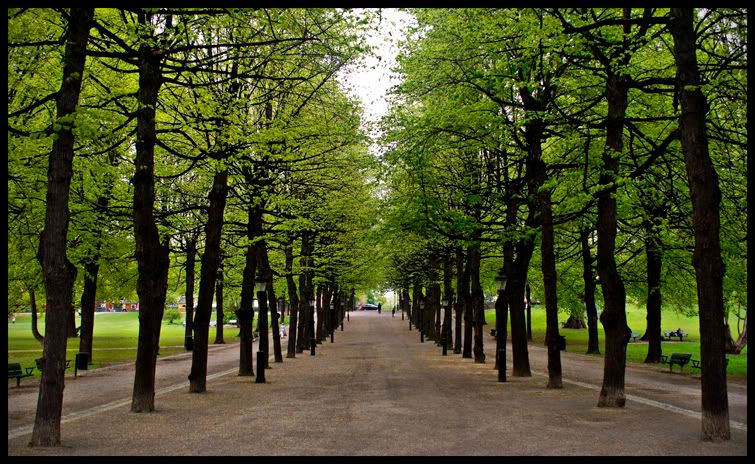
“The parks had numerous beautiful trees. We selected one particularly tall and shady one under which we sat and ate our lunch.”
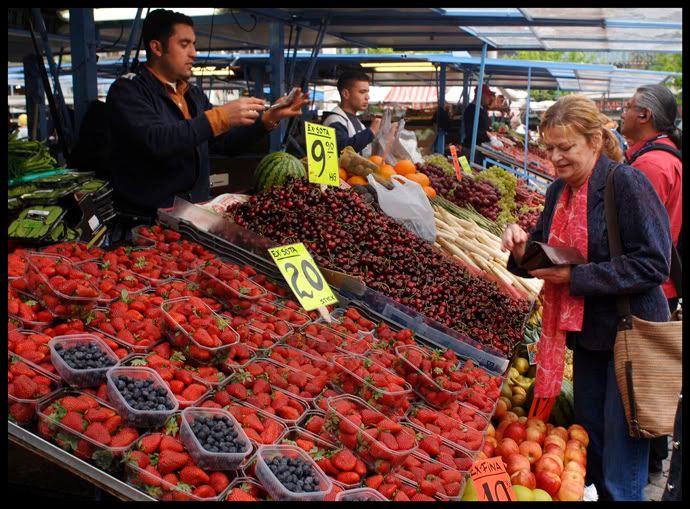
Stockholm Market
“Most of the time we stayed at Aunt Margit’s with her husband, my uncle, and my cousins. Their apartment was outside the city. They ran a store which sold candy, fruit, flowers and vegetables.
“We took trips to the suburbs and visited other cousins of Mama’s. I remember visiting a farm with lots of animals; sheep, cows pigs and chickens. I was allowed to gather the eggs and feed the chickens. There was one particularly nasty rooster which would fly at me and scratch my legs until I finally climbed up on a woodpile to escape. I would cry in terror until I was rescued.”
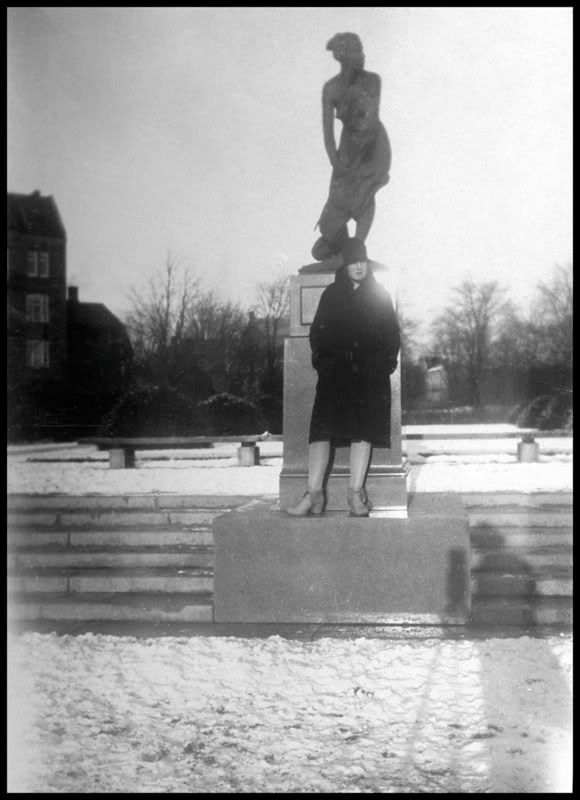
Guessing this may be Margit in Stockholm. The city boasts of as many civic statues as the U.S. has of Starbucks.
Art is a valued aspect of the city plan.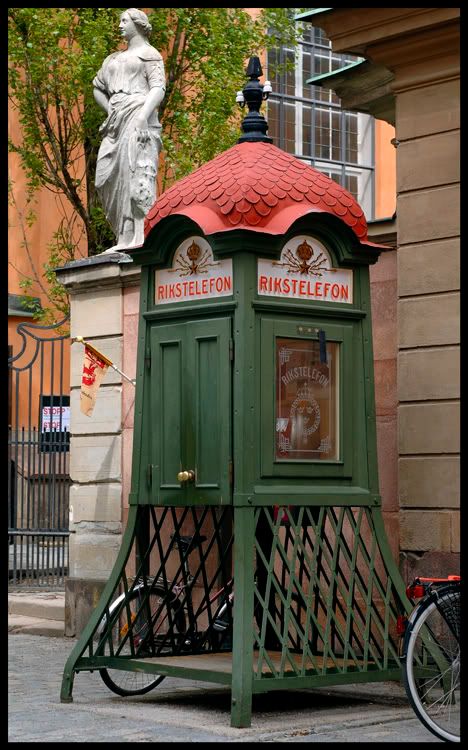
A sight Gunhild and Greta would have seen in Stockholm. These old phone booths. If one examines the Marstrand post cards carefully, this style of phone booth was in Marstrand as well.
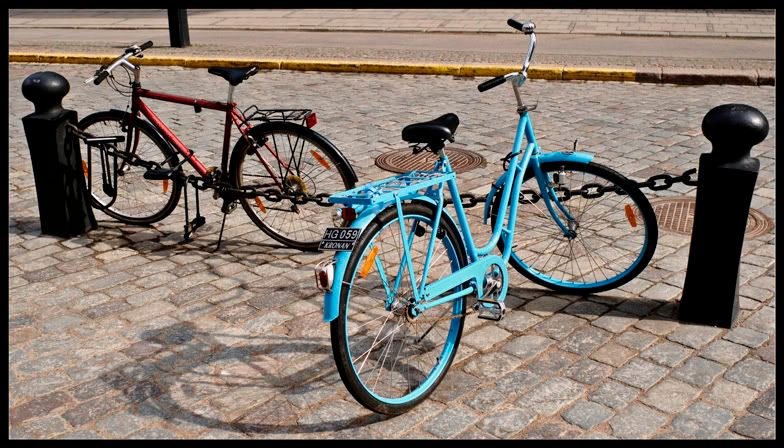
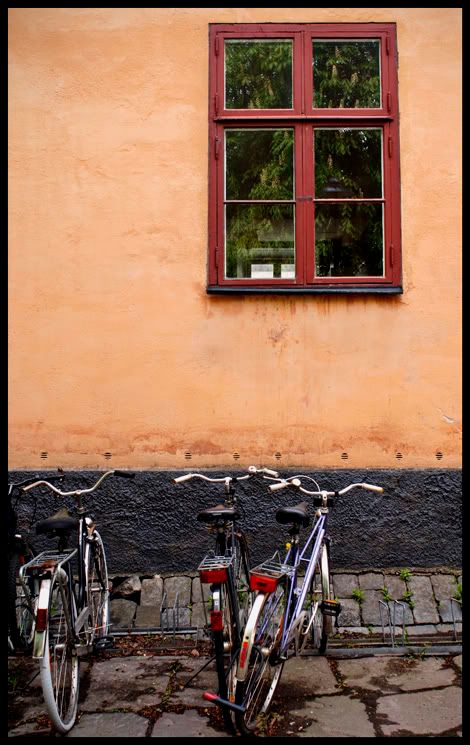
By September of 1939 Swedes all took to bicycles when gasoline was rationed. Today large numbers of all Scandinavians utilize bicycles for routine travel.
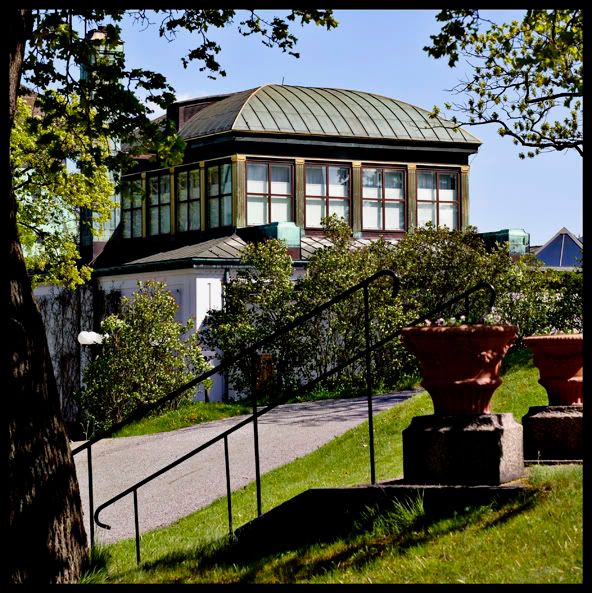
In Marstrand one day Gunhild recognized a visitor. King Gustav V’s brother Eugene. He was an artist. This was his home in Stockholm. Today it is open to the public as a fine art museum.

The lion statue guards Parliament Building on the left. The spire is Riddarholmen Church, Stockholm’s only remaining medieval building from 1280.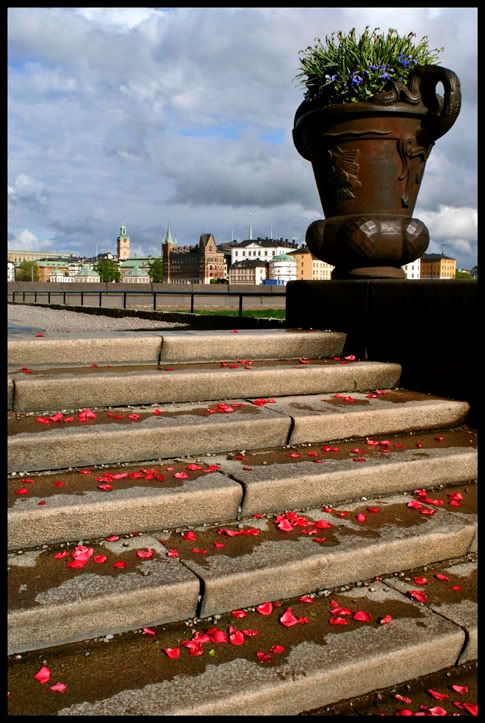
Gunhild and Greta were in Stockholm for a month. But their path was less rosy after an outbreak of scarlet fever.
“Mama was anxious to leave Stockholm, but when we returned to Marstrand, it was already hit with 8 cases.”

Sunset in Stockholm
CHAPTER 9: Midsommer to Christmas

“It was a beautiful spring and early summer. The cherry trees were in fragrant bloom along with all the rest of the fruit trees.”

Gunhild and August prepared the house for the summer guests.
By July Marstrand was in high season as the town was filled with tourists. Gunhild spent mornings attending to guests. Then typically she spent afternoons with Greta at the beach swimming. By 5 P.M. they were back home for dinner. Greta went to bed around 8 P.M. Then Gunhild went out again.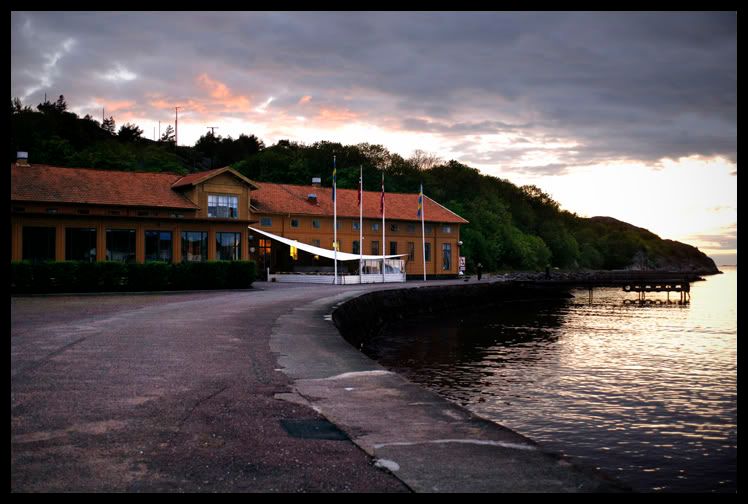
“Sometimes she’d go for a walk or listen to music somewhere. There was a two day celebration where Mama danced for the whole two days with some of her old friends.” This was an event to raise money for road improvements.

The celebration of the summer solstice in Sweden is called Midsommer. This holiday rivals if not surpasses Christmas in popularity. The third Friday in June starts the holiday and is celebrated all weekend long. Swedes head to the countryside in droves to commune with nature, participate in celebrations of food, drink and dance. Special emphasis is on drinking in many instances. Swedes remaining in cities have parties lasting all weekend. Much anticipation and preparation is devoted to Midsommer. It is much the “talk of the town” weeks and days prior.
Greta enjoyed Midsommer in a most traditional way. She was adorned in a Swedish costume and danced around the majtång, a May pole.
As the summer progressed Greta lost all track of English in her mind. She thought and spoke only in Swedish. And she became a strong swimmer. Once when Gunhild swam far from shore Greta swam right behind her waving to the boats along the way. Gunhild happened to look back and was surprised. “I thought she would faint right there in the water,” said Greta. “She knew there was no sense in wasting her breath in telling me not to go. But I had to promise to wear a swim ring.” It wasn’t long before the swim ring was discarded entirely. “I could swim a long distance and not be tired.”
The enjoyment of those activities only in some degree ameliorated a heavier burden constantly weighing on Gunhild. The sadness she felt having been separated so long and so far from her family in Los Angeles. Bill graduated from High School and was on the precipice of adulthood. Gunhild missed all of Bill’s football games, his track meets, meeting the girls he dated, and his graduation ceremony. The passing of that time with so many events left her feeling forgotten about. And missing her husband Keith.
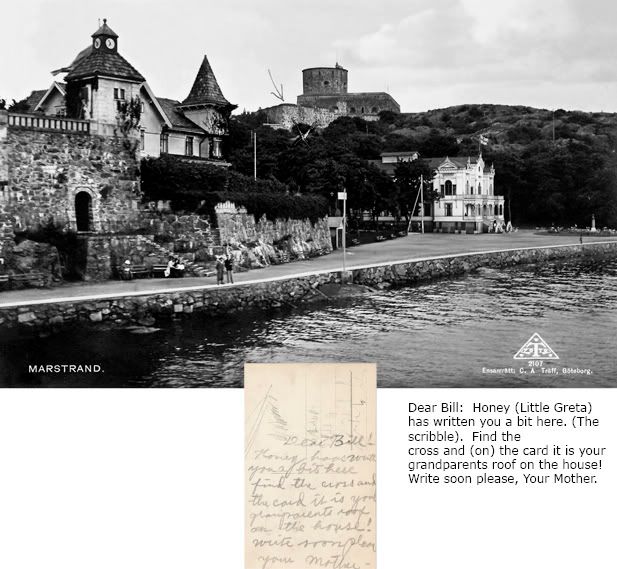
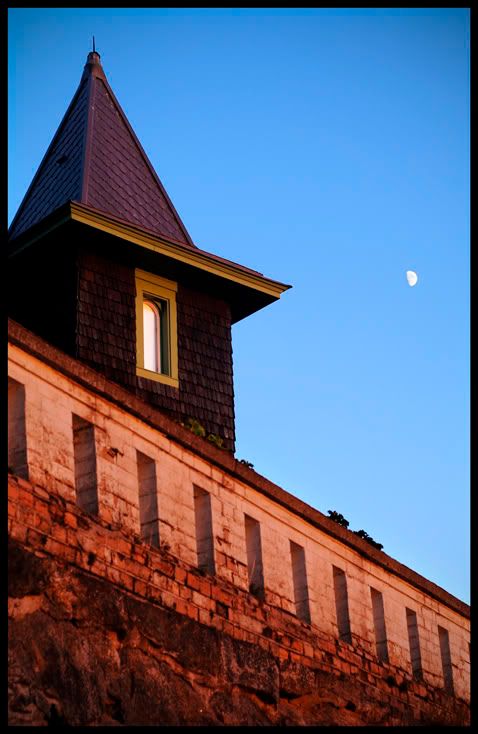
Ë™
With each passing day a way out of Sweden became more difficult. The Oceans brimmed with naval traffic. Warships and U-Boats. Line companies kept more of their vessels in port. With fewer ships carrying mail, a letter was more difficult to send. Nothing direct. Routes only found U.S. ports eventually.
“We should like to get started for California the last of August if not before. You see, the fall storms are very bad. They start in September and last through Christmas. Winter weather is not very pleasant to make a trip with a child,” Wrote Gunhild. She requested $200 by August 5th.
$200 in 1939 was no small amount of money for Keith and his policeman’s salary. He was loath to borrow money. Now he had to. The time taken to network his friends and family for loans went well beyond August 5th.
In the mean while Germany invaded Poland on September first. Two days later A German U-boat torpedoed a British liner en route from Liverpool to Montreal. Of 1,400 passengers 112 were killed, including 28 Americans. This marked the beginning of World War II.
The Poland crisis changed everything in Sweden. There was national mobilization. 70,000 reserves were called up. The size of her army doubled almost over night with volunteers signing up.
The Swedish government distributed pamphlets requesting people buy and store extra food. They suggested which foods were best to store, and how to best do that. A Royal Evacuation Commission arranged housing and stockpiled food in the countryside in the event of city evacuation.
“The young people of about fifteen years of age were organized into youth groups for various jobs like watching for enemy planes or boats. Sometimes a youth rode his bicycle just to scout around looking for something unusual. I suppose there were other jobs, but those were the ones I knew about, ” Said Greta. In fact there was a citizens corps of nearly 45,000 organized to scan the skies around the clock for enemy aircraft. Some 600,000 volunteered as air raid wardens. These were people who patrolled the streets during blackouts and to ensure no light was visible. They were also trained in first aid, firefighting, in dousing incendiary bombs with sandbags.
Swedes volunteered in droves to support the armed forces in many other ways. One group collected money for “The Neutrality Watch.” Funds went to buy marching boots, warm sweaters and skis for mountain troops. In Marstrand a group of ladies knit mittens and scarves for the soldiers. Gunhild was among the participants.
At Marstrand Harbor three big fishing boats from Poland sought refuge. An English submarine collided with a Swedish fishing vessel outside the island. German warships were off of Denmark.
“On our way back from fishing one night with some of Mama’s friends, we saw far out on the ocean ten or more warships. It was too dark to make out whose ships they were. They moved in close and were hiding. The next day all boats were prohibited from maneuvering in the bay. No more fishing trips!!!
“Fifty big boats were torpedoed at one time and many people died,” recalled Greta. To disrupt the flow of goods to Britain, German U-Boat captains had a “shoot first and ask questions later” policy. “I know at this time there was some sort of resistance group or underground forces at work because suddenly Nazi-U boats were being ‘mysteriously’ blown up. Railroads too. I heard my mother talk about it in hushed tones to grandfather August. Bodies of soldiers and horses washed up on our shores from time to time as a result of those activities.”
There was a lot of talk about ocean mines used to protect Swedish territory and neutrality. And how that was dangerous for passenger ships to pass through. The price of tickets increased two fold. Even with money in hand for a ticket, there were few ships venturing out.
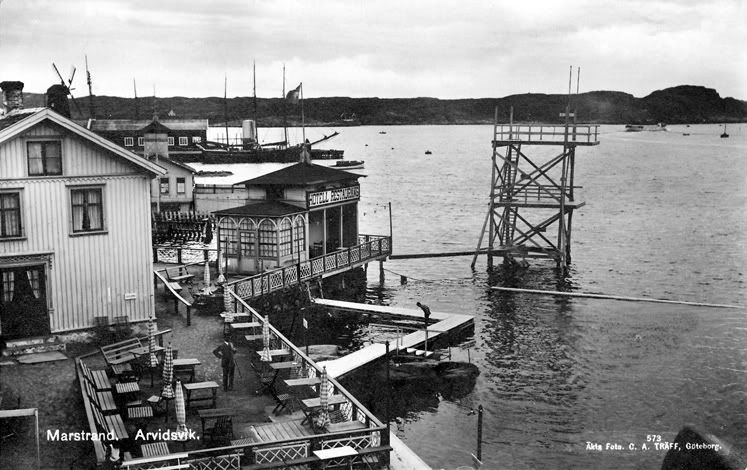
“The talk was of war, war, war, and more war! It was really scary. We did not feel safe at all any more,” said Greta. “Mama was so worried that she had trouble sleeping at night.”
Word came through the American Consulate; all foreigners were ordered to leave. They sent people around to find American citizens to obtain their names and U.S. addresses. Gunhild and Greta were stuck. A distraught Gunhild wrote to Keith suggesting ways to raise money. “The power to return us in in your hands, as soon as you are able to get the money together.”
“Another fifty boats were sunk off our island. Half of them were Swedish. We saw one of the Swedish ships en route to England torpedoed by the Germans before our very eyes as we watched from Carlstens Fortress,” Greta recollected.
It was in the midst of these stressful events when Greta decided to incorporate experimenting with fire into her doll play.
“Grandfather forgot to watch me when I decided to build a bonfire for my dolls. I went into the house looking for something to ignite the wood I had gathered. I rummaged through Mama’s desk and came upon some piles of papers to use. I found matches in the kitchen and walked back up the hill. I placed the dolls in position around the place where I lit the fire.
“I had a roaring fire. It illuminated the surrounding trees and hills brightly. I stood for a minute admiring my handiwork when suddenly out of nowhere I was grabbed from behind and lifted into the air. Three men all dressed in brown emerged from I don’t know where. One man quickly extinguished the fire with shovels of dirt. Another man held me tight in his arms. The third man started questioning me. I was so frightened that all I did was wail at the top of my lungs. They took me to Grandfather who quickly sent a man to retrieve my mother who came running as fast as she could. When she saw me she commanded me to be quiet. I stopped wailing at once. She was very stern and angry. ‘Didn’t I know we were close to war? That what I did was dangerous?’ I didn’t dare look at her or raise my head. The men thought I was signaling some one in Norway or Denmark with my fire. They even thought for a moment we were spies. Fortunately the papers were of little importance.”
Matters went from all that to worse when August had a stroke. And it was Christmas time.
“He recovered nicely so we planned something joyous for him to remember.” said Greta. It seemed this would be their last Christmas together, so Gunhild pulled out all the stops in preparing a Christmas feast for the ages.
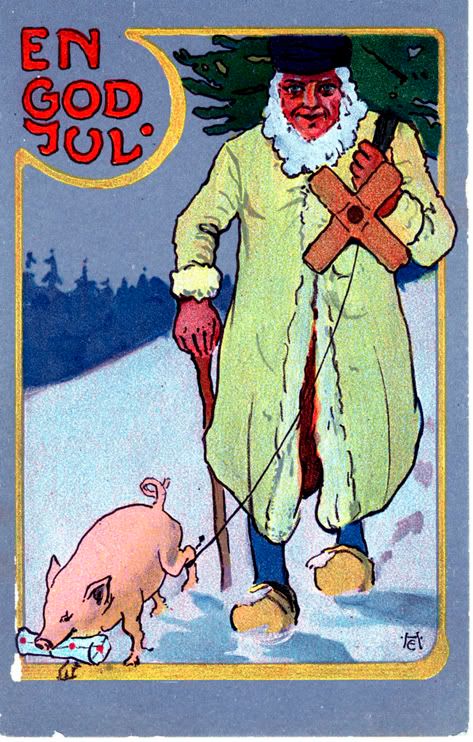
“In spite of all the shortages Mama managed, with her ‘connections,’ to come up with a nice fat goose, a small pig and some fish.”
Gunhild went to work on the goose, plucking the feathers. “Mama was very adept at plucking feathers off of fowl. She had much experience as a girl in Alma’s kitchen. Mama certainly could cook. I was continually amazed at how she could take a little bit of nothing and turn it into a grand feast.”
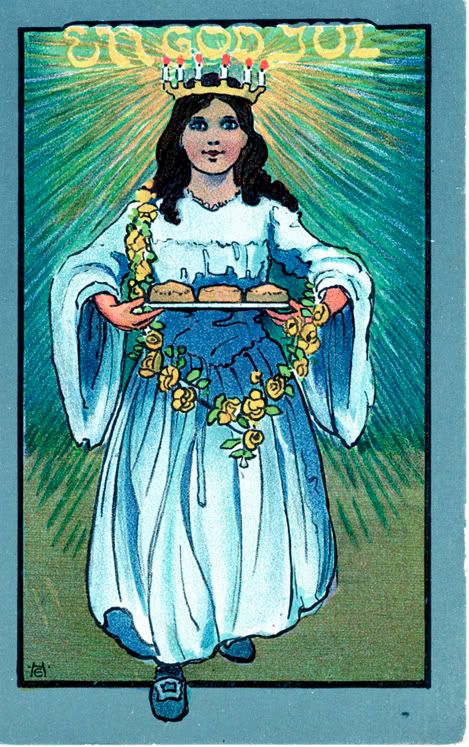
Also on the menu were chestnuts, lingonberries, and rice pudding with rich cream, milk and cinnamon. The pudding contained a single almond which brought luck to the person receiving that serving. There was also a soft fish soaked in brine called lutefisk. It was served with a white sauce seasoned with white pepper.
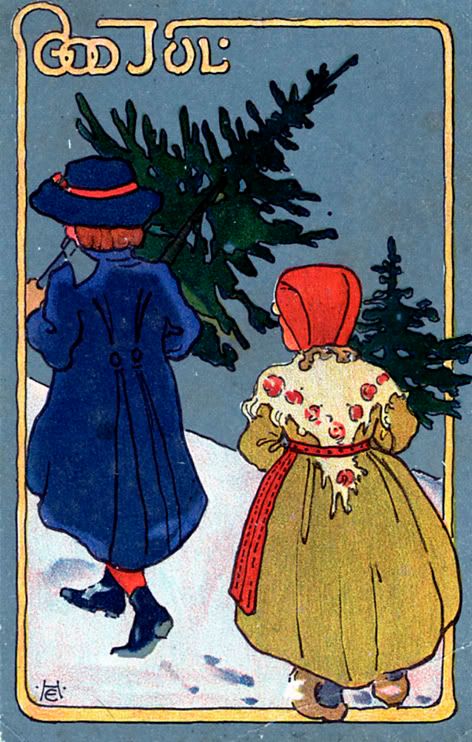
The spread for a grand evening and Christmas Eve dinner was set. “No one had mentioned a Christmas tree, so I never asked about one. I was happy to just be allowed to stay up for the festivities that night.”
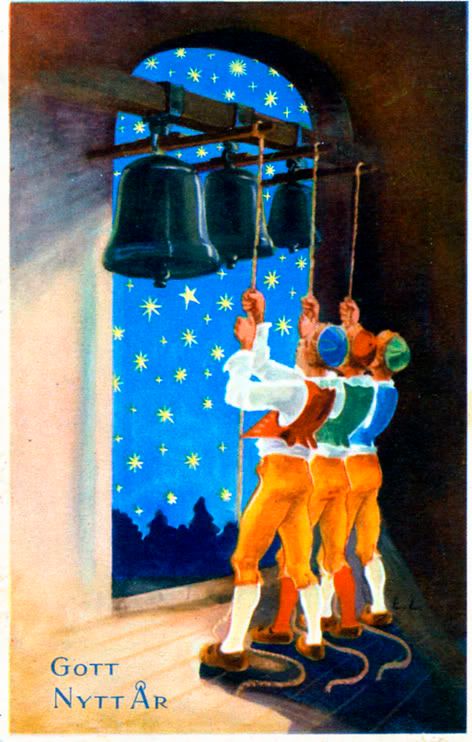
Those festivities began at Marstrand Lutheran Church. In the early darkness of the wintry evening, all dressed in their warmest best church clothes, they descended the long walk way to the street below. There they found a surprise arranged by August. A horse drawn sleigh. The horse was adorned with ribbons and holly. The reins were decorated with jingle bells, which in fact jingled when the horse trotted.
“The church was light and appeared golden inside from soft candlelight. The candles were placed here and there around the sides of the church and from two Christmas trees placed on each side of the altar. This church was never dark like some churches, but it almost seemed celestial that night from its lightness and the airy feeling it gave. The trees were decorated with gold and white ornaments. There were no strings of lights then. Real candles were used. They had an ethereal glow and sent flickering shadows dancing along the wall like Christmas spirits making merry,” said Greta.
“There was a lot of singing and a very uplifting sermon,” noted Gunhild. Greta thought about all the good food back at the house. “I was getting hungry and looking forward to the ride home in the sleigh.”
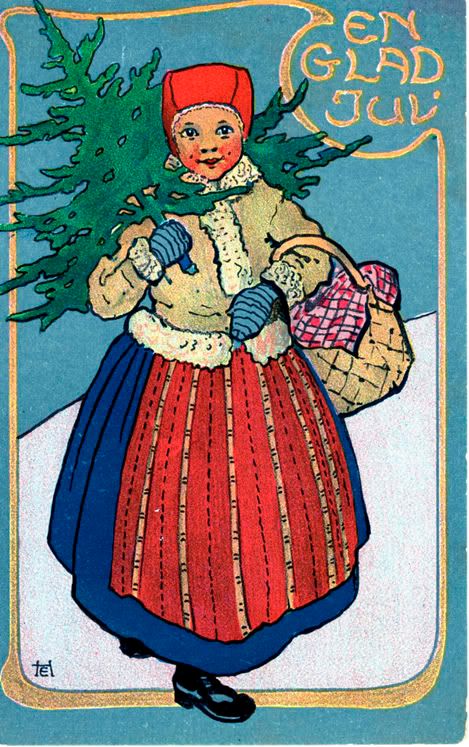
“After church we piled into the sleigh again. Grandfather August picked up the reins and clucked to the horse. When we reached the house we found it very strange to see all the lights burning brightly. Smoke rose from the chimney. I stared in disbelief. Before church there were only two lights on and no fire. After the long walk up to the house the sight upon peeking in the door was of the tallest fattest Christmas tree I had ever seen. It was decorated with ornaments, but mostly with candy. Some were made of marzipan and others with frosting sugar which were shapes and scenes of the Nativity. But most wonderful were the candles! From top to bottom the entire tree was covered with hundreds of small candles in metal holders clipped on.”
Greta pondered how this dramatic transformation was possible. “We were all at church. No one left. And there were dozens and dozens of presents under the tree for everyone. For me there was only one explanation. Santa Claus!
“All of us were together this evening. Mama, Grandfather August, Gunnar and his parents, me, and our closest and most beloved friends and neighbors who were able to be with us. Who knew what the next year would bring. For the time being all thoughts of the impending war were forgotten.”
CHAPTER 10: Blitzkrieg, Blockade, and Escape.
It was customary in Sweden for the Christmas tree to remain up until January 20. Then to have friends over to sing and dance around the tree. “Mama served our favorite kinds of food.” Greta was still busy eating the candy ornaments.
“It has not been this cold in 50 years,” wrote Gunhild. “You can only be outside for about 30 minutes or your face feels like it will crack.” Keith sent them an electric heater he bought at Thrifty’s for $0.98 cents. And a small radio for $9.98. The cheapest radio available in Sweden cost $75.00.
The heater was put to use promptly. Before, their room at night was so cold they used every blanket in the house. Still they shivered. Hot water bottles were useless as they cooled quickly. Then it was too cold to get up and fix new ones.
“In the morning we were tired from the weight of blankets on our bodies.”
They listened to the new radio a lot. Besides Swedish radio Germany, Russia and England came in. Russia offered mainly church and prayer programs. From Germany it was all “marches and noise.”
Marstrand was solidly frozen in. Arrival and departure of goods and services came by horses and sleds. People traveled to and from Marstrand and Goteborg on ice skates. By Greta’s 6th birthday in February she handled both skis and skates competently.
Since November Sweden’s neighbor to the north, Finland, was at war with invading Soviet Union. Stalin and his generals had not anticipated the fight on their hands. Although Sweden and Finland had strong ties, Sweden did not veer from their strict neutral policy. Assistance was not provided. She did however nurture a citizen’s volunteer effort for Finland. At least 10,000 Swedes felt compelled to join Finnish forces.
Besides volunteering for The Red Cross, Gunhild was among the many women working for the Finnish cause by knitting. About the fight in Finland “They are the good guys; our heroes.” She thought if the Finns made it, Russia would leave Sweden alone.
There was wisdom in that thought. Sweden carefully and alertly positioned herself to be the worst possible headache for any invading nation by diligently building up the strongest defenses of all Scandinavian nations. That Finland proved to be a bitter pill for Stalin was noted by the world. Sweden was prepared to be a whole lot more trouble.
“They are now torpedoing and sinking almost all ships that venture into this area,” wrote Gunhild. People commented among themselves “If its not the torpedoes that get them, then the icebergs will.”
A war time atmosphere wasn’t helping Grandfather August. He was laid up and lame for over two weeks by another “mild” stroke. He didn’t look well as Gunhild helped with his shoes and socks every morning.
Still, their suitcases were packed and ready. But with month after month passing in wait, the cases had to be packed and repacked according to seasonal needs.
Stateside Keith was busy locating an available liner. In April 1940 he reserved one. He forwarded tickets to Gunhild along with $40.00 in cash. She was desperate to get $75. Food alone cost $35; other expenses seemed inevitable. All funds at this point were borrowed. Undoubtedly, Keith tapped every resource he knew.
Hitler had other ideas about ship traffic. On April 9th Germany invaded Denmark and Norway. A naval blockade was in effect. Göteborg was a port that lay motionless with a glut of docked ships.
There was a complete break in communications. Keith wasn’t sure if Gunhild departed or not. With no idea where his family was or what happened to them, he contacted the U.S. State department.
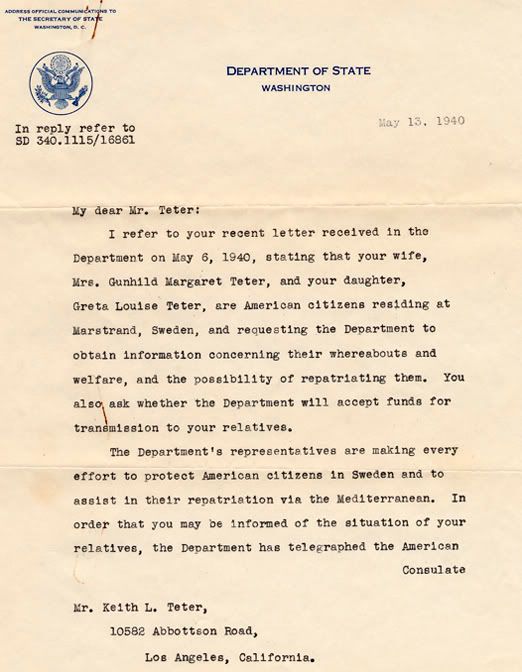
The federal government took up the job of repatriating the many U.S. citizens caught in the war. This project partly came under the hand of President Franklin D. Roosevelt when he offered safe harbor to Norway’s Royal Family. The ship assigned for that mission may well have been the last chance out.
“One very early morning in July, (it was still dark) two men came quietly to our house and rapped softly on the door. Mama, who wasn’t sleeping well, heard the knock first. Throwing on her bathrobe, she hurried to the door and carefully peeked out. A man’s deep voice cautioned us to be very quiet and not to turn on any lights. We were to dress quickly and come with them as soon as possible. ‘Take only the barest of necessities,” the other man advised us. We had already said most of our goodbyes to Grandfather in the last several weeks. We were very sad he refused to come with us. No amount of cajoling would change his mind. ‘I am too old,’ he told us. ‘I must stay with my country.’ He knew we would be leaving at a moment’s notice any day. I was wearing a gold cross he had just given me and I dressed very quickly by myself. I put on a new pair of rainbow-colored canvas shoes with a small buckle on the side. I had some trouble snapping the buckle as they were still stiff and new. (Mama let me choose them myself in a weak moment). We were only allowed to carry the small valises we had packed earlier containing underwear, a nightgown, a couple of changes of clothes and toiletries. Mama cut out of its frame a canvas painting of some fishing boats that a friend, Ingeborg, had painted. She rolled it up and tied it under my coat around my waist to take with us.”
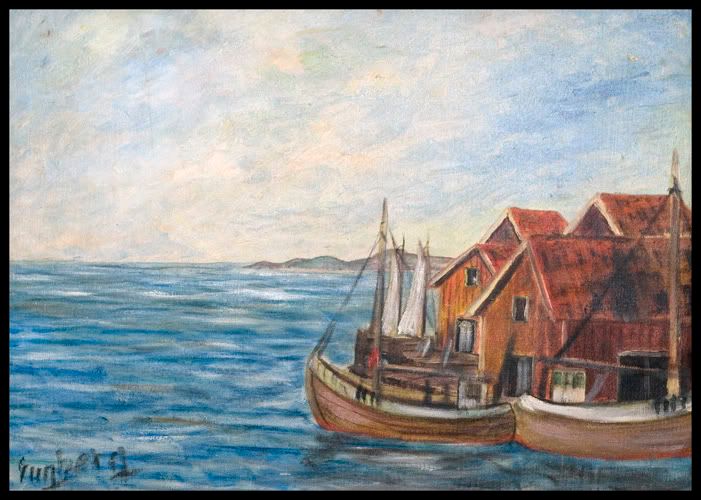
“It seemed forever, but in reality it was only a matter of minutes and we were ready to depart. We hastily kissed Grandfather August goodbye one last time. With tears in our eyes we turned to go. Mama knew she would never see her father again.
“The two men escorted us to the water in the dark. A small row boat was tied to the wharf. We climbed aboard with one of the men. He rowed us across the water toward the other side of the bay. We turned around to see our home on the hill where we had lived for the last two years and thinking about Grandfather inside. I wondered if he was looking out the window for us as we rowed.”
The plan was to reach the port of Petsamo, Finland, which was still open to neutral passage. The U.S. army ship American Legion awaited the refugees. But the trip there was difficult and dangerous. It was made mostly under the cover of darkness through the war zone. Secrecy and quiet was the utmost of importance.
“We took at least two small boats, a train, and a small bus. From the bus I remember seeing small burned and smoldering villages or towns. Bodies of people and animals were here and there. Some were burned. Some just lying on the cold ground. Mama told me not to look but I peeked anyway. At times we traveled at night on a bus or train. Other times we spent safely away in caves or underground passages. We had to sleep sitting up because the quarters were so small and cramped. There must have been fifteen or twenty of us fleeing. There were various nationalities, adults, and children. It was imperative the children not squeal, cry or make noise of any kind whatsoever. I slept with my head in Mama’s lap. I don’t think she slept much at all during this trip.
“At our final stop on land which was along the shore line, we had to wait a couple of days for our ‘connection’ to Petsamo.
“While waiting we saw four German troop transport ships sunk by the British.
“Every morning I had trouble buckling my beautiful new shoes. First because they were new. Secondly because I slept in such a cramped position my feet were swollen. When the day finally came and we had to move quickly so as not to be discovered, I was not able to fasten one shoe. Everyone was standing and having to wait as I struggled with my shoe. ‘Just leave her here!’ a grumpy man growled. Mama grabbed me by the arm and pushed me onto the bus. I held my shoe on by my toes and clumped along.
“We arrived at a tiny fishing boat. It was a long way down below the wharf. We had to descend on a tall rickety old wooden ladder. Most of the children were small enough to be carried, but I had to climb down by myself. The rungs of the ladder were very far apart for my little legs to reach. I didn’t dare whimper, but I was afraid I might fall into the ocean and they would leave without me.
“Mama was on board before me and was reaching up to help when suddenly my shoe went tumbling into the ocean. I wanted to cry, but I didn’t dare make a sound. I bit my lip and continued down the ladder and into Mama’s arms. “Don’t cry, she said, “We will find you other pretty shoes in America.”
“It didn’t take us long to reach the army transport ship American Legion.”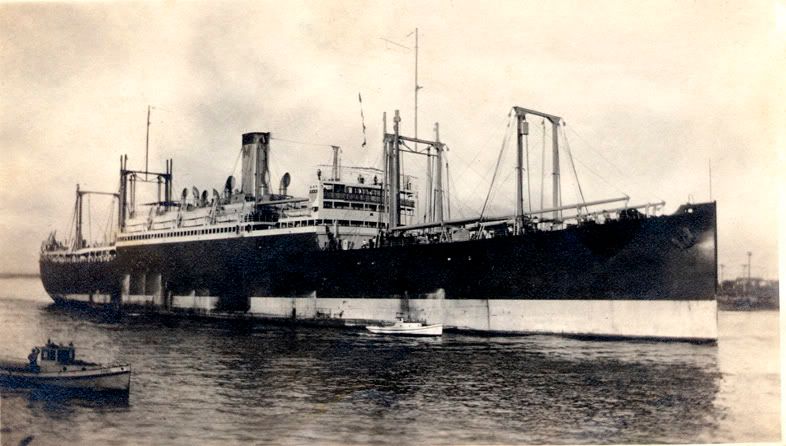
If Hitler only knew. Hidden on board the American Legion, Sweden sent along a 40mm Bofors anti-aircraft gun mounting which became the prototype for thousands of such guns built for the U.S. Navy during World War II.
From the time Gunhild first had obtained passage to this moment this short list of events transpired.
May 15, Holland surrendered to Germany. May 28, Belgium surrendered to Germany. June 3rd, Norway surrendered to Germany. June 14, German troops marched through Paris.
“I don’t remember exactly when we set sail for America, but it was few days after July 28, 1940.”
By August 8th, the Battle for Britain began. This meant The American Legion was headed though areas mined by Germany in her blockade of Britain. The U.S. was still a declared neutral and expected safe passage under international rules. But Hitler repeatedly demonstrated his regard for international law long ago. This was at best a risky voyage.
Norway’s Crown Princess Martha’s children were among the playmates Greta encountered on board. “I was permitted to play with the young prince from time to time. I believe he was a year younger than I.”
“There were many people on board fleeing Europe. About 897 of them were American citizens. There were no more children’s life jackets so mine was adult size. It hung down nearly to my ankles. It was overcrowded with people. Some had to share beds. Mama and I were fortunate. We had our own room with bunk beds. I slept on top and when the ocean became rough, I usually awoke on the floor the next morning.
“We had to attend life boat drills twice a day. A double lookout was on duty 24 hours a day and the captain himself spent many a 24 hour stint on bridge until we passed the mine fields. We had lessons in “plane spotting,” identifying the various insignias on the planes which were constantly flying over us. When we saw an enemy plane we were told to fall flat on the deck where ever we were. The children became very adept at it and it became a game to see who could go down the fastest.
“The Germans radioed continuous mine warnings. Then some really bad weather lasted 3 days. Since we had limited freight, the ship bobbed up and down like a cork. I remember seeing huge walls of water taller than the ship on each side of us as we dropped down only to suddenly shoot back up again. Many people were seasick. The infirmary was so crowded there were often two people in a bed. We all had typhoid injections which also made people sick. Mama was one of them. She was in the infirmary for many days. I believed she didn’t care one way or another if she lived or died. She hardly responded when I came to visit. I wandered the ship alone for several days exploring here and there. One day a black man who worked in the kitchen saw me wandering around inquired what I was doing there all alone. I told him about my mother being ill. He asked me if I had been eating regularly, which I hadn’t. I told him I had eaten some peanuts earlier but that was all. Every day until Mama was well, he searched me out and brought food.
An incident arose on board that perhaps predicted the scene in Humphrey Bogart’s Casablanca where groups of German soldiers singing were drowned out by French voices at Rick’s Cafe. “A group of Nazis and Norwegians on board got into a heated situation which was skillfully handled by Captain Torning. He simply told them to behave or he wouldn’t allow them to land in the United States.”
It was raining that day of August 28, 1940 as the American Legion entered New York harbor. “When people saw the Statue of Liberty they came out on deck to cry and laugh, and to cry and laugh some more. A record of the Star Spangled Banner was played; all the Americans began to sing. As we walked down the gangplank and went ashore, hundreds of passengers got on their knees to kiss the ground.”

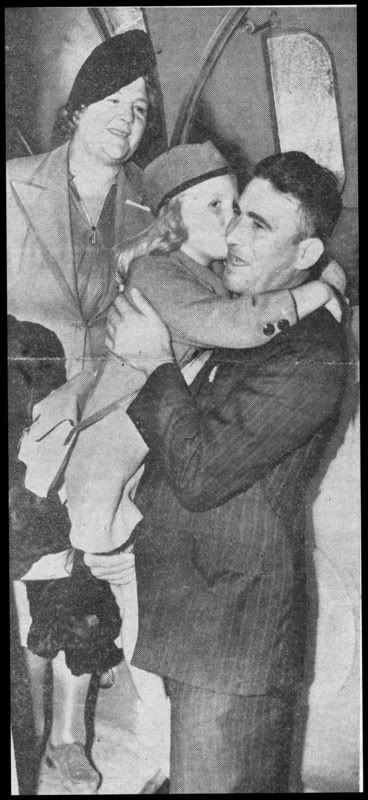

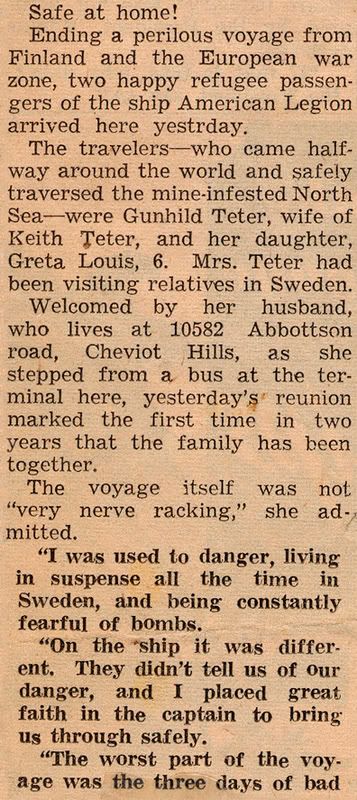
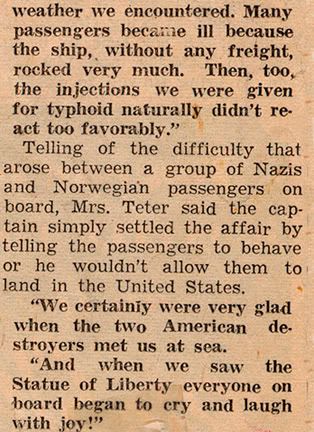

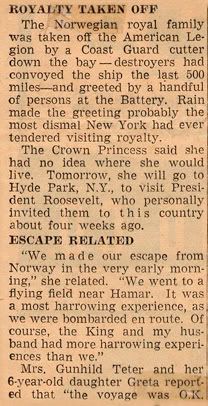
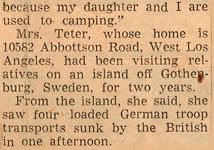
“Home at Last! Mama continued being interviewed by various newspapers for days after.
“I had to relearn English. I couldn’t understand a word my cousins were saying to me at our first family reunion celebrating our homecoming. I started school that same Fall, I still couldn’t speak English very well. It soon came back to me with the help of my very patient teacher, Mrs. Repath.”
Greta had a dream to return to Marstrand one day. However raising 4 children, working and dealing with the day to day that stretched into years and decades, that dream was always elusive.
In 2005 Greta proposed the idea of going to Sweden and Marstrand to her nephews, Sam and myself–sons of Bill, Greta’s older brother. In May and June of 2006 we made that trip.
CHAPTER 11: Marstrand Return and Reunion.
June 2006. Greta immediately recognized the rocky geography. Her bus window view was from the road between Göteborg and Marstrand. A road that was still under construction during her first trip to Marstrand. Her arrival then was by ferry. With the familiar silhouette of Carlstens Fortress on the horizon Greta was nearly “home.” Once upon the cobblestone streets, there was no hesitation about the familiar way to the old house of August and Alma Palm. Stepping to the veranda she pointed to a window. A room where the Christmas tree once stood. She remembered the rustic kitchen and the relic of a stove her mother created meals upon. She looked out from the veranda on a peaceful Marstrand harbor and remembered fishing with Grandfather August. She recalled the sight of ships at battle.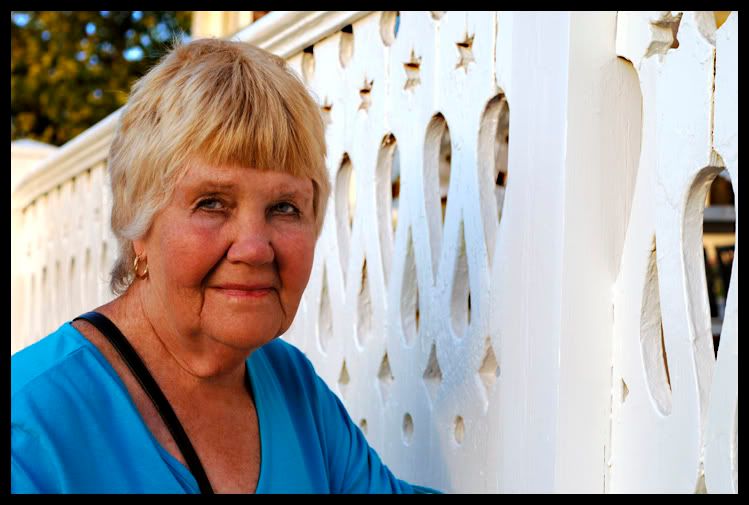

Greta on the veranda, 2006 (left). On the veranda 1939 (right). From right to left, Greta, Gunnar, Gunhild, & friend.
Question remained if she would find anyone she remembered. Or if anyone was still around that remembered her, her mother and grandparents. Or if there was even a chance of finding relatives.
Our Innkeepers were Lena and Gunnar Danielsson at Korsgatan 5 in Marstrand. When they heard Greta’s story, they were very interested and became actively involved. After a few phone calls they offered Greta a pleasant surprise.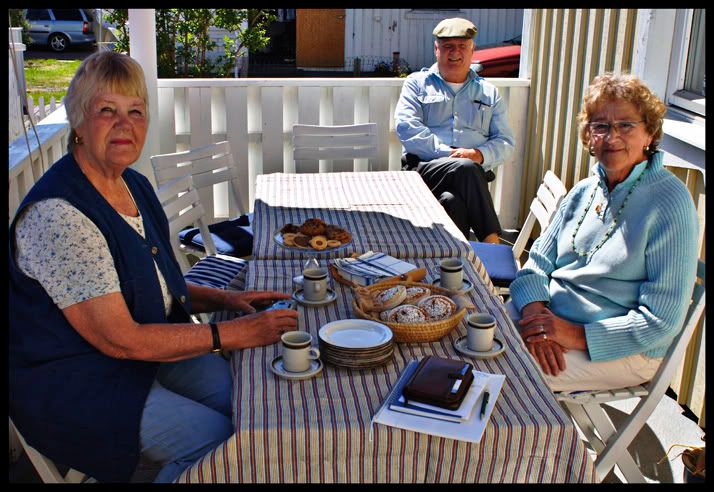
Lena Danielsson located one of Greta’s old Marstrand friends Karin. Lena invited Karin to Korsgatan 5 for coffee and coffee bread. Karin remembered the “American girl was allowed to have painted nails.” Sam Soderberg, center.
More surprises were in store. The next came via a short boat ride.
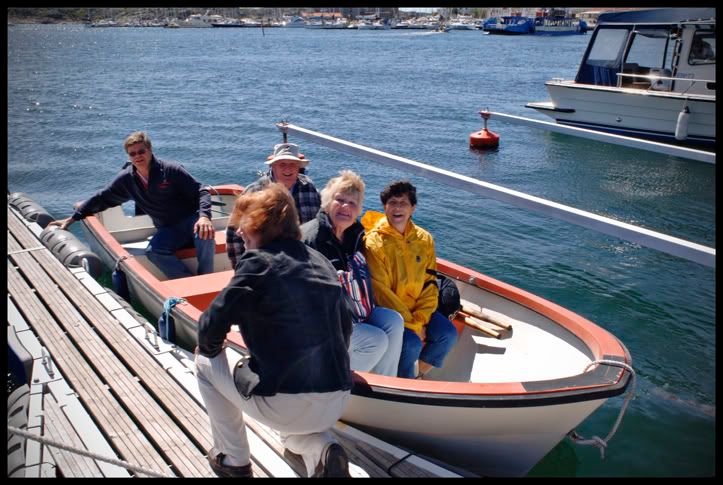
It is about right to say the Marstrand experience is incomplete without a boat ride, not counting the ferry. Gunnar Danielsson at the helm. Lena Danielsson at the rope. Sam Soderberg with floppy hat. Greta. And Sam’s wife Ruby.
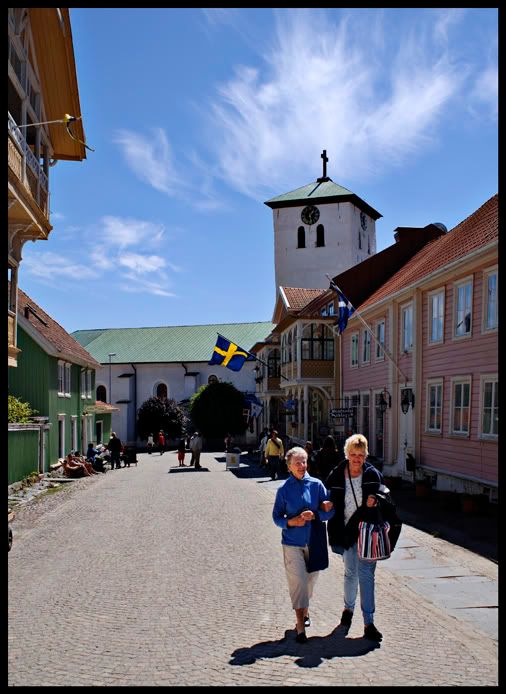
Walking down memory lane, Greta meets with Ingrid, her second rediscovered friend.
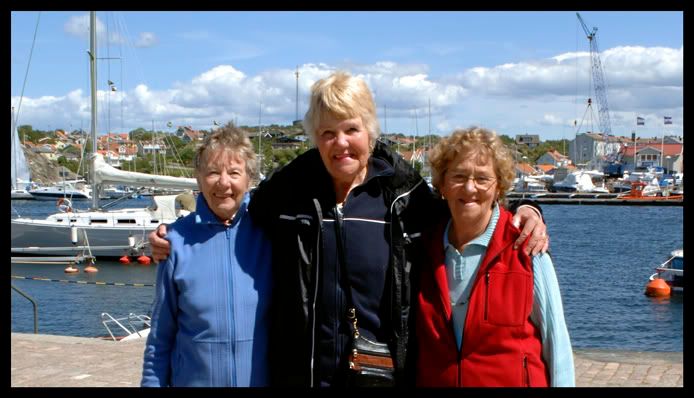
A reunion sixty six years in the making. Ingrid, Greta, and Karin.
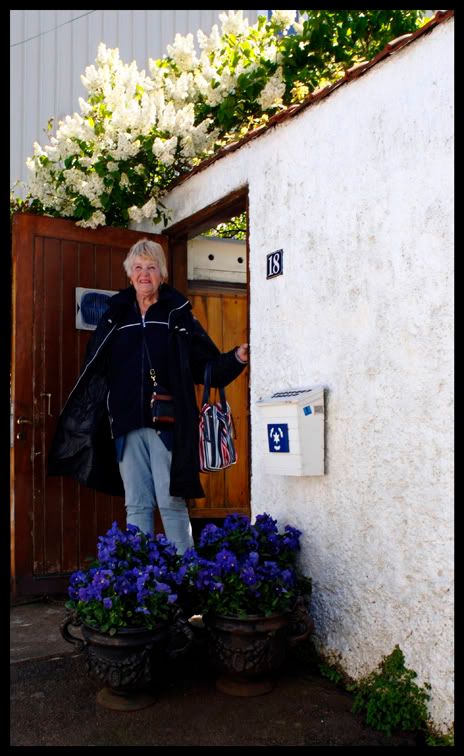
There were more happy meetings for Greta behind this door.
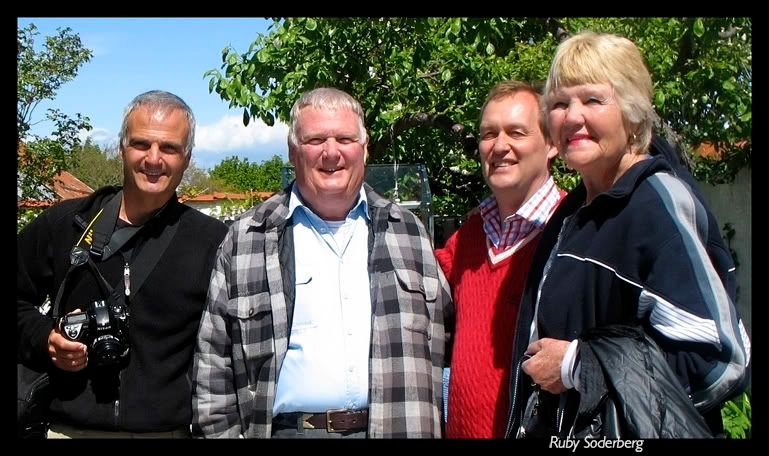
Dan and Sam with Swedish third cousin Anke, Greta’s second cousin. The three third cousins share the same great grandparents, August and Alma Palm. Anke’s grandmother is Margit, Gunhild’s sister. This is at the patio area of Anke’s home in Marstrand. He operates an antique business in Göteborg.

Ingrid, center, is a curator at Marstrand’s History Museum. She opened the doors for us. We studied the displays and learned from her expertise. Greta, and Gunnar Danielsson look on as Ruby asks questions.
Another priority of our Marstrand stay was to locate the grave site of August, Alma and Algot Fredrik.

We walked and walked through the small cemetery in search of the family grave marker. It seemed every stone was looked at repeatedly. No matter how often the same markers came into view, the names August, Alma Katarina Palm, and Algot Fredrik were not there. A pile of discarded grave stones were set to the side. We happened to see the Marstrand Lutheran Church Vicar nearby attending to a site. He couldn’t recall ever seeing the name Palm. Then explained unmaintained or abandoned sites are made available as new plots. “Space is limited here.” The old stones are set aside or carved over to mark more recent burials.
From nearby trees the “cuckoo” of cuckoo birds seemed to herald our departure and unsuccessful quest. We were just past the cemetery gates when a woman called out.
“Did you say you were looking for August Palm? It’s right here.”
One sensed Greta’s relief. I imagined the trip would have felt somewhat incomplete if the grave site had not been found.
Perhaps we didn’t look as closely for a horizontal or flat gravestone. Most were the upright markers.
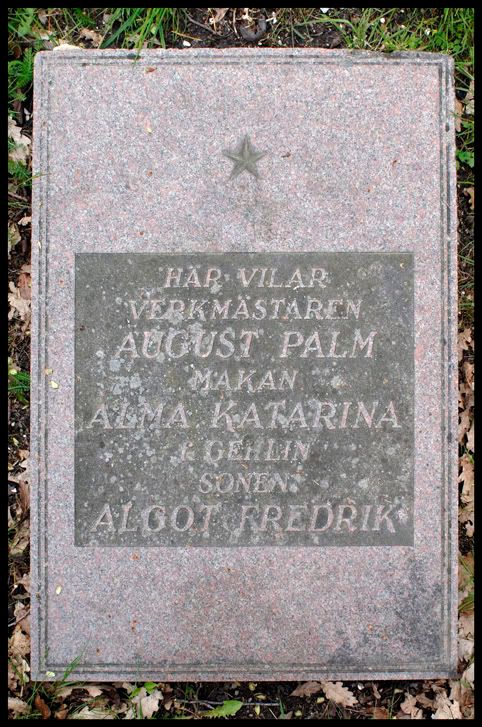
We made a second visit later. Greta bought some petite roses to plant at the site. “Mama would want that.”
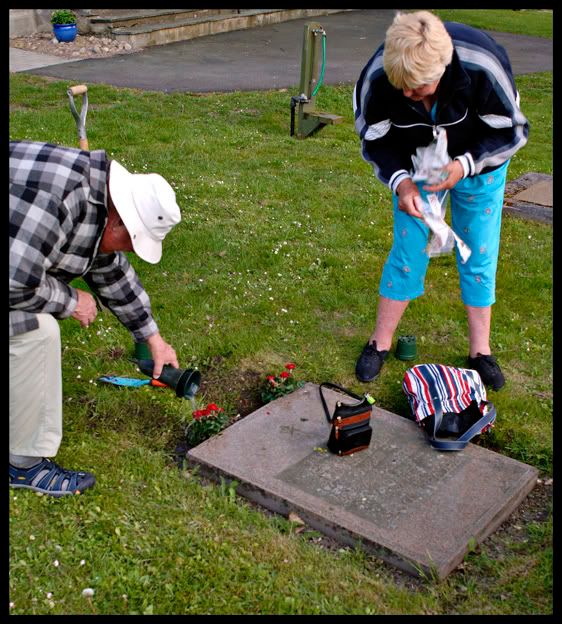
Sam adding a cup of water to Greta’s freshly planted roses.
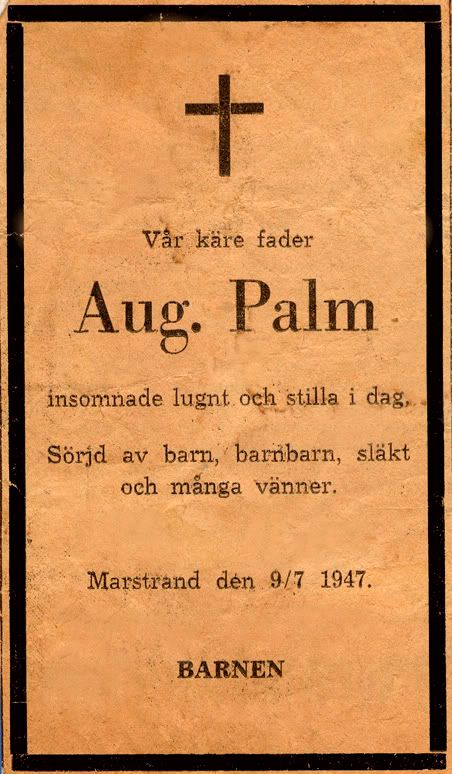
August passed away in 1947
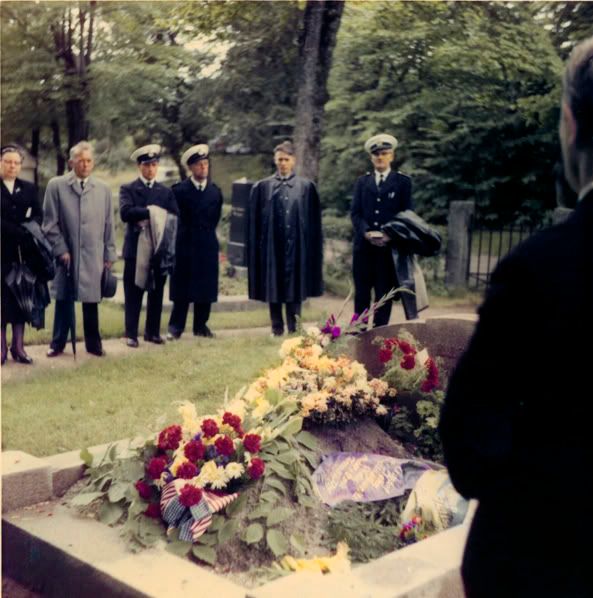
Grave yard service for August. We noted the flowers tied together with U.S. Flag ribbon. We imagine Gunhild sent those.
The Watch and The Broach.
“It was on a lazy afternoon in the summer of 1939. Mama’s work was done at the house and we went swimming. I swam and played for several hours when she decided I should come out and rest a bit. While Mama dozed in the sun I explored the rocks and crevices. Deep in one of those crevices I saw something shiny. It was very far down and I had to lie on the rock very flat. I reached my arm down and stretched as far as I could. I barely managed to touch it with the tip of my fingers. I couldn’t quite pick it up. I held my breath, lunged as far as I could, and managed finally to lift the object between my outstretched fingers. Gingerly, carefully, I pulled the object up against the rough rock surface. To my surprise it was a beautiful gold watch. I ran to my mother holding out my treasure.”
Gunhild was even more surprised because she recognized the watch.
“‘I know whose watch that is, Greta. We must find Mrs. Ambjornson and return it. She will be very sad when she realizes she has lost it.'”
Mrs. Ambjornson in fact had tears upon seeing it. “My husband gave this watch to me on our wedding day. I have always cherished it and now he is gone.” He drowned a few years ago when a storm caught hold of his sail boat. “It is the most precious memory I have of him. It is worth more than money to me.”
Mrs. Ambjornson rewarded Greta with a trip to a jewelery store. Greta chose a simple porcelain brooch with a carved picture of blue water, blue sky with white fluffy clouds, and a sail boat on it.
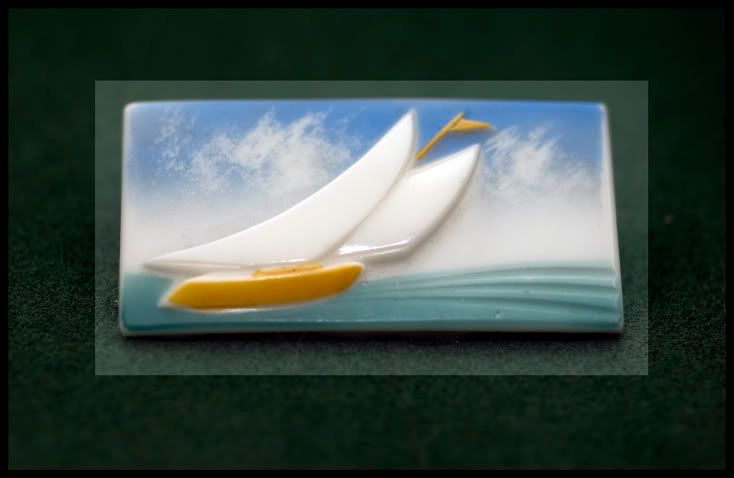
“To me this was Marstrand. The water I loved to swim and sail upon. The open sea and the wind blowing through my hair. With this pin I always remember the best things I love about Marstrand and how it was.”
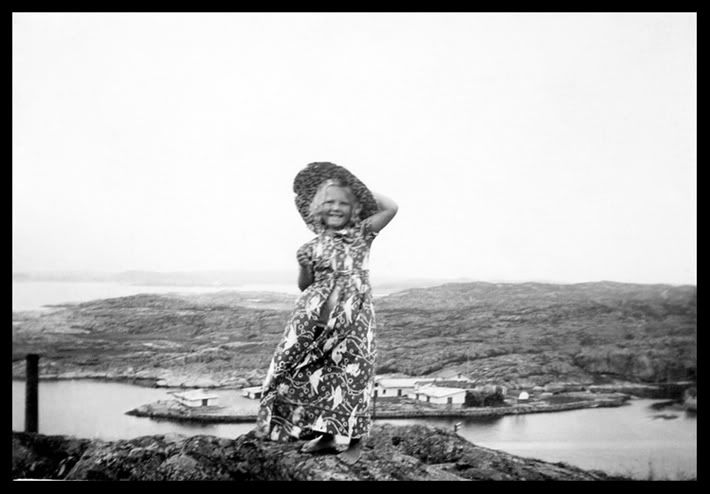
“Under Mama’s protection my childhood cares were few. Life was a party; a new and exciting experience every day. I greeted each new day with excited anticipation.”

The End.
acknowledgment
Greta Louise Teter Smith for unrestricted access to her personal history on Marstrand and to Gunhild’s letters. Also for opening the family photo album and answering a myriad of questions over the past few years.
Ruby Soderberg, additional photography
Mark Wagner, permission to use images of The Gripsholm
Gunnar and Lena Danielsson, for all their help not only in providing a top notch Bed and Breakfast Inn in Marstrand, but for all the attention given to making Greta’s return so memorable.
Korsgatan 5 SE 44030 Marstrand, Sweden. Tel +46 (0)303-14827 Fax +46 (0) 303-64807
3 COMMENTS
Hello! I found your page when I googled for pictures of Marstrand in the old days, as my ancestors lived there, just like yours. I have been doing some searching in the old church books for my ancestors and I think it is great fun.
I liked to see the picture of what is now Bergs konditori. That house was built for my grandfather´s uncle Alfred and his wife Annie.
Alfred was among other things the organ player in church, but died young. Annie wanted to take over the job to be able to support her son and herself, but the church council wanted a MAN. After some fuss she got the job, but was angry, and when she died left everything she owned to a women liberation association. This is how the house left the family, or so the family tradition goes!
Now to the story I was going to tell you about electricity. It has quite a lot to do with the US as you will discover.
My grandfather´s grandfather Carl Magnus moved to Marstrand with his wife in 1847 to be “chief light house keeper” The light house was then at the top of the castle. They had 10 kids, Alfred and my great grandfather Johan Ludvig being two of them. A third one was Theodor, an adventurous engineer who went to the US to work with Edison. When I was in Marstrand I was even told he helped with inventing the light bulb.”Edison invented the bulb, but it was Theodor´s idea to pump out the air, thus making the thread last longer,” so they said.
Theodor was later sent to Sweden to spread the use of electricity, and he succeded quite well. He got the job of wiring the Royal Castle. (Ironically another sibling of his, his sister Laura was making her living in Stockholm selling kerosene lamps)
No wonder that Marstand was having electricity early, and the lamps in the harbour made it easy to unload the herring from the fishing boats.
Theodore married an american women, Ellen Stevens when still in the US and took her to Klondyke to look for gold. They even had an own mining company, but not much money came out of it.
At the end of his life Theodore returned to Marstrand with his wife, but after he died she finally went back to the States around 1930. So you see an american lady had lived in Marstrand before Gunhild came back as one.
I also found a wedding notation 15 nov 1919 for Gunhild and Palm and Gustav Helge Soderberg in Marstrand. The ceremony seems to have taken place elsewhere though.
There are lots and lots af records like this to look at, and your family seems pretty easy to find.
Do you know Palm is a soldier´s name and that you from the records can tell what their names were before being a soldier how tall they were ,
where they served etc.?
I have a few soldiers in my own family, as have many swedes since the system we had was so wide spread. The farmers had to pay according to the size of their farm to keep a soldier in a little cottage, with some land to it, The soldier would live and farm there whenever he was not a soldier.
It should be possible to find out more, would you like to?
Sincerely,
Berit Hären, Stockholm
berit@pramborg.se
Great stuff. I visited again today. Fascinating. Beautiful photos.